Netgear orporated 05300023 54 Mbps ADSL Modem Wireless Router User Manual fullmanual
Netgear Incorporated 54 Mbps ADSL Modem Wireless Router fullmanual
Contents
- 1. Manual Part 1
- 2. Manual Part 2
Manual Part 1

202-10155-01
January 2006
NETGEAR, Inc.
4500 Great America Parkway
Santa Clara, CA 95054 USA
Reference Manual for the
54 Mbps ADSL Modem
Wireless Router Model DG834G

ii
v1.0, January 2006
© 2006 by NETGEAR, Inc. All rights reserved.
Trademarks
NETGEAR is a trademark of Netgear, Inc.
Microsoft, Windows, and Windows NT are registered trademarks of Microsoft Corporation.
Other brand and product names are registered trademarks or trademarks of their respective holders.
Statement of Conditions
In the interest of improving internal design, operational function, and/or reliability, NETGEAR reserves the right to
make changes to the products described in this document without notice.
NETGEAR does not assume any liability that may occur due to the use or application of the product(s) or circuit
layout(s) described herein.
Federal Communications Commission (FCC) Compliance Notice: Radio Frequency Notice
This equipment has been tested and found to comply with the limits for a Class B digital device, pursuant to
part 15 of the FCC Rules. These limits are designed to provide reasonable protection against harmful interference in a
residential installation. This equipment generates, uses, and can radiate radio frequency energy and, if not installed and
used in accordance with the instructions, may cause harmful interference to radio communications. However, there is no
guarantee that interference will not occur in a particular installation. If this equipment does cause harmful interference to
radio or television reception, which can be determined by turning the equipment off and on, the user is encouraged to try
to correct the interference by one or more of the following measures:
• Reorient or relocate the receiving antenna.
• Increase the separation between the equipment and receiver.
• Connect the equipment into an outlet on a circuit different from that to which the receiver is connected.
• Consult the dealer or an experienced radio/TV technician for help.
Federal Communications Commission (FCC) Radiation Exposure Statement
This equipment complies with FCC RF radiation exposure limits set forth for an uncontrolled environment.
This equipment should be installed and operated with a minimum distance of 20 centimeters between the
radiator and your body. This device complies with Part 15 of the FCC Rules.
Operation is subject to the following two conditions:
(1) This device may not cause harmful interference, and
(2) This device must accept any interference received, including interference that may cause undesired operation.
This transmitter must not be co-located or operating in conjunction with any other antenna or transmitter.
The antennas used for this transmitter must be installed to provide a separation distance of at least 20 cm from all
persons and must not be co-located or operating in conjunction with any other antenna or transmitter.

v1.0, January 2006
iii
European Union Statement of Compliance
Hereby, NETGEAR, Inc. declares that this modem router is in compliance with the essential requirements and other
relevant provisions of Directive 1999/5/EC.
Èesky
[Czech] NETGEAR, Inc. tímto prohlašuje, že tento 54 Mbps ADSL Modem Wireless Router
Model DG834G je ve shodì se základními požadavky a dalšími pøíslušnými
ustanoveními smìrnice 1999/5/ES.
Dansk
[Danish] Undertegnede NETGEAR, Inc. erklærer herved, at følgende udstyr 54 Mbps ADSL
Modem Wireless Router Model DG834G overholder de væsentlige krav og øvrige
relevante krav i direktiv 1999/5/EF.
Deutsch
[German] Hiermit erklärt NETGEAR, Inc., dass sich das Gerät 54 Mbps ADSL Modem Wireless
Router Model DG834G in Übereinstimmung mit den grundlegenden Anforderungen und
den übrigen einschlägigen Bestimmungen der Richtlinie 1999/5/EG befindet.
Eesti
[Estonian] Käesolevaga kinnitab NETGEAR, Inc. seadme 54 Mbps ADSL Modem Wireless Router
Model DG834G vastavust direktiivi 1999/5/EÜ põhinõuetele ja nimetatud direktiivist
tulenevatele teistele asjakohastele sätetele.
English Hereby, NETGEAR, Inc., declares that this 54 Mbps ADSL Modem Wireless Router
Model DG834G is in compliance with the essential requirements and other relevant
provisions of Directive 1999/5/EC.
Español
[Spanish] Por medio de la presente NETGEAR, Inc. declara que el 54 Mbps ADSL Modem
Wireless Router Model DG834G cumple con los requisitos esenciales y cualesquiera
otras disposiciones aplicables o exigibles de la Directiva 1999/5/CE.
Ελληνική
[Greek] ΜΕ ΤΗΝ ΠΑΡΟΥΣΑ NETGEAR, Inc. ∆ΗΛΩΝΕΙ ΟΤΙ 54 Mbps ADSL Modem Wireless
Router Model DG834G ΣΥΜΜΟΡΦΩΝΕΤΑΙ ΠΡΟΣ ΤΙΣ ΟΥΣΙΩ∆ΕΙΣ ΑΠΑΙΤΗΣΕΙΣ ΚΑΙ
ΤΙΣ ΛΟΙΠΕΣ ΣΧΕΤΙΚΕΣ ∆ΙΑΤΑΞΕΙΣ ΤΗΣ Ο∆ΗΓΙΑΣ 1999/5/ΕΚ.
Français
[French] Par la présente NETGEAR, Inc. déclare que l'appareil 54 Mbps ADSL Modem Wireless
Router Model DG834G est conforme aux exigences essentielles et aux autres
dispositions pertinentes de la directive 1999/5/CE.
Italiano
[Italian] Con la presente NETGEAR, Inc. dichiara che questo 54 Mbps ADSL Modem Wireless
Router Model DG834G è conforme ai requisiti essenziali ed alle altre disposizioni
pertinenti stabilite dalla direttiva 1999/5/CE.
Latviski
[Latvian] Ar šo NETGEAR, Inc. deklarç, ka 54 Mbps ADSL Modem Wireless Router Model
DG834G atbilst Direktîvas 1999/5/EK bûtiskajâm prasîbâm un citiem ar to saistîtajiem
noteikumiem.
Lietuviø
[Lithuanian] Šiuo NETGEAR, Inc. deklaruoja, kad šis 54 Mbps ADSL Modem Wireless Router
Model DG834G atitinka esminius reikalavimus ir kitas 1999/5/EB Direktyvos nuostatas.

v1.0, January 2006
iv
A printed copy of the EU Declaration of Conformity certificate for this product is provided in the DG834G
v3 product package.
Bestätigung des Herstellers/Importeurs
Es wird hiermit bestätigt, daß das 54 Mbps ADSL Modem Wireless Router Model DG834G gemäß der im BMPT-
AmtsblVfg 243/1991 und Vfg 46/1992 aufgeführten Bestimmungen entstört ist. Das vorschriftsmäßige Betreiben
einiger Geräte (z.B. Testsender) kann jedoch gewissen Beschränkungen unterliegen. Lesen Sie dazu bitte die
Anmerkungen in der Betriebsanleitung.
Das Bundesamt für Zulassungen in der Telekommunikation wurde davon unterrichtet, daß dieses Gerät auf den Markt
gebracht wurde und es ist berechtigt, die Serie auf die Erfüllung der Vorschriften hin zu überprüfen.
Nederlands
[Dutch] Hierbij verklaart NETGEAR, Inc. dat het toestel 54 Mbps ADSL Modem Wireless Router
Model DG834G in overeenstemming is met de essentiële eisen en de andere relevante
bepalingen van richtlijn 1999/5/EG.
Malti
[Maltese] Hawnhekk, NETGEAR, Inc., jiddikjara li dan 54 Mbps ADSL Modem Wireless Router
Model DG834G jikkonforma mal-tiijiet essenzjali u ma provvedimenti orajn relevanti li
hemm fid-Dirrettiva 1999/5/EC.
Magyar
[Hungarian] Alulírott, NETGEAR, Inc. nyilatkozom, hogy a 54 Mbps ADSL Modem Wireless Router
Model DG834G megfelel a vonatkozó alapvetõ követelményeknek és az 1999/5/EC
irányelv egyéb elõírásainak.
Polski
[Polish] Niniejszym NETGEAR, Inc. oœwiadcza, ¿e 54 Mbps ADSL Modem Wireless Router
Model DG834G jest zgodny z zasadniczymi wymogami oraz pozosta³ymi stosownymi
postanowieniami Dyrektywy 1999/5/EC.
Português
[Portuguese] NETGEAR, Inc. declara que este 54 Mbps ADSL Modem Wireless Router Model
DG834G está conforme com os requisitos essenciais e outras disposições da Directiva
1999/5/CE.
Slovensko
[Slovenian] NETGEAR, Inc. izjavlja, da je ta 54 Mbps ADSL Modem Wireless Router Model
DG834G v skladu z bistvenimi zahtevami in ostalimi relevantnimi doloèili direktive 1999/5/
ES.
Slovensky
[Slovak] NETGEAR, Inc. týmto vyhlasuje, že 54 Mbps ADSL Modem Wireless Router Model
DG834G spåòa základné požiadavky a všetky príslušné ustanovenia Smernice 1999/5/
ES.
Suomi
[Finnish] NETGEAR, Inc. vakuuttaa täten että 54 Mbps ADSL Modem Wireless Router Model
DG834G tyyppinen laite on direktiivin 1999/5/EY oleellisten vaatimusten ja sitä koskevien
direktiivin muiden ehtojen mukainen.
Svenska
[Swedish] Härmed intygar NETGEAR, Inc. att denna [utrustningstyp] står I överensstämmelse med
de väsentliga egenskapskrav och övriga relevanta bestämmelser som framgår av direktiv
1999/5/EG.

v1.0, January 2006
v
Certificate of the Manufacturer/Importer
It is hereby certified that the 54 Mbps ADSL Modem Wireless Router Model DG834G has been suppressed
in accordance with the conditions set out in the BMPT-AmtsblVfg 243/1991 and Vfg 46/1992. The operation of some
equipment (for example, test transmitters) in accordance with the regulations may, however, be subject to certain
restrictions. Please refer to the notes in the operating instructions.
Federal Office for Telecommunications Approvals has been notified of the placing of this equipment on the market
and has been granted the right to test the series for compliance with the regulations.
Voluntary Control Council for Interference (VCCI) Statement
This equipment is in the second category (information equipment to be used in a residential area or an adjacent area
thereto) and conforms to the standards set by the Voluntary Control Council for Interference by Data Processing
Equipment and Electronic Office Machines aimed at preventing radio interference in such residential areas.
When used near a radio or TV receiver, it may become the cause of radio interference.
Read instructions for correct handling.
Customer Support
Refer to the Support Information Card that shipped with your 54 Mbps ADSL Modem Wireless Router Model DG834G.
World Wide Web
NETGEAR maintains a World Wide Web home page that you can access at the universal resource locator (URL)
http://www.netgear.com. A direct connection to the Internet and a Web browser such as Internet Explorer or
Netscape are required.
Product and Publication Details
Model Number: DG834G v3
Publication Date: January 2006
Product Family: Modem Router
Product Name: 54 Mbps ADSL Modem Wireless Router Model DG834G
Home or Business Product: Home
Language: English
Publication Part Number: 202-10155-01
Publication Version Number: 1.0

v1.0, January 2006
vi
Channel
The Wireless Channel sets the radio frequency used for communication.
Access Points use a fixed Channel. You can select the Channel used. This allows you to
choose a Channel which provides the least interference and best performance. In the USA
and Canada, 11 channel are available. In the Europe, 1-13 channel are available.
If using multiple Access Points, it is better if adjacent Access Points use different Channels
to reduce interference.
In "Infrastructure" mode, Wireless Stations normally scan all Channels, looking for an Access
Point. If more than one Access Point can be used, the one with the strongest signal is used.
(This can only happen within an ESS.)
If using "Ad-hoc" mode (no Access Point), all Wireless stations should be set to use the
same Channel. However, most Wireless stations will still scan all Channels to see if there
is an existing "Ad-hoc" group they can join.

1
v1.0, January 2006
Contents
Reference Manual for the ADSL Modem Wireless Router DG834G
Chapter 1
About This Manual
Audience, Scope, Conventions, and Formats ................................................................1-1
How to Print this Manual .................................................................................................1-2
Chapter 2
Introduction
About the Modem Router ...............................................................................................2-1
Key Features ..................................................................................................................2-2
A Powerful, True Firewall .........................................................................................2-2
802.11 Standards-based Wireless Networking ........................................................2-3
Easy Installation and Management ..........................................................................2-3
Protocol Support ......................................................................................................2-4
Virtual Private Networking (VPN) .............................................................................2-5
Auto Sensing and Auto Uplink™ LAN Ethernet Connections ..................................2-5
Content Filtering .......................................................................................................2-6
Trend Micro Home Network Security .......................................................................2-6
What’s in the Box? ..........................................................................................................2-7
The Router’s Front Panel .........................................................................................2-8
The Router’s Rear Panel .........................................................................................2-9
Connecting the Router to the Internet ..........................................................................2-10
Chapter 3
Wireless Configuration
Considerations for a Wireless Network ..........................................................................3-1
Observe Performance, Placement, and Range Guidelines .....................................3-1
Implement Appropriate Wireless Security ...............................................................3-2
Understanding Wireless Settings ...................................................................................3-3
How to Set Up and Test Basic Wireless Connectivity ..............................................3-6

2
v1.0, January 2006
How to Restrict Wireless Access to Your Network ...................................................3-7
Choosing WEP Authentication and Security Encryption Methods .........................3-10
How to Configure WEP ..........................................................................................3-12
How to Configure WPA-PSK ..................................................................................3-13
How to Configure WPA-802.1x ..............................................................................3-14
Chapter 4
Protecting Your Network
Protecting Access to Your 54 Mbps ADSL Modem Wireless Router Model DG834G ....4-1
How to Change the Built-In Password .....................................................................4-1
Changing the Administrator Login Timeout ..............................................................4-2
Configuring Basic Firewall Services ...............................................................................4-3
Blocking Keywords, Sites, and Services ..................................................................4-3
How to Block Keywords and Sites ...........................................................................4-3
Firewall Rules .................................................................................................................4-5
Inbound Rules (Port Forwarding) .............................................................................4-6
Outbound Rules (Service Blocking) .........................................................................4-9
Order of Precedence for Rules ..............................................................................4-11
Services ........................................................................................................................4-12
How to Define Services ..........................................................................................4-12
Setting Times and Scheduling Firewall Services ..........................................................4-13
How to Set Your Time Zone ...................................................................................4-13
How to Schedule Firewall Services ........................................................................4-15
Trend Micro Home Network Security ............................................................................4-15
Security Service Settings .......................................................................................4-16
Parental Controls Settings .....................................................................................4-18
Chapter 5
Managing Your Network
Backing Up, Restoring, or Erasing Your Settings ...........................................................5-1
How to Back Up the Configuration to a File .............................................................5-1
How to Restore the Configuration from a File ..........................................................5-2
How to Erase the Configuration ...............................................................................5-2
Upgrading the Modem Router’s Firmware ......................................................................5-2
How to Upgrade the Modem Router Firmware ........................................................5-3
Network Management Information .................................................................................5-4
Viewing Modem Router Status and Usage Statistics ...............................................5-4

3
v1.0, January 2006
Viewing Attached Devices ........................................................................................5-9
Viewing, Selecting, and Saving Logged Information ................................................5-9
Examples of Log Messages ...................................................................................5-12
Enabling Security Event E-mail Notification .................................................................5-13
Running Diagnostic Utilities and Rebooting the Modem Router ...................................5-15
Enabling Remote Management ....................................................................................5-16
Configuring Remote Management .........................................................................5-16
Chapter 6
Advanced Configuration
Configuring Advanced Security ......................................................................................6-1
Setting Up A Default DMZ Server ............................................................................6-2
Connect Automatically, as Required ........................................................................6-3
Disable Port Scan and DOS Protection ...................................................................6-3
Respond to Ping on Internet WAN Port ...................................................................6-4
MTU Size .................................................................................................................6-4
Configuring LAN IP Settings ...........................................................................................6-4
DHCP .......................................................................................................................6-6
How to Configure LAN TCP/IP Settings ...................................................................6-8
Configuring Dynamic DNS .......................................................................................6-9
How to Configure Dynamic DNS ..............................................................................6-9
Using Static Routes ...................................................................................................... 6-11
Static Route Example ............................................................................................. 6-11
How to Configure Static Routes .............................................................................6-12
Universal Plug and Play (UPnP) ...................................................................................6-13
Chapter 7
Virtual Private Networking
Overview of VPN Configuration ......................................................................................7-2
Client-to-Gateway VPN Tunnels ..............................................................................7-2
Gateway-to-Gateway VPN Tunnels .........................................................................7-3
Planning a VPN ..............................................................................................................7-4
VPN Tunnel Configuration ..............................................................................................7-6
How to Set Up a Client-to-Gateway VPN Configuration .................................................7-7
Step 1: Configuring the Client-to-Gateway VPN Tunnel on the DG834G v3 ...........7-7
Step 2: Configuring the NETGEAR ProSafe VPN Client on the Remote PC .........7-12
How to Set Up a Gateway-to-Gateway VPN Configuration ..........................................7-21

4
v1.0, January 2006
VPN Tunnel Control ......................................................................................................7-29
Activating a VPN Tunnel ........................................................................................7-29
Verifying the Status of a VPN Tunnel .....................................................................7-33
Deactivating a VPN Tunnel ....................................................................................7-35
Deleting a VPN Tunnel ...........................................................................................7-37
How to Set Up VPN Tunnels in Special Circumstances ...............................................7-38
Using Auto Policy to Configure VPN Tunnels ........................................................7-38
Using Manual Policy to Configure VPN Tunnels ....................................................7-48
Chapter 8
Troubleshooting
Basic Functioning ...........................................................................................................8-1
Power LED Not On ...................................................................................................8-2
Test LED Never Turns On or Test LED Stays On .....................................................8-2
LAN or Internet Port LEDs Not On ...........................................................................8-2
Troubleshooting the Web Configuration Interface ..........................................................8-3
Troubleshooting the ISP Connection ..............................................................................8-4
ADSL link .................................................................................................................8-4
Obtaining a WAN IP Address ...................................................................................8-5
Troubleshooting PPPoE or PPPoA ..........................................................................8-6
Troubleshooting Internet Browsing ..........................................................................8-7
Troubleshooting a TCP/IP Network Using the Ping Utility ..............................................8-7
Testing the LAN Path to Your Router .......................................................................8-7
Testing the Path from Your Computer to a Remote Device .....................................8-8
Restoring the Default Configuration and Password ........................................................8-9
Using the Reset button .............................................................................................8-9
Problems with Date and Time .........................................................................................8-9
Appendix A
Technical Specifications
Appendix B
NETGEAR VPN Configuration
DG834G v3 to FVL328 .................................................................................................. B-1
Configuration Profile ................................................................................................ B-1
Step-By-Step Configuration ..................................................................................... B-2
DG834G v3 with FQDN to FVL328 ............................................................................... B-6
Configuration Profile ................................................................................................ B-6

5
v1.0, January 2006
Step-By-Step Configuration ..................................................................................... B-8
Configuration Summary (Telecommuter Example) ...................................................... B-14
Setting Up the Client-to-Gateway VPN Configuration (Telecommuter Example) ........ B-15
Step 1: Configuring the Client-to-Gateway VPN Tunnel on the VPN Router at the
Employer’s Main Office ......................................................................................... B-15
Step 2: Configuring the NETGEAR ProSafe VPN Client on the Remote PC at the
Telecommuter’s Home Office ................................................................................ B-18
Monitoring the VPN Tunnel (Telecommuter Example) ................................................. B-28
Viewing the PC Client’s Connection Monitor and Log Viewer ............................... B-28
Viewing the VPN Router’s VPN Status and Log Information ................................ B-29
Appendix C
Related Documents

6
v1.0, January 2006
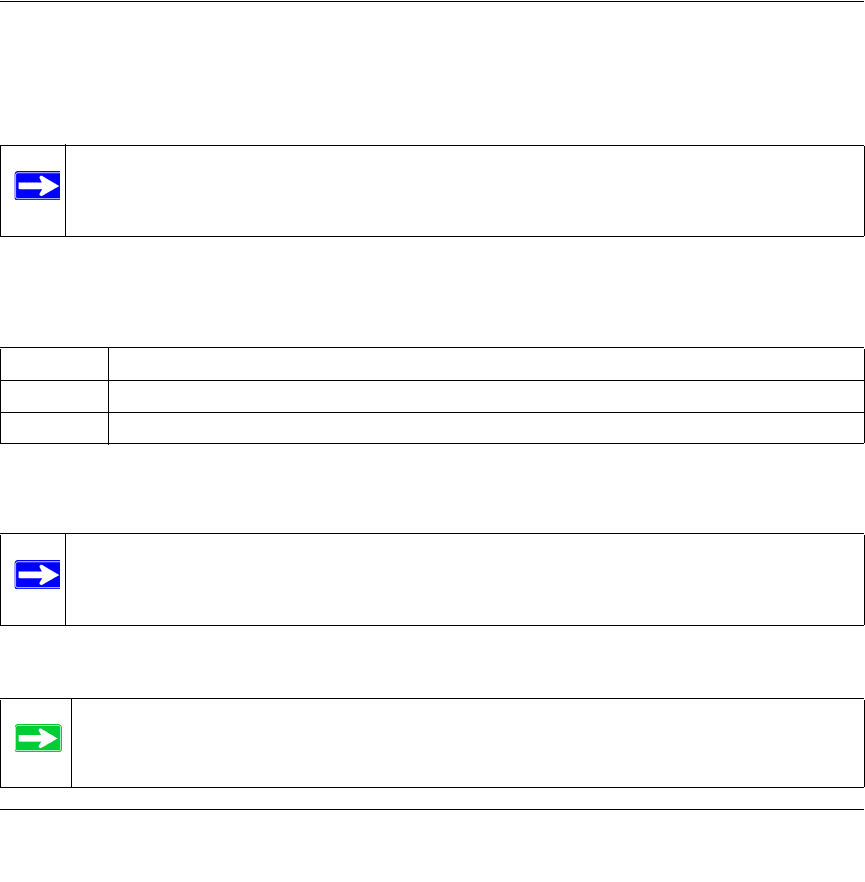
About This Manual 1-1
v1.0, January 2006
Chapter 1
About This Manual
This chapter describes the intended audience, scope, conventions, and formats of this manual.
Audience, Scope, Conventions, and Formats
This reference manual assumes that the reader has basic to intermediate computer and Internet
skills. However, basic computer network, Internet, firewall, and VPN technologies tutorial
information is provided in the Appendices and on the Netgear website.
This guide uses the following typographical conventions:
This guide uses the following formats to highlight special messages:
Note: Product updates are available on the NETGEAR, Inc. Web site at
http://kbserver.netgear.com/products/DG834G v3.asp.
Table 1-1.
italics Emphasis, books, CDs, URL names
bold User input
fixed Screen text, file and server names, extensions, commands, IP addresses
Note: This format is used to highlight information of importance or special interest.
Tip: This format is used to highlight a procedure that will save time or resources.

Reference Manual for the ADSL Modem Wireless Router DG834G
1-2 About This Manual
v1.0, January 2006
This manual is written for the ADSL Modem Wireless Router according to these specifications:
How to Print this Manual
To print this manual you can choose one of the following several options, according to your needs.
•Printing a Page in the HTML View.
Each page in the HTML version of the manual is dedicated to a major topic. Use the Print
button on the browser toolbar to print the page contents.
•Printing a Chapter.
Use the PDF of This Chapter link at the top left of any page.
— Click the PDF of This Chapter link at the top right of any page in the chapter you want to
print. The PDF version of the chapter you were viewing opens in a browser window.
— Your computer must have the free Adobe Acrobat reader installed in order to view and
print PDF files. The Acrobat reader is available on the Adobe Web site at
http://www.adobe.com.
Warning: Ignoring this type of note may result in a malfunction or damage to the
equipment.
Danger: This is a safety warning. Failure to take heed of this notice may result in
personal injury or death.
Table 1-2. Manual Scope
Product Version 54 Mbps ADSL Modem Wireless Router Model DG834G
Manual Publication Date January 2006

Reference Manual for the ADSL Modem Wireless Router DG834G
About This Manual 1-3
v1.0, January 2006
— Click the print icon in the upper left of the window.
•Printing the Full Manual.
Use the Complete PDF Manual link at the top left of any page.
— Click the Complete PDF Manual link at the top left of any page in the manual. The PDF
version of the complete manual opens in a browser window.
— Click the print icon in the upper left of the window.
Tip: If your printer supports printing two pages on a single sheet of paper, you can
save paper and printer ink by selecting this feature.
Tip: If your printer supports printing two pages on a single sheet of paper, you can
save paper and printer ink by selecting this feature.

Reference Manual for the ADSL Modem Wireless Router DG834G
1-4 About This Manual
v1.0, January 2006

Introduction 2-1
v1.0, January 2006
Chapter 2
Introduction
This chapter describes the features of the NETGEAR 54 Mbps ADSL Modem Wireless Router
Model DG834G. The ADSL Modem Wireless Router is a combination of a built-in ADSL
modem, modem router, 4-port switch, and firewall which enables your entire network to safely
share an Internet connection that otherwise would be used by a single computer.
About the Modem Router
The 54 Mbps ADSL Modem Wireless Router Model DG834G provides continuous, high-speed
10/100 Ethernet access between your Ethernet devices. With minimum setup, you can install and
use the modem router within minutes.
The ADSL Modem Wireless Router provides multiple Web content filtering options, reporting,
and instant alerts. Parents and network administrators can establish restricted access policies based
on time of day, Web site addresses, and address keywords. They can also share high-speed ADSL
Internet access for up to 253 personal computers. The included firewall and Network Address
Translation (NAT) features protect you from hackers.
The DG834G v3 also supports Trend Micro Home Network Security, a bundle of services that
includes router-based Parental Controls and network-wide protection from viruses, Trojans,
spyware, spam, and other Internet threats.
Note: If you are unfamiliar with networking and routing, refer to “Internet Networking
and TCP/IP Addressing” in Appendix C to become more familiar with the terms
and procedures used in this manual.

Reference Manual for the ADSL Modem Wireless Router DG834G
2-2 Introduction
v1.0, January 2006
Key Features
The ADSL Modem Wireless Router provides the following features:
• A built-in ADSL modem
• A powerful, true firewall
• 802.11g standards-based wireless networking
• Easy, Web-based setup for installation and management
• Extensive Internet protocol support
• Trustworthy VPN Communications over the Internet
• VPN Wizard for easy VPN configuration
• Auto Sensing and Auto Uplink™ LAN Ethernet connections
• Content filtering
• Support for Trend Micro Home Network Security
These features are discussed below.
A Powerful, True Firewall
Unlike simple Internet sharing NAT routers, the DG834G v3 is a true firewall, using stateful
packet inspection to defend against hacker attacks. Its firewall features include:
• Denial of Service (DoS) protection
Automatically detects and thwarts Denial of Service (DoS) attacks such as Ping of Death,
SYN Flood, LAND Attack and IP Spoofing.
• Blocks unwanted traffic from the Internet to your LAN.
• Blocks access from your LAN to Internet locations or services that you specify as off-limits.
• Logs security incidents
The DG834G v3 will log security events such as blocked incoming traffic, port scans, attacks,
and administrator logins. You can configure the modem router to email the log to you at
specified intervals. You can also configure the modem router to send immediate alert messages
to your email address or email pager whenever a significant event occurs.

Reference Manual for the ADSL Modem Wireless Router DG834G
Introduction 2-3
v1.0, January 2006
802.11 Standards-based Wireless Networking
The ADSL Modem Wireless Router includes an 802.11g-compliant wireless access point,
providing continuous, high-speed 10/100 Mbps access between your wireless and Ethernet
devices. The access point provides:
• 802.11g Standards-based wireless networking at up to 54 Mbps
• Works with both 802.11g and 802.11b wireless devices
• 64-bit and 128-bit WEP encryption security
• WEP keys can be entered manually or generated by passphrase
• Support for Wi-Fi Protected Access Pre-Shared Key (WPA-PSK) encryption and 802.1x
authentication
• Wireless access can be restricted by MAC address
Easy Installation and Management
You can install, configure, and operate the DG834G v3 within minutes after connecting it to the
network. The following features simplify installation and management tasks:
• Browser-based management
Browser-based configuration allows you to easily configure your modem router from almost
any type of personal computer, such as Windows, Macintosh, or Linux. A user-friendly Setup
Wizard is provided and online help documentation is built into the browser-based Web
Management Interface.
• Smart Wizard
The firmware in the modem router automatically senses the type of Internet connection, asking
you only for the information required for your type of ISP account.
• Remote management
The modem router allows you to log in to the Web management interface from a remote
location via the Internet. For security, you can limit remote management access to a specified
remote IP address or range of addresses, or you can choose a nonstandard port number.
• Diagnostic functions
The modem router incorporates built-in diagnostic functions such as Ping, DNS lookup, and
remote reboot. These functions allow you to test Internet connectivity and reboot the modem
router. You can use these diagnostic functions directly from the DG834G v3 when you are
connected on the LAN or when you are connected over the Internet via the remote
management function.

Reference Manual for the ADSL Modem Wireless Router DG834G
2-4 Introduction
v1.0, January 2006
• Visual monitoring
The modem router’s front panel LEDs provide an easy way to monitor its status and activity.
• Flash erasable programmable read-only memory (EPROM) for firmware upgrades.
Protocol Support
The DG834G v3 supports Transmission Control Protocol/Internet Protocol (TCP/IP) and Routing
Information Protocol (RIP). “Internet Networking and TCP/IP Addressing” in Appendix C
provides further information on TCP/IP.
• The Ability to Enable or Disable IP Address Sharing by NAT
The DG834G v3 allows several networked PCs to share an Internet account using only a
single IP address, which may be statically or dynamically assigned by your Internet service
provider (ISP). This technique, known as Network Address Translation (NAT), allows the use
of an inexpensive single-user ISP account. This feature can also be turned off completely
while using the DG834G v3 if you want to manage the IP address scheme yourself.
• Automatic Configuration of Attached PCs by DHCP
The DG834G v3 dynamically assigns network configuration information, including
IP, modem router, and domain name server (DNS) addresses, to attached PCs on the LAN
using the Dynamic Host Configuration Protocol (DHCP). This feature greatly simplifies
configuration of PCs on your local network.
• DNS Proxy
When DHCP is enabled and no DNS addresses are specified, the modem router provides its
own address as a DNS server to the attached PCs. The modem router obtains actual DNS
addresses from the ISP during connection setup and forwards DNS requests from the LAN.
• Classical IP (RFC 1577)
Some Internet service providers, in Europe for example, use Classical IP in their ADSL
services. In such cases, the modem router is able to use the Classical IP address from the ISP.
• PPP over Ethernet (PPPoE)
PPP over Ethernet is a protocol for connecting remote hosts to the Internet over an ADSL
connection by simulating a dial-up connection. This feature eliminates the need to run a login
program such as EnterNet or WinPOET on your computer.
• PPP over ATM (PPPoA)
PPP over ATM is a protocol for connecting remote hosts to the Internet over an ADSL
connection by simulating an ATM connection.

Reference Manual for the ADSL Modem Wireless Router DG834G
Introduction 2-5
v1.0, January 2006
• Dynamic DNS
Dynamic DNS services allow remote users to find your network using a domain name when
your IP address is not permanently assigned. The modem router contains a client that can
connect to many popular Dynamic DNS services to register your dynamic IP address.
• Universal Plug and Play (UPnP)
UPnP is a networking architecture that provides compatibility between networking
technologies. UPnP compliant routers provide broadband users at home and small businesses
with a seamless way to participate in online games, videoconferencing and other peer-to-peer
services.
Virtual Private Networking (VPN)
The ADSL Modem Wireless Router provides a secure encrypted connection between your local
area network (LAN) and remote networks or clients. It includes the following VPN features:
• Supports 5 VPN connections.
• Supports industry standard VPN protocols
The ADSL Modem Wireless Router supports standard Manual or IKE keying methods,
standard MD5 and SHA-1 authentication methods, and standard DES and 3DES encryption
methods. It is compatible with many other VPN products.
• Supports 3DES encryption for maximum security.
• VPN Wizard based on VPNC recommended settings.
Auto Sensing and Auto Uplink™ LAN Ethernet Connections
With its internal 4-port 10/100 switch, the DG834G v3 can connect to either a 10 Mbps standard
Ethernet network or a 100 Mbps Fast Ethernet network. The local LAN ports are autosensing and
capable of full-duplex or half-duplex operation.
The modem router incorporates Auto UplinkTM technology. Each local Ethernet port will
automatically sense whether the Ethernet cable plugged into the port should have a ‘normal’
connection such as to a computer or an ‘uplink’ connection such as to a switch or hub. That port
will then configure itself to the correct configuration. This feature also eliminates the need to
worry about crossover cables, as Auto Uplink will accommodate either type of cable to make the
right connection.

Reference Manual for the ADSL Modem Wireless Router DG834G
2-6 Introduction
v1.0, January 2006
Content Filtering
With its content filtering feature, the DG834G v3 prevents objectionable content from reaching
your PCs. The modem router allows you to control access to Internet content by screening for
keywords within Web addresses. You can configure the modem router to log and report attempts to
access objectionable Internet sites.
Trend Micro Home Network Security
This service bundle from Trend Micro has three components:
•Trend Micro dashboard
This component is free for unlimited use. From the dashboard you can:
— Scan your computer and entire network for security vulnerabilities
— View individual computer and network-wide security reports
— Detect and remove spyware
— View attempts to access content restricted by Parental Controls
— Purchase subscriptions for Parental Controls and Trend Micro Internet Security
•Trend Micro Internet Security
You can install this program on up to 10 computers and try it free for 60 days. Its features
include:
— Real-time and scheduled scanning to remove viruses, Trojans, spyware, and other Internet
threats
— Personal firewall
— Network intruder detection
—Anti-spam
•Router-based Parental Controls
This service restricts home network users from viewing inappropriate Web content. It is free
for 60 days, and when you register your free trial of Trend Micro Internet Security, your free
use of Parental Controls is automatically extended to one year.
For instructions on activating these services, refer to “Trend Micro Home Network Security” on
page 4-15.

Reference Manual for the ADSL Modem Wireless Router DG834G
Introduction 2-7
v1.0, January 2006
What’s in the Box?
The product package should contain the following items:
• 54 Mbps ADSL Modem Wireless Router Model DG834G
• AC power adapter (varies by region)
• Category 5 (Cat 5) Ethernet cable
• Telephone cable with RJ-11 connector
• Microfilters (quantity and type vary by region)
•DG834G ADSL Modem Wireless Router Resource CD, including this guide
• Two plastic feet that can be used to stand the ADSL Modem Wireless Router on end
• Warranty and Support Information cards
If any of the parts are incorrect, missing, or damaged, contact your NETGEAR dealer. Keep the
carton, including the original packing materials, in case you need to return the product for repair.
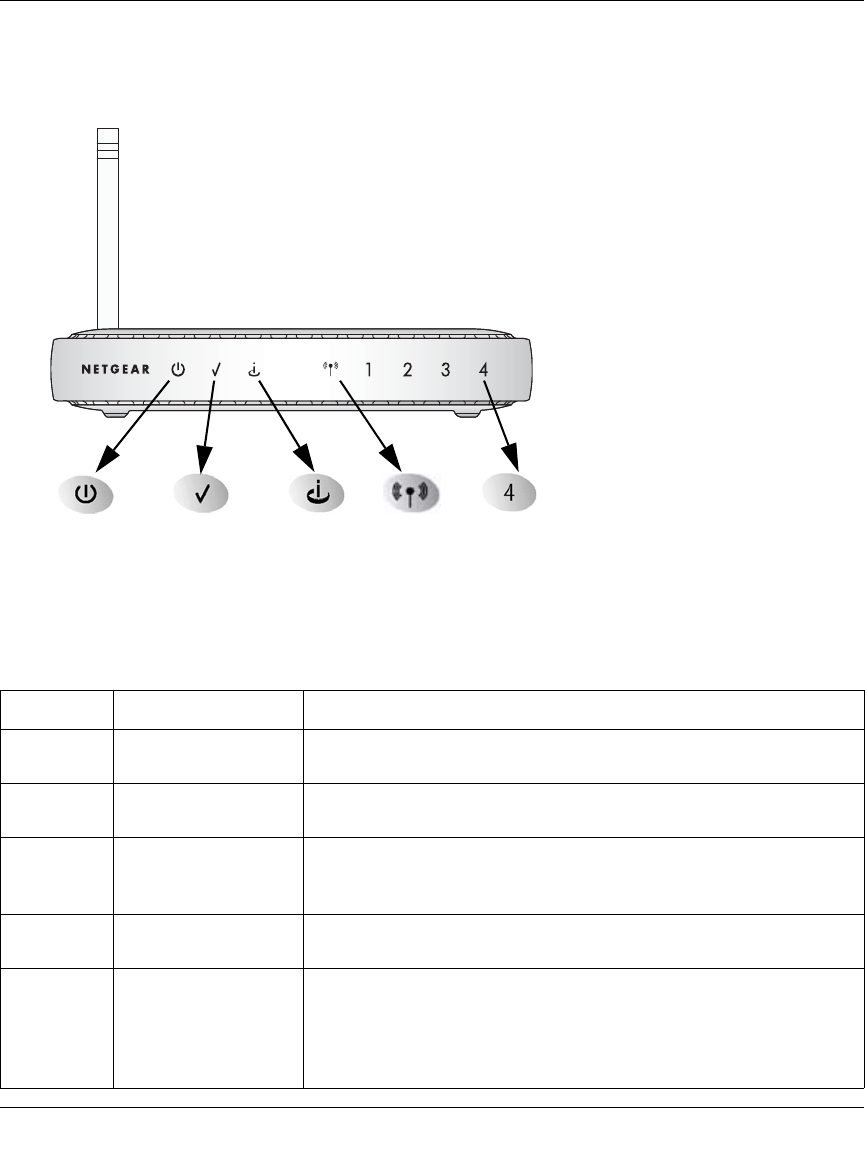
Reference Manual for the ADSL Modem Wireless Router DG834G
2-8 Introduction
v1.0, January 2006
The Router’s Front Panel
The front panel shown below contains status LEDs.
You can use the LEDs to verify various conditions. Table 2-1 describes each LED.
Figure 2-1
Table 2-1. LED Descriptions
Label Activity Description
1. Power On
Off Power is supplied to the router.
Power is not supplied to the router.
2. Test On
Off The system is initializing.
The system is ready and running.
3. Internet
Blink -- Amber
On -- Green
Blink -- Green
Indicates ADSL training.
The Internet port has detected a link with an attached device.
Data is being transmitted or received by the Internet port.
4. Wireless On
Off Indicates that the Wireless port is initialized.
The Wireless Access Point is turned off.
5. LAN
On (Green)
Blink (Green)
On (Amber)
Blink (Amber)
Off
The Local port has detected a link with a 100 Mbps device.
Data is being transmitted or received at 100 Mbps.
The Local port has detected a link with a 10 Mbps device.
Data is being transmitted or received at 10 Mbps.
No link is detected on this port.
12345
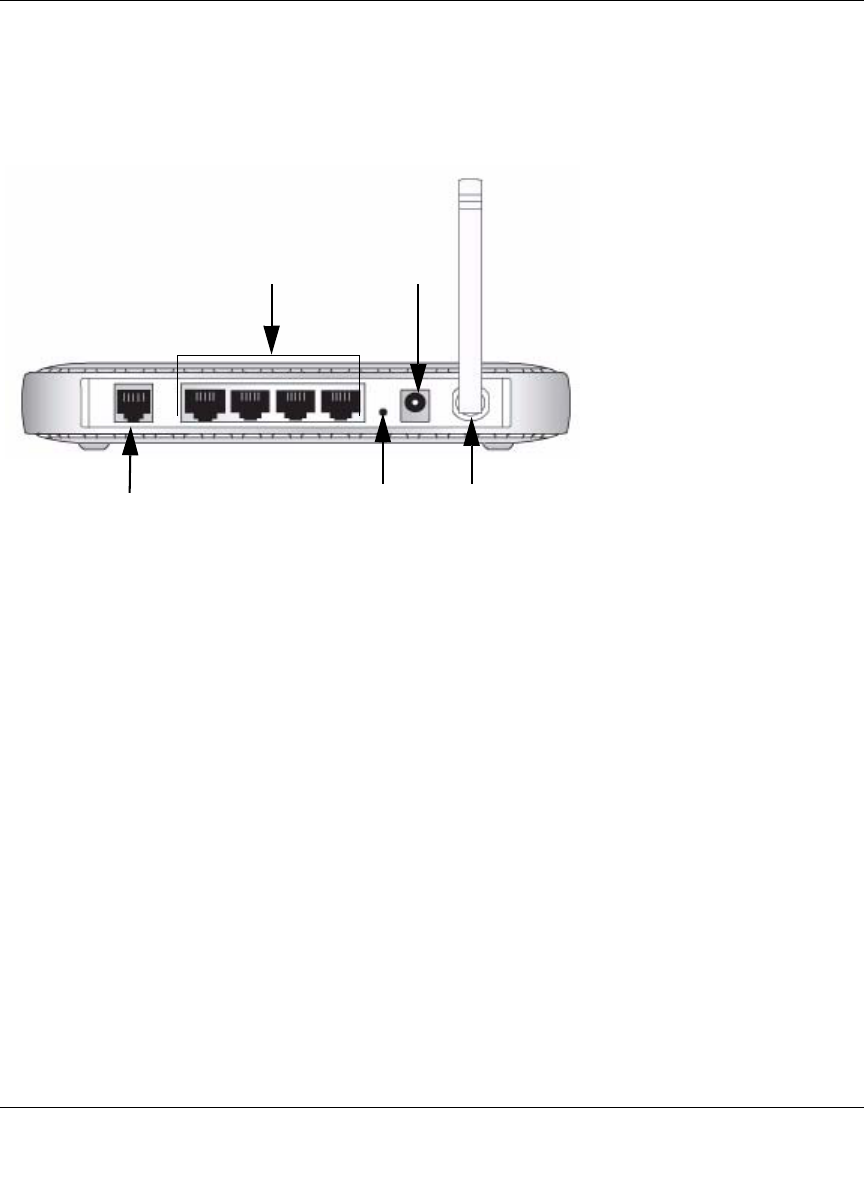
Reference Manual for the ADSL Modem Wireless Router DG834G
Introduction 2-9
v1.0, January 2006
The Router’s Rear Panel
The rear panel of the 54 Mbps ADSL Modem Wireless Router Model DG834G (Figure 2-2)
contains port connections.
Viewed from left to right, the rear panel contains the following elements:
1. RJ-11 ADSL port for connecting the firewall to an ADSL line
2. Four Local Ethernet RJ-45 LAN ports for connecting the firewall to the local computers
3. Factory Default Reset push button
4. AC power adapter outlet
5. Wireless antenna
Figure 2-2
15
2
3
4

Reference Manual for the ADSL Modem Wireless Router DG834G
2-10 Introduction
v1.0, January 2006
Connecting the Router to the Internet
To connect your ADSL Modem Wireless Router to the Internet, refer to the ADSL Modem
Wirelesss Router Setup Manual on the DG834G ADSL Modem Wireless Router Resource CD or
online as shown in the following table.
Table 2-2.
Language URL
Dutch http://documentation.netgear.com/dg834g/nld/208-10039-01/
English http://documentation.netgear.com/dg834g/enu/208-10033-01/
French http://documentation.netgear.com/dg834g/fra/208-10034-01/
German http://documentation.netgear.com/dg834g/deu/208-10035-01/
Italian http://documentation.netgear.com/dg834g/ita/208-10036-01/
Spanish http://documentation.netgear.com/dg834g/esp/208-10037-01/
Swedish http://documentation.netgear.com/dg834g/sve/208-10038-01/

Wireless Configuration 3-1
v1.0, January 2006
Chapter 3
Wireless Configuration
This chapter describes how to configure the wireless features of your 54 Mbps ADSL Modem
Wireless Router Model DG834G.
Considerations for a Wireless Network
In planning your wireless network, you should consider the level of security required. You should
also select the physical placement of your modem router in order to maximize the network speed.
To ensure proper compliance and compatibility between similar products in your area, the
operating channel and region must be set correctly.
Observe Performance, Placement, and Range Guidelines
The operating distance or range of your wireless connection can vary significantly based on the
physical placement of the wireless firewall. The latency, data throughput performance, and
notebook power consumption also vary depending on your configuration choices.
For best results, place your firewall:
• Near the center of the area in which your computers will operate
• In an elevated location such as a high shelf where the wirelessly connected computers have
line-of-sight access (even if through walls)
• Away from sources of interference, such as computers, microwaves, and cordless phones
• With the Antenna tight and in the upright position
• Away from large metal surfaces
Note: Failure to follow these guidelines can result in significant performance degradation
or inability to wirelessly connect to the router. For complete range/performance
specifications, please see Appendix A, “Technical Specifications”.
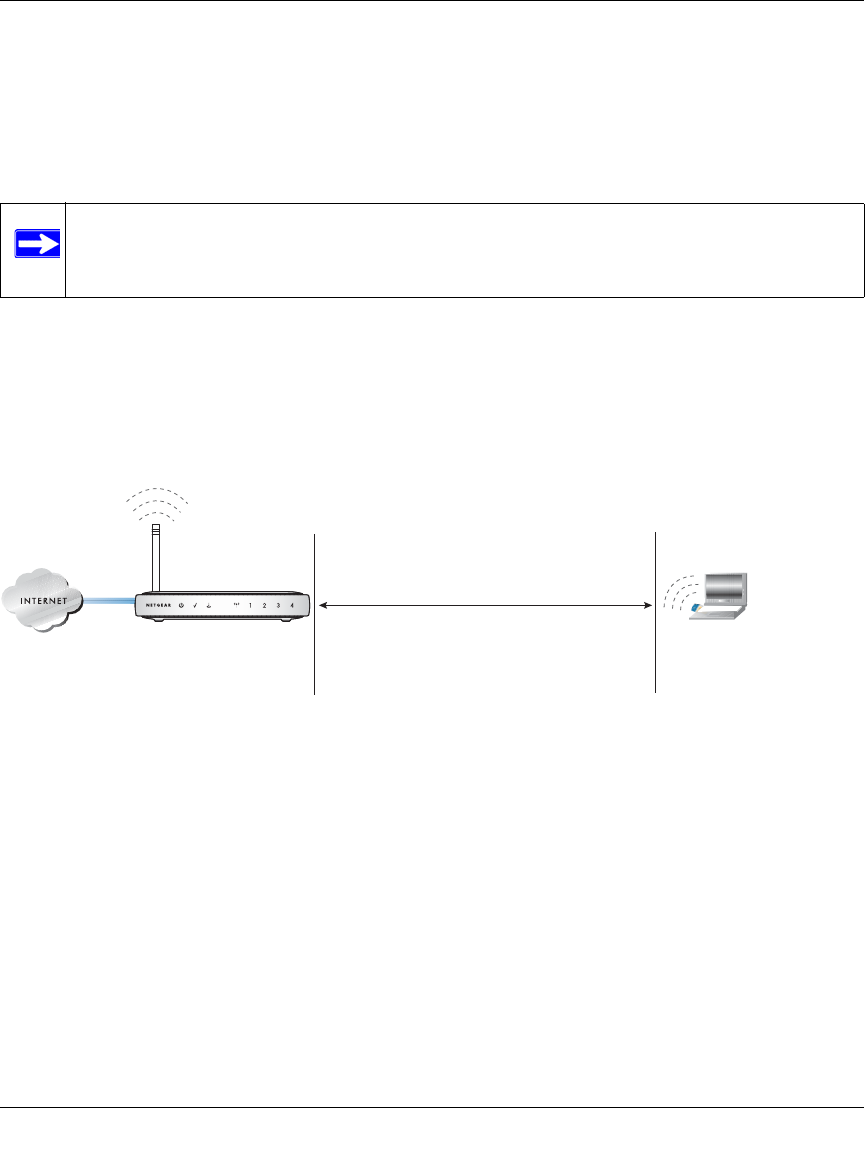
Reference Manual for the ADSL Modem Wireless Router DG834G
3-2 Wireless Configuration
v1.0, January 2006
The time it takes to establish a wireless connection can vary depending on both your security
settings and placement. WEP connections can take slightly longer to establish. Also, WEP
encryption can consume more battery power on a notebook computer.
Implement Appropriate Wireless Security
Unlike wired network data, your wireless data transmissions can extend beyond your walls and
can be received by anyone with a compatible adapter. For this reason, use the security features of
your wireless equipment. The ADSL Modem Wireless Router provides highly effective security
features which are covered in detail in this chapter. Deploy the security features appropriate to
your needs.
There are several ways you can enhance the security of your wireless network:
•Restrict Access Based on MAC Address. You can allow only trusted PCs to connect so that
unknown PCs cannot wirelessly connect to the DG834G v3. Restricting access by MAC
address adds an obstacle against unwanted access to your network, but the data broadcast over
the wireless link is fully exposed.
•Turn Off the Broadcast of the Wireless Network Name SSID. If you disable broadcast of
the SSID, only devices that have the correct SSID can connect. This nullifies wireless network
‘discovery’ feature of some products, such as Windows XP, but the data is still exposed.
Note: Indoors, computers can connect over 802.11g wireless networks at a maximum
range of up to 300 feet. Such distances can allow for others outside of your
immediate area to access your network.
Figure 3-1
/PEN3YSTEM%ASYBUTNOSECURITY
-!#!CCESS,IST.ODATASECURITY
7%03ECURITYBUTSOMEPERFORMANCEIMPACT
70!3TRONGSECURITY
:LUHOHVV'DWD
6HFXULW\2SWLRQV
5DQJH8SWR)HHW
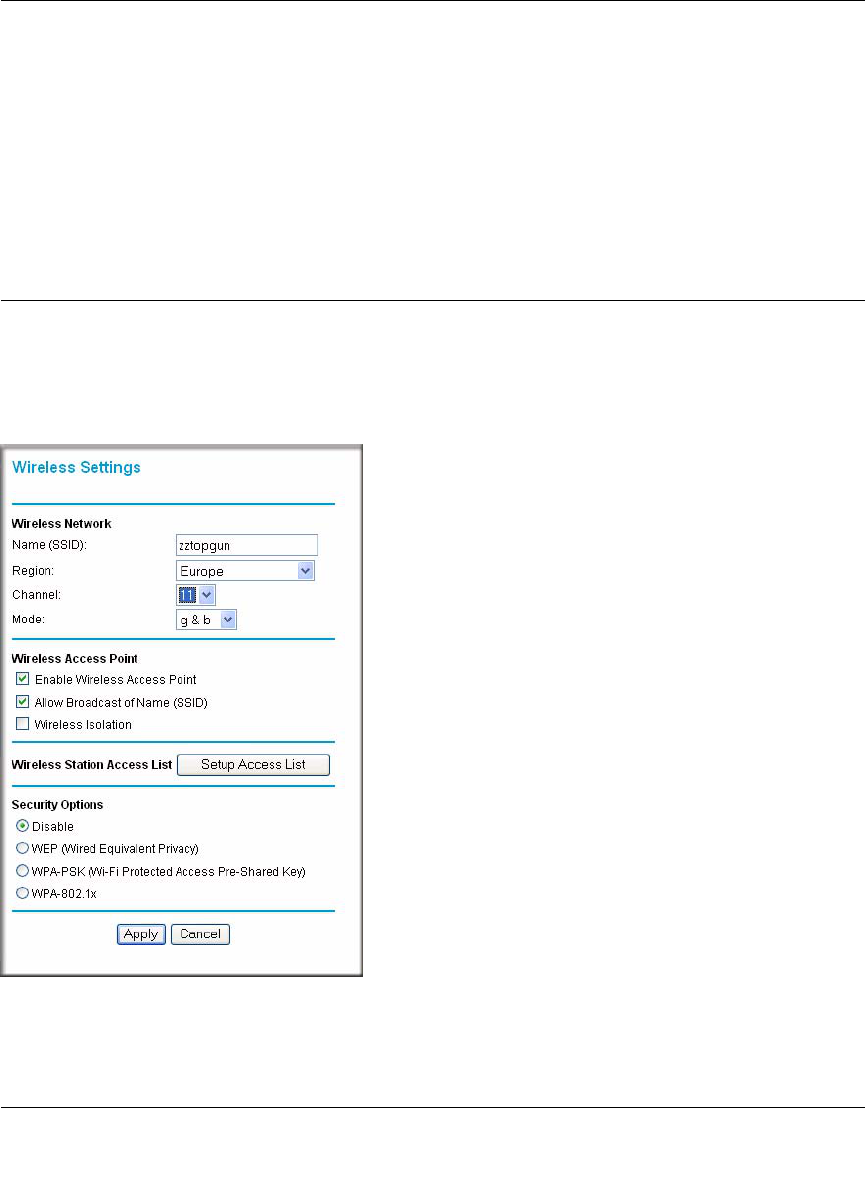
Reference Manual for the ADSL Modem Wireless Router DG834G
Wireless Configuration 3-3
v1.0, January 2006
•WEP. Wired Equivalent Privacy (WEP) data encryption provides data security. WEP Shared
Key authentication and WEP data encryption will block all but the most determined
eavesdropper.
•WPA. Wi-Fi Protected Access (WPA) data encryption provides data security. The very strong
authentication along with dynamic per frame re-keying of WPA make it virtually impossible to
compromise. Because this is a new standard, wireless device driver and software availability
may be limited.
Understanding Wireless Settings
To configure the Wireless interface of your modem router, click the Wireless Settings link in the
Setup section of the main menu. The Wireless Settings menu will appear, similar to that shown
below:
Figure 3-2
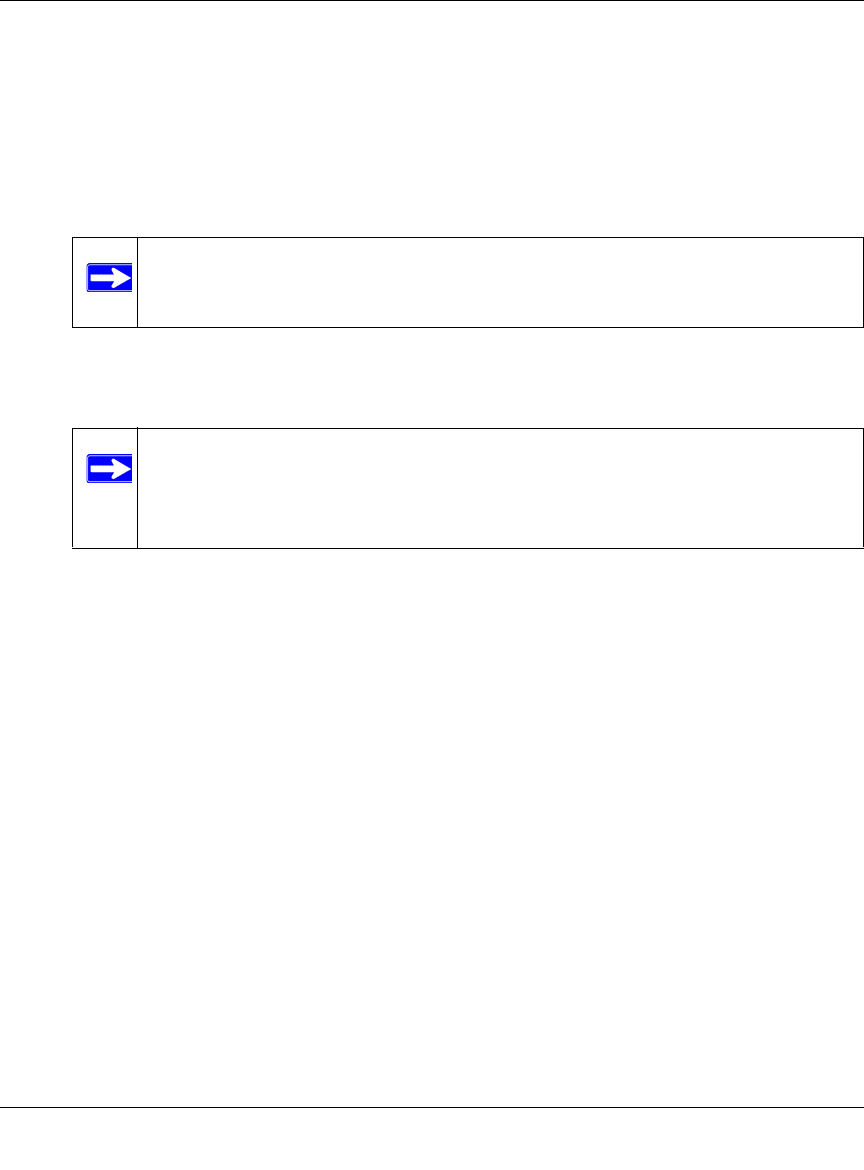
Reference Manual for the ADSL Modem Wireless Router DG834G
3-4 Wireless Configuration
v1.0, January 2006
The following parameters are in the Wireless Settings menu:
•Wireless Network.
—Name (SSID). The Service Set ID, also known as the wireless network name. Enter a
value of up to 32 alphanumeric characters. The same Name (SSID) must be assigned to all
wireless devices in your network. The default SSID is NETGEAR, but NETGEAR
strongly recommends that you change your network Name to a different value.
—Region. Select your country/region from the drop-down list. This field displays the region
of operation for which the wireless interface is intended.
—Channel. This field determines which operating frequency will be used. It should not be
necessary to change the wireless channel unless you notice interference problems with
another nearby access point.
—Mode. The default is "g & b", which allows both "g" and "b" wireless stations to access
this device. “g only” allows only 802.11g wireless stations to be used. “b only” allows
802.11b wireless stations; 802.11g wireless stations can still be used if they can operate in
802.11b mode.
•Wireless Access Point.
—Enable Wireless Access Point. This field lets you turn off or turn on the wireless access
point built in to the modem router. The wireless icon on the front of the modem router will
also display the current status of the Wireless Access Point to let you know if it is disabled
or enabled. The wireless access point must be enabled to allow wireless stations to access
the Internet.
—Allow Broadcast of Name (SSID). If enabled, the SSID is broadcast to all Wireless
Stations. Stations which have no SSID (or a "null" value) can then adopt the correct SSID
for connections to this Access Point.
Note: This value is case sensitive. For example, Wireless is not the same as
wireless.
Note: In the USA, the Region is preset according to regulatory requirements and
cannot be changed. In other areas, you can and must set the Region. It may
not be legal to operate the wireless access point in a region other than one
of those identified in this field.

Reference Manual for the ADSL Modem Wireless Router DG834G
Wireless Configuration 3-5
v1.0, January 2006
—Wireless Isolation. If enabled, Wireless Stations will not be able to communicate with
each other or with Stations on the wired network. This feature should normally be
disabled.
•Wireless Station Access List.
— By default, any wireless computer that is configured with the correct wireless network
name or SSID will be allowed access to your wireless network. For increased security, you
can restrict access to the wireless network to only specific computers based on their MAC
addresses. Click Setup Access List to display the Wireless Station Access List menu.
•Security Options
Table 3-1. Wireless Security Options
Field Description
Disable Wireless security is not used.
WEP (Wired
Equivalent
Privacy)
You can select the following WEP options:
Authentication Type
• Open: the DG834G v3 does not perform any authentication.
• Shared: WEP shared key authentication. For a full explanation of WEP shared key,
see “Wireless Communications” in Appendix C.
Encryption Strength
• If Shared or Open Network Authentication is enabled, you can choose 64- or 128-bit
WEP data encryption.
Note: With Open Network Authentication and 64- or 128-bit WEP Data Encryption, the
DG834G v3 does perform 64- or 128-bit data encryption but does not perform any
authentication.
Security Encryption (WEP) Key
These key values must be identical on all wireless devices in your network (key 1 must
be the same for all, key 2 must be the same for all, and so on).
The DG834G v3 provides two methods for creating WEP encryption keys:
• Passphrase. These characters are case sensitive. Enter a word or group of printable
characters in the Passphrase box and click the Generate button.
Note: Not all wireless adapters support passphrase key generation.
• Manual. These values are not case sensitive.
64-bit WEP: enter 10 hexadecimal digits (any combination of 0-9, a-f, or A-F).
128-bit WEP: enter 26 hexadecimal digits (any combination of 0-9, a-f, or A-F).

Reference Manual for the ADSL Modem Wireless Router DG834G
3-6 Wireless Configuration
v1.0, January 2006
How to Set Up and Test Basic Wireless Connectivity
Follow the instructions below to set up and test basic wireless connectivity. Once you have
established basic wireless connectivity, you can enable security settings appropriate to your needs.
1. Log in to the DG834G v3 firewall at its default LAN address of http://192.168.0.1 with its
default user name of admin and default password of password, or using whatever LAN
address and password you have set up.
2. Click the Wireless Settings link in the main menu of the DG834G v3 firewall.
3. Choose a suitable descriptive name for the wireless network name (SSID). In the SSID box,
enter a value of up to 32 alphanumeric characters. The default SSID is Wireless.
WPA-PSK (Wi-
Fi Protected
Access Pre-
Shared Key)
WPA Pre-Shared-Key uses a pre-shared key to perform the authentication and
generate the initial data encryption keys. Then, it dynamically varies the encryption key.
For a full explanation of WPA, see “Wireless Communications” in Appendix C.
Note: Not all wireless adapters support WPA. Furthermore, client software is required
on the client. Windows XP and Windows 2000 with Service Pack 3 do include the client
software that supports WPA. Nevertheless, the wireless adapter hardware and driver
must also support WPA.
WPA-802.1x User authentication is implemented using 802.1x and RADIUS servers. For a full
explanation of WPA, see “Wireless Communications” in Appendix C.
Fill in the following:
• Radius Server Name/IP Address
This field is required. Enter the name or IP address of the Radius Server on your LAN.
• Radius Port
Enter the port number used for connections to the Radius Server.
• Radius Shared Key
Enter the desired value for the Radius shared key. This key enables the DG834G v3
to log in to the Radius server and must match the value used on the Radius server.
Note: The SSID of any wireless access adapters must match the SSID you configure
in the 54 Mbps ADSL Modem Wireless Router Model DG834G. If they do not
match, you will not get a wireless connection to the DG834G v3.
Table 3-1. Wireless Security Options (continued)
Field Description

Reference Manual for the ADSL Modem Wireless Router DG834G
Wireless Configuration 3-7
v1.0, January 2006
4. Set the Region. Select the region in which the wireless interface will operate.
5. Set the Channel. The default channel is 11.
This field determines which operating frequency will be used. It should not be necessary to
change the wireless channel unless you notice interference problems with another nearby
wireless router or access point. Select a channel that is not being used by any other wireless
networks within several hundred feet of your firewall. For more information on the wireless
channel frequencies please refer to “Wireless Communications” in Appendix C.
6. For initial configuration and test, leave the Wireless Card Access List set to allow everyone
access by making sure that Turn Access Control On is not selected in the Wireless Station
Access List. In addition, leave the Encryption Strength set to “Disabled.”
7. Click Apply to save your changes.
8. Configure and test your computers for wireless connectivity.
Program the wireless adapter of your computers to have the same SSID and channel that you
configured in the router. Check that they have a wireless link and are able to obtain an IP
address by DHCP from the firewall.
Once your computers have basic wireless connectivity to the firewall, you can configure the
advanced wireless security functions of the firewall.
How to Restrict Wireless Access to Your Network
By default, any wireless PC that is configured with the correct SSID will be allowed access to your
wireless network. For increased security, the 54 Mbps ADSL Modem Wireless Router Model
DG834G provides several ways to restrict wireless access to your network:
• Turn off wireless connectivity completely
• Restrict access based on the Wireless Network Name (SSID)
• Restrict access based on the Wireless Card Access List
Note: If you are configuring the firewall from a wireless computer and you change
the firewall’s SSID, channel, or security settings, you will lose your wireless
connection when you click Apply. You must then change the wireless settings
of your computer to match the firewall’s new settings.
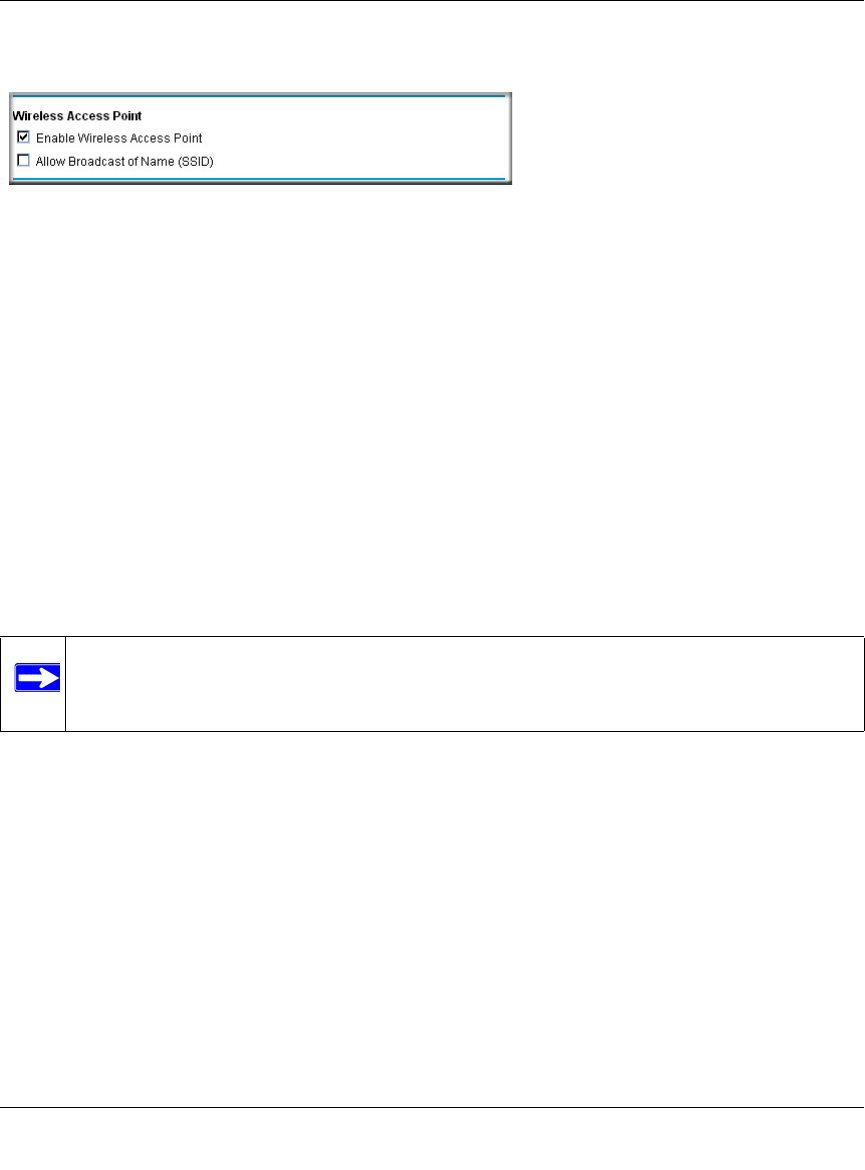
Reference Manual for the ADSL Modem Wireless Router DG834G
3-8 Wireless Configuration
v1.0, January 2006
These options are discussed below.
Restricting Access to Your Network by Turning Off Wireless Connectivity
You can completely turn off the wireless portion of the DG834G v3. For example, if your
notebook computer is used to wirelessly connect to your router and you take a business trip, you
can turn off the wireless portion of the router while you are traveling. Other members of your
household who use computers connected to the router via Ethernet cables will still be able to use
the router.
Restricting Wireless Access Based on the Wireless Network Name (SSID)
The DG834G v3 can restrict wireless access to your network by not broadcasting the wireless
network name (SSID). However, by default, this feature is turned off. If you turn this feature on,
wireless devices will not ‘see’ your DG834G v3. You must configure your wireless devices to
match the wireless network name (SSID) you configure in the ADSL Modem Wireless Router.
Restricting Wireless Access Based on the Wireless Station Access List
This list determines which wireless hardware devices will be allowed to connect to the firewall.
To restrict access based on MAC addresses, follow these steps:
1. Log in to the DG834G v3 firewall at its default LAN address of http://192.168.0.1 with its
default user name of admin and default password of password, or using whatever LAN
address and password you have set up.
Figure 3-3
Note: The SSID of any wireless access adapters must match the SSID you configure in
the 54 Mbps ADSL Modem Wireless Router Model DG834G. If they do not
match, you will not get a wireless connection to the DG834G v3.
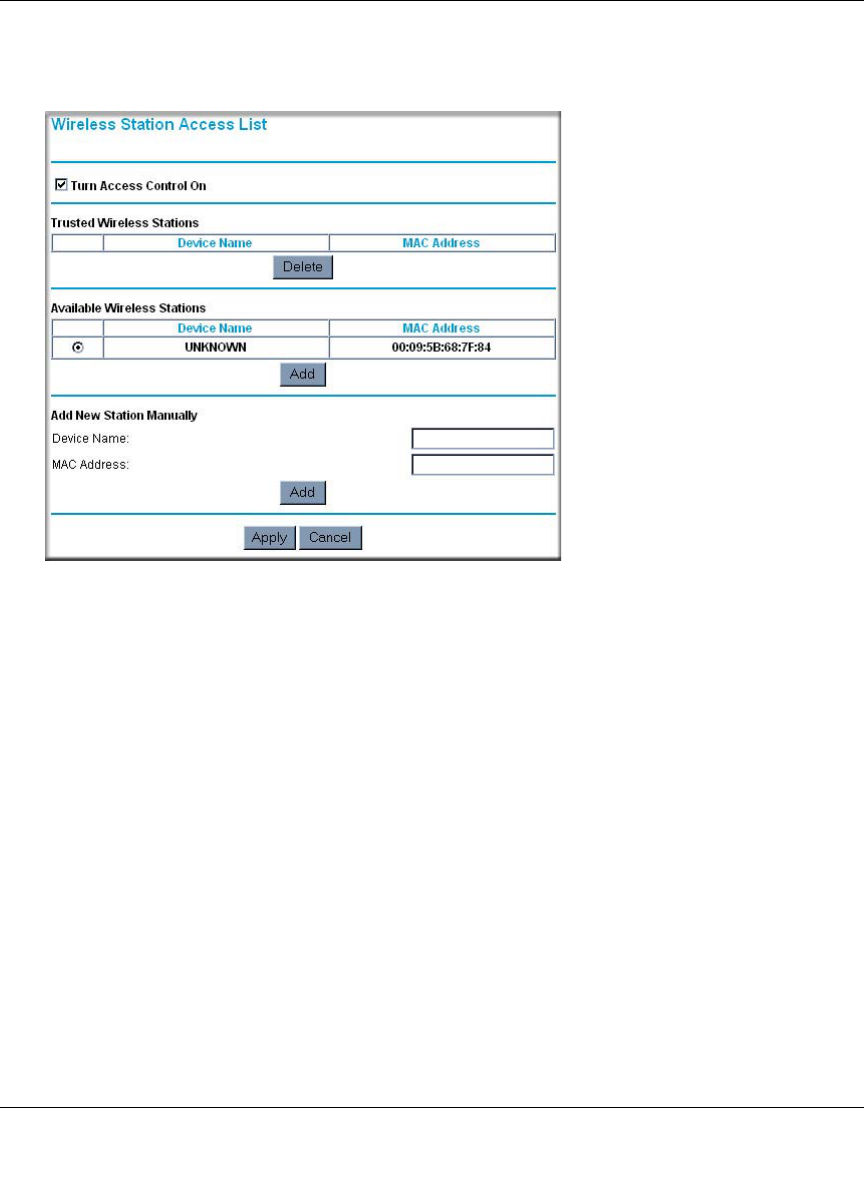
Reference Manual for the ADSL Modem Wireless Router DG834G
Wireless Configuration 3-9
v1.0, January 2006
2. From the Wireless Settings menu, Wireless Station Access List section, click the Setup Access
List button to display the list, shown below:
3. Select the Turn Access Control On check box to enable restricting wireless computers by
their MAC addresses.
4. If the wireless station is currently connected to the network, you can select it from the
Available Wireless Stations list. Click Add to add the station to the Trusted Wireless Stations
list.
5. If the wireless station is not currently connected, you can enter its address manually. Enter the
MAC address of the authorized computer. The MAC address is usually printed on the wireless
card, or it may appear in the modem router’s DHCP table. The MAC address will be 12
hexadecimal digits.
Click Add to add your entry. You can add several stations to the list, but the entries will be
discarded if you do not click Apply.
Figure 3-4
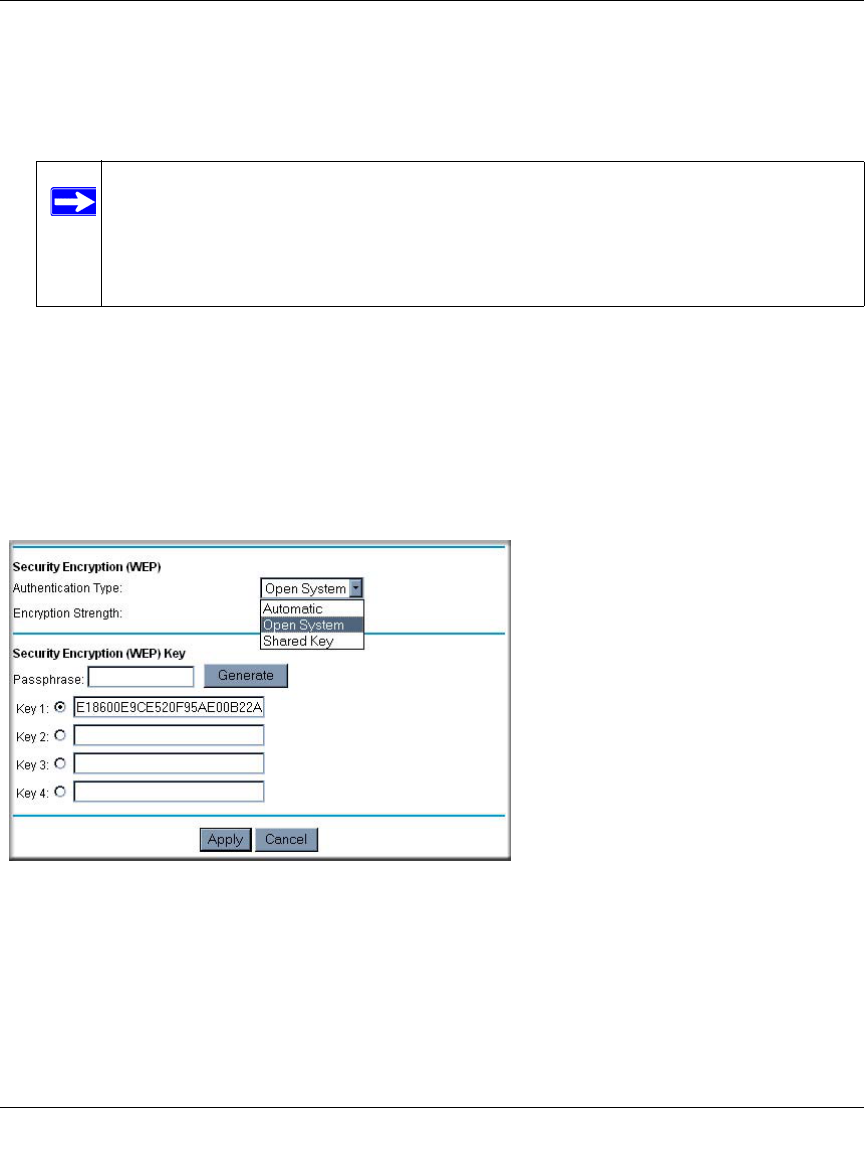
Reference Manual for the ADSL Modem Wireless Router DG834G
3-10 Wireless Configuration
v1.0, January 2006
You can copy and paste the MAC addresses from the modem router’s Attached Devices menu
into the MAC Address box of this menu. To do this, configure each wireless computer to
obtain a wireless link to the modem router. The computer should then appear in the Attached
Devices menu.
6. Make sure the Turn Access Control On check box is selected, then click Apply.
Now, only devices on this list will be allowed to wirelessly connect to the DG834G v3. This
prevents unauthorized access to your network.
Choosing WEP Authentication and Security Encryption Methods
Note: If you are configuring the modem router from a wireless computer whose
MAC address is not in the Trusted Wireless Stations list, and you select
Trusted Wireless Stations only, you will lose your wireless connection when
you click Apply. You must then access the modem router from a wired
computer to make any further changes.
Figure 3-5

Reference Manual for the ADSL Modem Wireless Router DG834G
Wireless Configuration 3-11
v1.0, January 2006
Restricting wireless access prevents intruders from connecting to your network. However, the
wireless data transmissions are still vulnerable to snooping. Using the WEP data encryption
settings described below will prevent a determined intruder from eavesdropping on your wireless
data communications. Also, if you are using the Internet for such activities as purchases or
banking, those Internet sites use another level of highly secure encryption called SSL. You can tell
if a web site is using SSL because the web address begins with HTTPS rather than HTTP.
Authentication Type Selection
The DG834G v3 lets you select the following wireless authentication schemes.
• Automatic
• Open System
• Shared key
Set your wireless adapter according to the authentication scheme you choose for the ADSL
Modem Wireless Router. Please refer to “Wireless Communications” in Appendix C for a full
explanation of each of these options, as defined by the IEEE 802.11g wireless communication
standard.
Encryption Choices
Please refer to “Wireless Communications” in Appendix C for a full explanation of each of the
following choices, as defined by the IEEE 802.11g wireless communication standard. Choose the
encryption strength from the drop-down list:
Disable. No encryption will be applied. This setting is useful for troubleshooting your wireless
connection, but leaves your wireless data fully exposed.
64 or 128 bit WEP. When 64 Bit WEP or 128 Bit WEP is selected, WEP encryption will be
applied.
If WEP is enabled, you can manually or automatically program the four data encryption keys.
These values must be identical on all computers and access points in your network.
Note: The authentication scheme is separate from the data encryption. You can choose an
authentication scheme which requires a shared key but still leave the data
transmissions unencrypted. If you require strong security, use both the Shared Key
and WEP encryption settings.
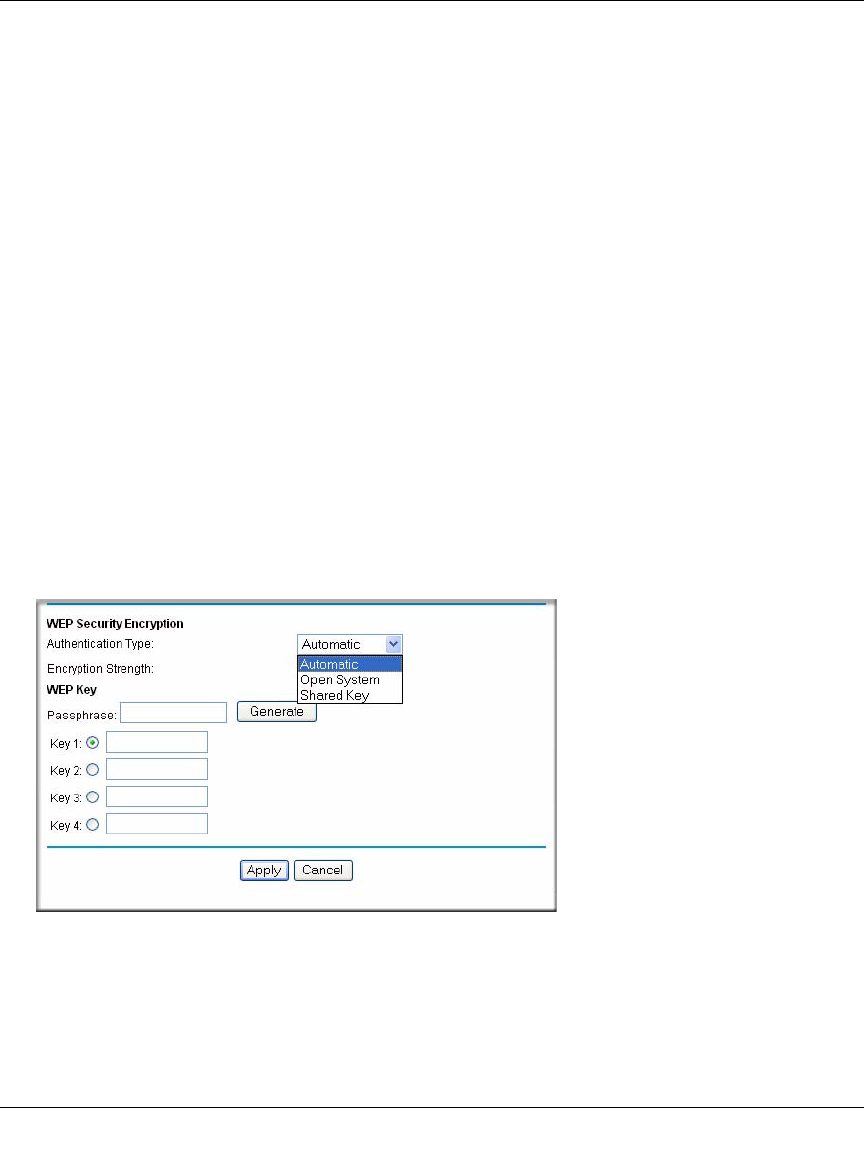
Reference Manual for the ADSL Modem Wireless Router DG834G
3-12 Wireless Configuration
v1.0, January 2006
There are two methods for creating WEP encryption keys:
• Passphrase. Enter a word or group of printable characters in the Passphrase box and click the
Generate button.
• Manual. 64-bit WEP: Enter 10 hexadecimal digits (any combination of 0-9, a-f, or A-F).
128-bit WEP: Enter 26 hexadecimal digits (any combination of 0-9, a-f, or A-F).
Select the radio button for the key you want to make active.
How to Configure WEP
To configure WEP data encryption, follow these steps:
1. Log in to the DG834G v3 firewall at its default LAN address of http://192.168.0.1 with its
default user name of admin and default password of password, or using whatever LAN
address and password you have set up.
2. Click the Wireless Settings link in the Setup section of the main menu for the DG834G v3
modem router.
3. In the Security Options section, select the WEP (Wired Equivalent Privacy) radio button
4. Go to the WEP Security Encryption portion of the page:
5. Select the Authentication Type.
6. Select the Encryption Strength setting.
Figure 3-6

Reference Manual for the ADSL Modem Wireless Router DG834G
Wireless Configuration 3-13
v1.0, January 2006
7. Enter the encryption keys. You can manually or automatically program the four data
encryption keys. These values must be identical on all computers and Access Points in your
network.
• Automatic — enter a word or group of printable characters in the Passphrase box and click
the Generate button. The four key boxes will be automatically populated with key values.
• Manual — enter hexadecimal digits (any combination of 0-9, a-f, or A-F).
Select which of the four keys will be active.
8. Select the radio button for the key you want to make active.
Be sure you clearly understand how the WEP key settings are configured in your wireless
adapter. Wireless adapter configuration utilities such as the one included in Windows XP only
allow entry of one key which must match the default key you set in the DG834G v3.
9. Click Apply to save your settings.
How to Configure WPA-PSK
To configure WPA-PSK, follow these steps:
1. Log in at the default LAN address of http://192.168.0.1, with the default user name of admin
and default password of password, or using whatever LAN address and password you have
set up.
2. Click Wireless Settings in the Setup section of the main menu of the DG834G v3.
3. Choose the WPA-PSK radio button. The WPA-PSK page will display a WPA-PSK Security
Encryption section.
4. Enter the pre-shared key in the Passphrase field.
5. Click Apply to save your settings.
Note: When configuring the modem router from a wireless computer, if you configure
WEP settings, you will lose your wireless connection when you click Apply. You
must then either configure your wireless adapter to match the modem router WEP
settings or access the modem router from a wired computer to make any further
changes.
Note: Not all wireless adapters support WPA. Consult the product document for your
wireless adapter for instructions on configuring WPA settings.

Reference Manual for the ADSL Modem Wireless Router DG834G
3-14 Wireless Configuration
v1.0, January 2006
How to Configure WPA-802.1x
To configure WPA-802.1x, follow these steps:
1. Log in at the default LAN address of http://192.168.0.1, with the default user name of admin
and default password of password, or using whatever LAN address and password you have
set up.
2. Click Wireless Settings in the Setup section of the main menu of the DG834G v3.
3. Choose the WPA-802.1x radio button. The page will display the WPA-802.1x section.
4. Enter the Radius server name/IP address.
5. Enter the Radius port number.
6. Enter the Shared Key.
7. Click Apply to save your settings.
Note: Not all wireless adapters support WPA. Consult the product document for your
wireless adapter for instructions on configuring WPA settings.
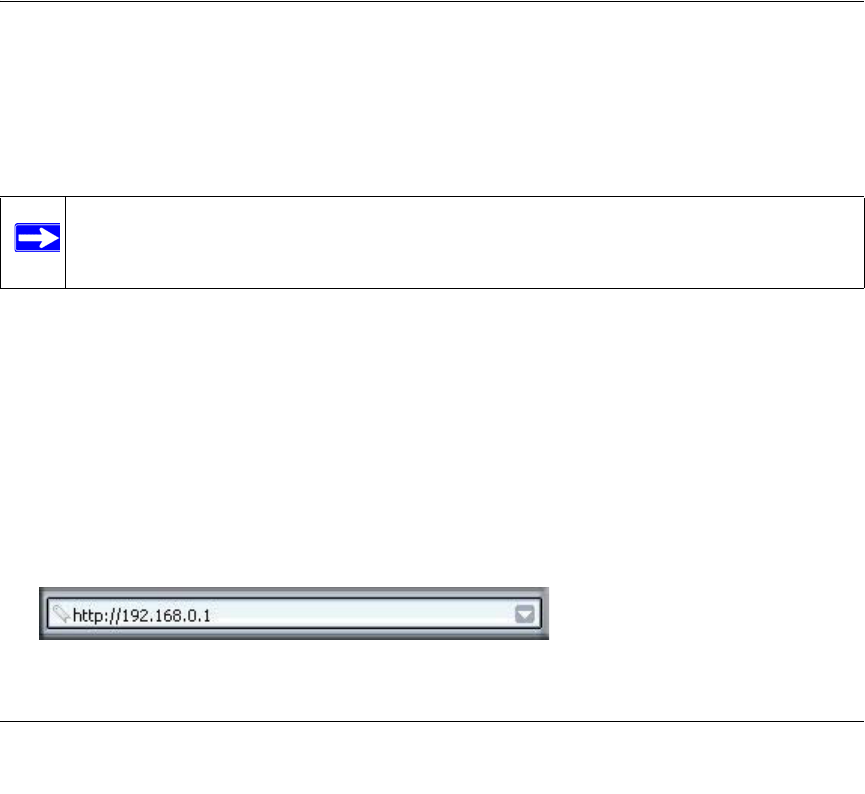
Protecting Your Network 4-1
v1.0, January 2006
Chapter 4
Protecting Your Network
This chapter describes how to use the basic firewall features of the 54 Mbps ADSL Modem
Wireless Router Model DG834G to protect your network. It also describes how to configure Trend
Micro Home Network Security.
Protecting Access to Your 54 Mbps ADSL Modem Wireless
Router Model DG834G
For security reasons, the modem router has its own user name and password. Also, after a period
of inactivity for a set length of time, the administrator login will automatically disconnect. When
prompted, enter admin for the modem router User Name and password for the modem router
Password. You can use procedures below to change the modem router's password and the amount
of time for the administrator’s login timeout.
NETGEAR recommends that you change this password to a more secure password. The ideal
password should contain no dictionary words from any language, and should be a mixture of both
upper and lower case letters, numbers, and symbols. Your password can be up to 30 characters.
How to Change the Built-In Password
1. Log in to the modem router at its default LAN address of http://192.168.0.1 with its default
User Name of admin, default password of password, or using whatever Password and LAN
address you have chosen for the modem router.
Note: The user name and password are not the same as any user name or password your
may use to log in to your Internet connection.
Figure 4-1
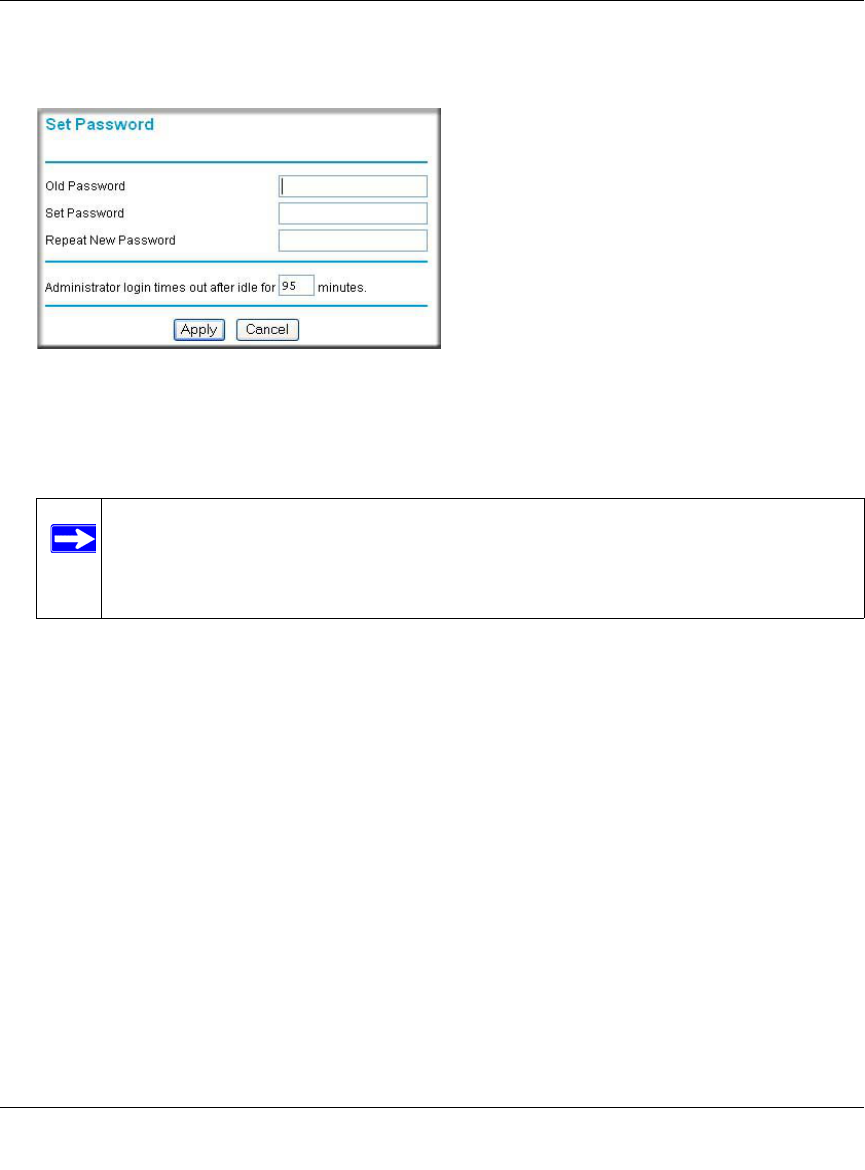
Reference Manual for the ADSL Modem Wireless Router DG834G
4-2 Protecting Your Network
v1.0, January 2006
2. From the Main Menu of the browser interface, under the Maintenance heading, select Set
Password to bring up the menu shown.
3. To change the password, first enter the old password, and then enter the new password twice.
4. Click Apply to save your changes.
Changing the Administrator Login Timeout
For security, the administrator's login to the modem router configuration will timeout after a period
of inactivity. To change the login timeout period:
1. In the Set Password menu, type a number in ‘Administrator login times out’ field. The
suggested default value is 5 minutes.
2. Click Apply to save your changes or click Cancel to keep the current period.
Figure 4-2
Note: After changing the password, you will be required to log in again to continue
the configuration. If you have backed up the modem router settings previously,
you should do a new backup so that the saved settings file includes the new
password.

Reference Manual for the ADSL Modem Wireless Router DG834G
Protecting Your Network 4-3
v1.0, January 2006
Configuring Basic Firewall Services
Basic firewall services you can configure include access blocking and scheduling of firewall
security. These topics are presented below.
Blocking Keywords, Sites, and Services
The modem router provides a variety of options for blocking Internet based content and
communications services. With its content filtering feature, the ADSL Modem Wireless Router
prevents objectionable content from reaching your PCs. The modem router allows you to control
access to Internet content by screening for keywords within Web addresses. Key content filtering
options include:
• Keyword blocking of HTTP traffic.
• Outbound Service Blocking limits access from your LAN to Internet locations or services that
you specify as off-limits.
• Denial of Service (DoS) protection. Automatically detects and thwarts Denial of Service
(DoS) attacks such as Ping of Death, SYN Flood, LAND Attack and IP Spoofing.
• Blocking unwanted traffic from the Internet to your LAN.
The section below explains how to configure your modem router to perform these functions.
How to Block Keywords and Sites
The ADSL Modem Wireless Router allows you to restrict access to Internet content based on
functions such as Web addresses and Web address keywords.
1. Log in to the modem router at its default LAN address of http://192.168.0.1 with its default
User Name of admin, default password of password, or using whatever Password and LAN
address you have chosen for the modem router.
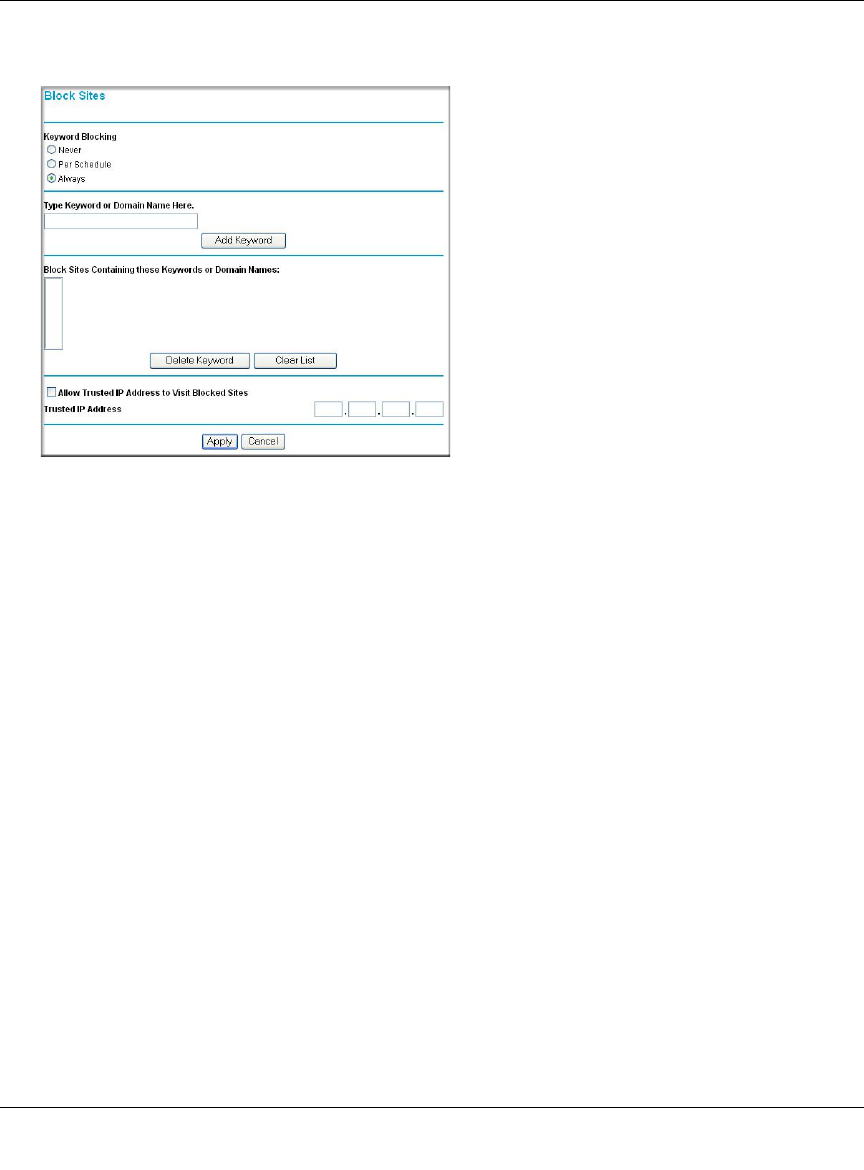
Reference Manual for the ADSL Modem Wireless Router DG834G
4-4 Protecting Your Network
v1.0, January 2006
2. Select the Block Sites link of the Security menu.
3. To enable keyword blocking, select one of the following:
•Per Schedule—to turn on keyword blocking according to the settings on the Schedule
page.
•Always—to turn on keyword blocking all of the time, independent of the Schedule page.
4. Enter a keyword or domain in the Keyword box, click Add Keyword, then click Apply.
Some examples of Keyword application follow:
• If the keyword “XXX” is specified, the URL <http://www.badstuff.com/xxx.html> is
blocked.
• If the keyword “.com” is specified, only Web sites with other domain suffixes (such as
.edu or .gov) can be viewed.
• Enter the keyword “.” to block all Internet browsing access.
Up to 32 entries are supported in the Keyword list.
5. To delete a keyword or domain, select it from the list, click Delete Keyword, then click
Apply.
6. To specify a trusted user, enter that computer’s IP address in the Trusted IP Address box and
click Apply.
Figure 4-3

Reference Manual for the ADSL Modem Wireless Router DG834G
Protecting Your Network 4-5
v1.0, January 2006
You can specify one trusted user, which is a computer that will be exempt from blocking and
logging. Since the trusted user will be identified by an IP address, you should configure that
computer with a fixed IP address.
7. Click Apply to save your settings.
Firewall Rules
Firewall rules are used to block or allow specific traffic passing through from one side of the router
to the other. Inbound rules (WAN to LAN) restrict access by outsiders to private resources,
selectively allowing only specific outside users to access specific resources. Outbound rules (LAN
to WAN) determine what outside resources local users can have access to.
A firewall has two default rules, one for inbound traffic and one for outbound. The default rules of
the DG834G v3 are:
• Inbound: Block all access from outside except responses to requests from the LAN side.
• Outbound: Allow all access from the LAN side to the outside.
You can define additional rules that will specify exceptions to the default rules. By adding custom
rules, you can block or allow access based on the service or application, source or destination IP
addresses, and time of day. You can also choose to log traffic that matches or does not match the
rule you have defined.
You can change the order of precedence of rules so that the rule that applies most often will take
effect first. See “Order of Precedence for Rules” on page 4-11 for more details.
Note: The Block Sites feature is disabled when the Trend Micro Home Security feature is
enabled. This is because the Trend security system has incorporates its own site-
blocking capability.
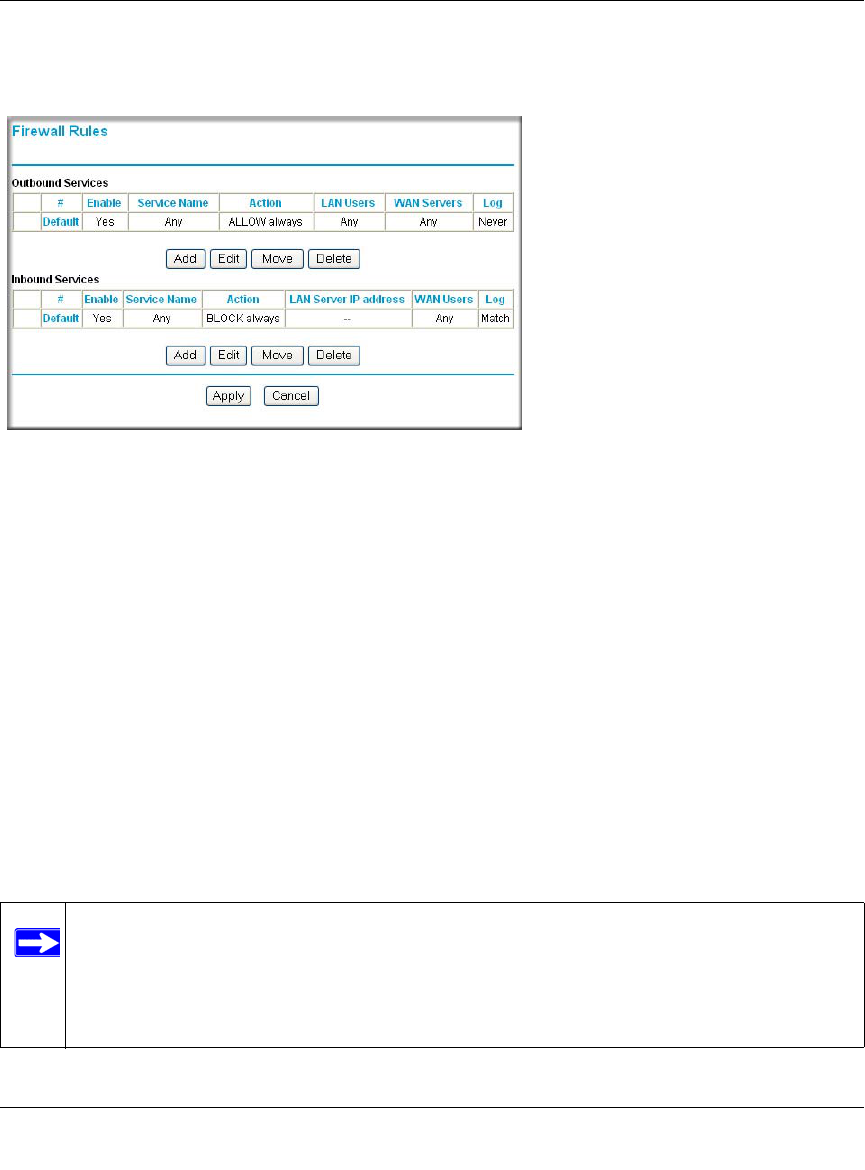
Reference Manual for the ADSL Modem Wireless Router DG834G
4-6 Protecting Your Network
v1.0, January 2006
To access the rules configuration of the DG834G v3, click the Firewall Rules link on the main
menu, then click Add for either an Outbound or Inbound Service.
• To edit an existing rule, select its button on the left side of the table and click Edit.
• To delete an existing rule, select its button on the left side of the table and click Delete.
• To move an existing rule to a different position in the table, select its button on the left side of
the table and click Move. At the script prompt, enter the number of the desired new position
and click OK.
Inbound Rules (Port Forwarding)
Because the DG834G v3 uses Network Address Translation (NAT), your network presents only
one IP address to the Internet, and outside users cannot directly address any of your local
computers. However, by defining an inbound rule you can make a local server (for example, a Web
server or game server) visible and available to the Internet. The rule tells the modem router to
direct inbound traffic for a particular service to one local server based on the destination port
number. This is also known as port forwarding.
Figure 4-4
Note: Some residential broadband ISP accounts do not allow you to run any server
processes (such as a Web or FTP server) from your location. Your ISP may
periodically check for servers and may suspend your account if it discovers any
active services at your location. If you are unsure, refer to the Acceptable Use
Policy of your ISP.
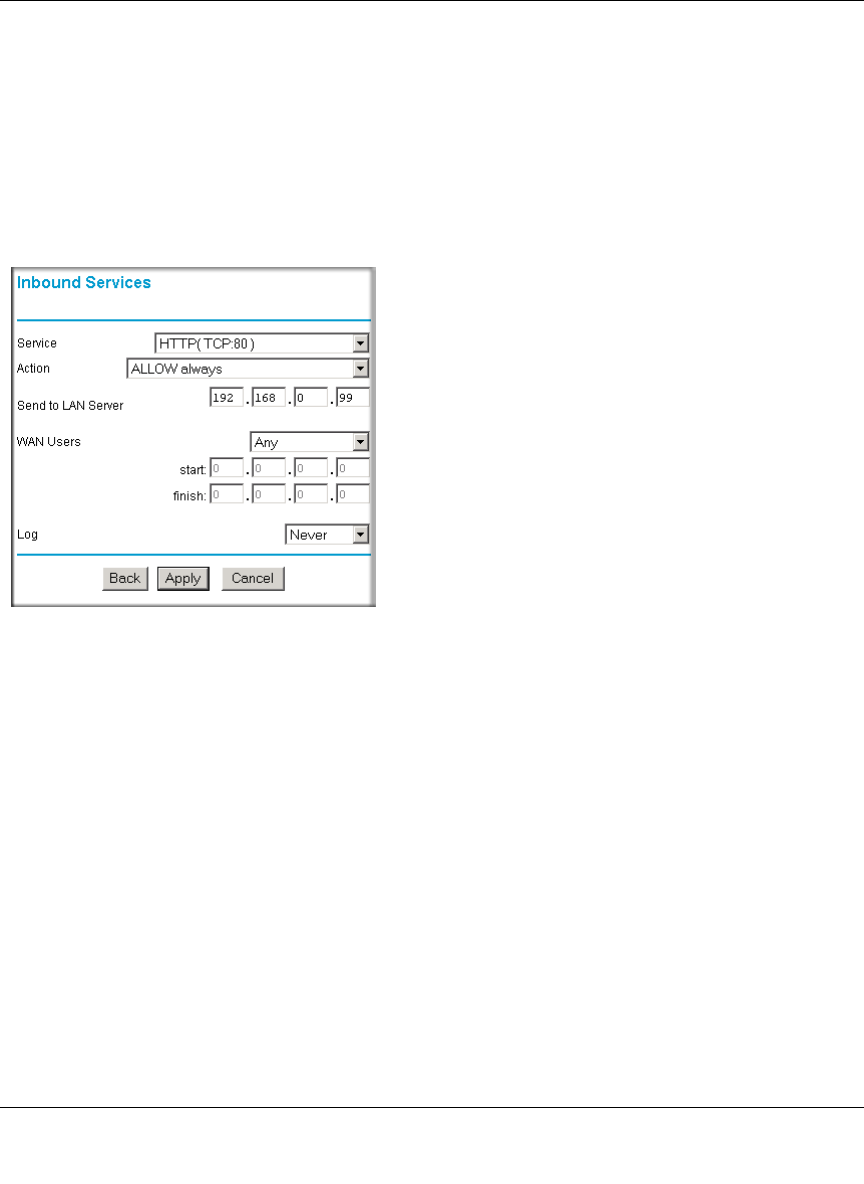
Reference Manual for the ADSL Modem Wireless Router DG834G
Protecting Your Network 4-7
v1.0, January 2006
Remember that allowing inbound services opens holes in your firewall. Only enable those ports
that are necessary for your network. Following are two application examples of inbound rules:
Inbound Rule Example: A Local Public Web Server
If you host a public Web server on your local network, you can define a rule to allow inbound Web
(HTTP) requests from any outside IP address to the IP address of your Web server at any time of
day. This rule is shown:
The parameters are:
•Service—From this list, select the application or service to be allowed or blocked. The list
already displays many common services, but you are not limited to these choices. Use the
Services menu to add any additional services or applications that do not already appear.
•Action—Choose how you want this type of traffic to be handled. You can block or allow
always, or you can choose to block or allow according to the schedule you have defined in the
Schedule menu.
•Send to LAN Server—Enter the IP address of the computer or server on your LAN which
will receive the inbound traffic covered by this rule.
Figure 4-5
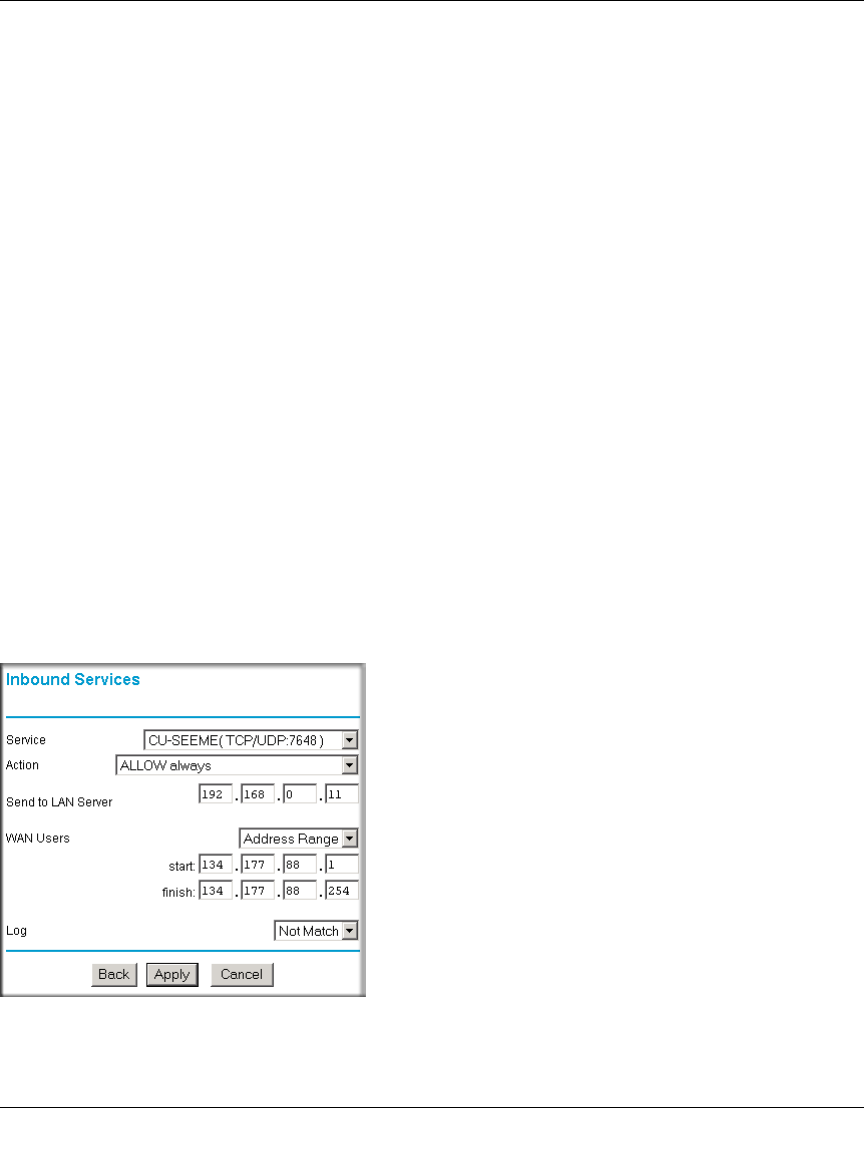
Reference Manual for the ADSL Modem Wireless Router DG834G
4-8 Protecting Your Network
v1.0, January 2006
•WAN Users—These settings determine which packets are covered by the rule, based on their
source (WAN) IP address. Select the desired option:
– Any — all IP addresses are covered by this rule.
– Address range — if this option is selected, you must enter the Start and Finish fields.
– Single address — enter the required address in the Start field.
•Log—You can select whether the traffic will be logged. The choices are:
–Never — no log entries will be made for this service.
–Always — any traffic for this service type will be logged.
–Match — traffic of this type which matches the parameters and action will be logged.
–Not match — traffic of this type which does not match the parameters and action will be
logged.
Inbound Rule Example: Allowing Videoconferencing
If you want to allow incoming videoconferencing to be initiated from a restricted range of outside
IP addresses, such as from a branch office, you can create an inbound rule. In the example shown
here, CU-SeeMe connections are allowed only from a specified range of external IP addresses. In
this case, we have also specified logging of any incoming CU-SeeMe requests that do not match
the allowed parameters.
Figure 4-6

Reference Manual for the ADSL Modem Wireless Router DG834G
Protecting Your Network 4-9
v1.0, January 2006
Considerations for Inbound Rules
If your external IP address is assigned dynamically by your ISP, the IP address may change
periodically as the DHCP lease expires. Consider using the Dynamic DNS feature in the Advanced
menu so that external users can always find your network.
If the IP address of the local server computer is assigned by DHCP, it may change when the
computer is rebooted. To avoid this, use the Reserved IP address feature in the LAN IP menu to
keep the computer’s IP address constant.
Local computers must access the local server using the computer’s local LAN address
(192.168.0.11 in the example above). Attempts by local computers to access the server using the
external WAN IP address will fail.
Outbound Rules (Service Blocking)
The DG834G v3 allows you to block the use of certain Internet services by computers on your
network. This is called service blocking or port filtering. You can define an outbound rule to block
Internet access from a local computer based on:
• IP address of the local computer (source address)
• IP address of the Internet site being contacted (destination address)
•Time of day
• Type of service being requested (service port number)
Following is an application example of outbound rules.
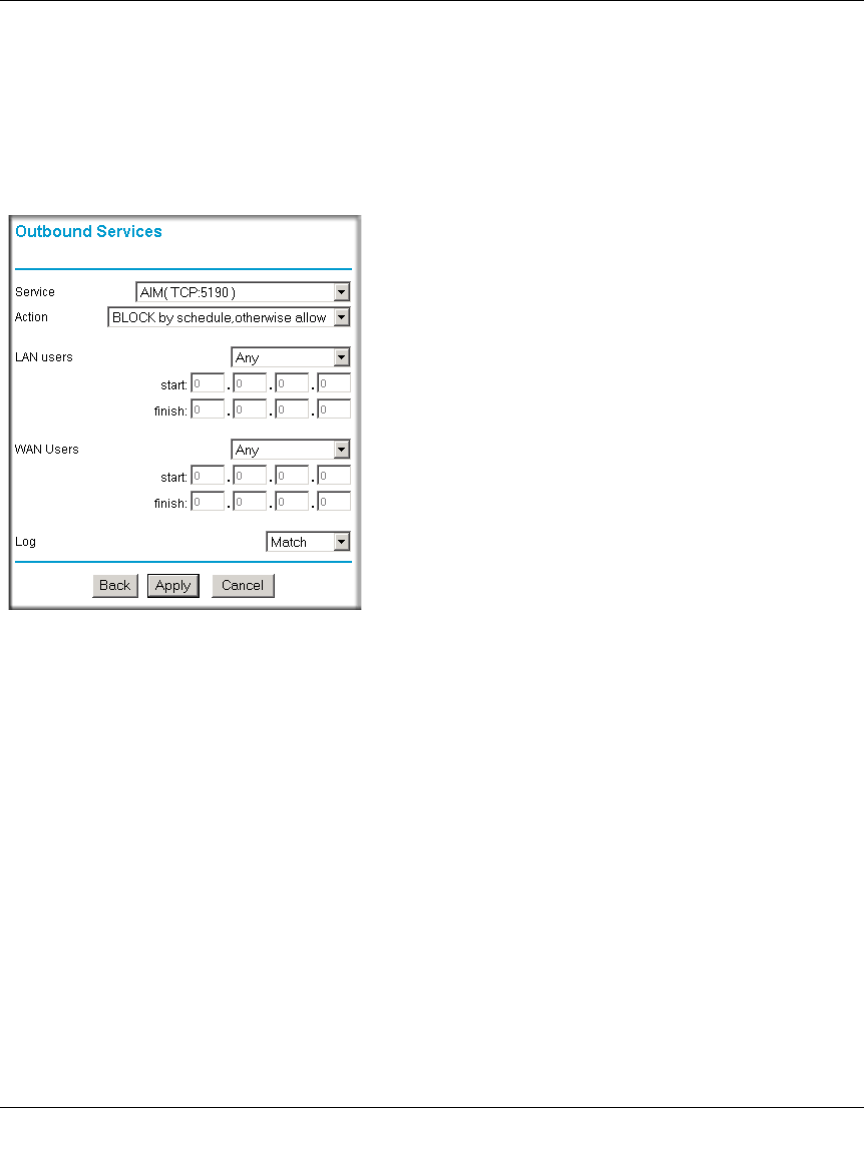
Reference Manual for the ADSL Modem Wireless Router DG834G
4-10 Protecting Your Network
v1.0, January 2006
Outbound Rule Example: Blocking Instant Messenger
If you want to block Instant Messenger usage by employees during working hours, you can create
an outbound rule to block that application from any internal IP address to any external address
according to the schedule that you have created in the Schedule menu. You can also have the
modem router log any attempt to use Instant Messenger during that blocked period.
The parameters are:
•Service—From this list, select the application or service to be allowed or blocked. The list
already displays many common services, but you are not limited to these choices. Use the Add
Custom Service feature to add any additional services or applications that do not already
appear.
•Action—Choose how you want this type of traffic to be handled. You can block or allow
always, or you can choose to block or allow according to the schedule you have defined in the
Schedule menu.
•LAN Users—These settings determine which packets are covered by the rule, based on their
source LAN IP address. Select the desired option:
–Any — all IP addresses are covered by this rule.
–Address range — if this option is selected, you must enter the Start and Finish fields.
–Single address — enter the required address in the Start field.
Figure 4-7
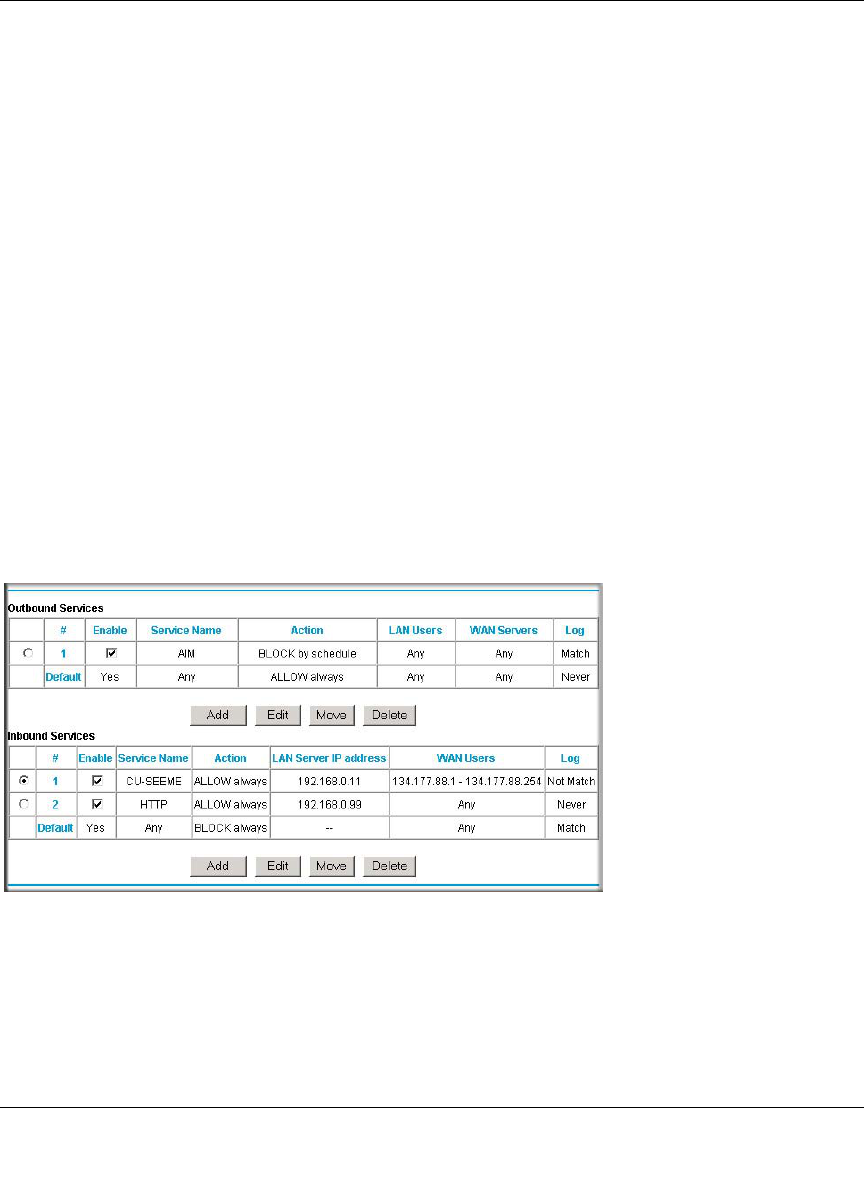
Reference Manual for the ADSL Modem Wireless Router DG834G
Protecting Your Network 4-11
v1.0, January 2006
•WAN Users—These settings determine which packets are covered by the rule, based on their
destination WAN IP address. Select the desired option:
–Any — all IP addresses are covered by this rule.
–Address range —if this option is selected, you must enter the Start and Finish fields.
–Single address — enter the required address in the Start field.
•Log—You can select whether the traffic will be logged. The choices are:
–Never — no log entries will be made for this service.
–Always — any traffic for this service type will be logged.
–Match — traffic of this type that matches the parameters and action will be logged.
–Not match — traffic of this type that does not match the parameters and action will be
logged.
Order of Precedence for Rules
As you define new rules, they are added to the tables in the Rules menu, as shown:
Figure 4-8
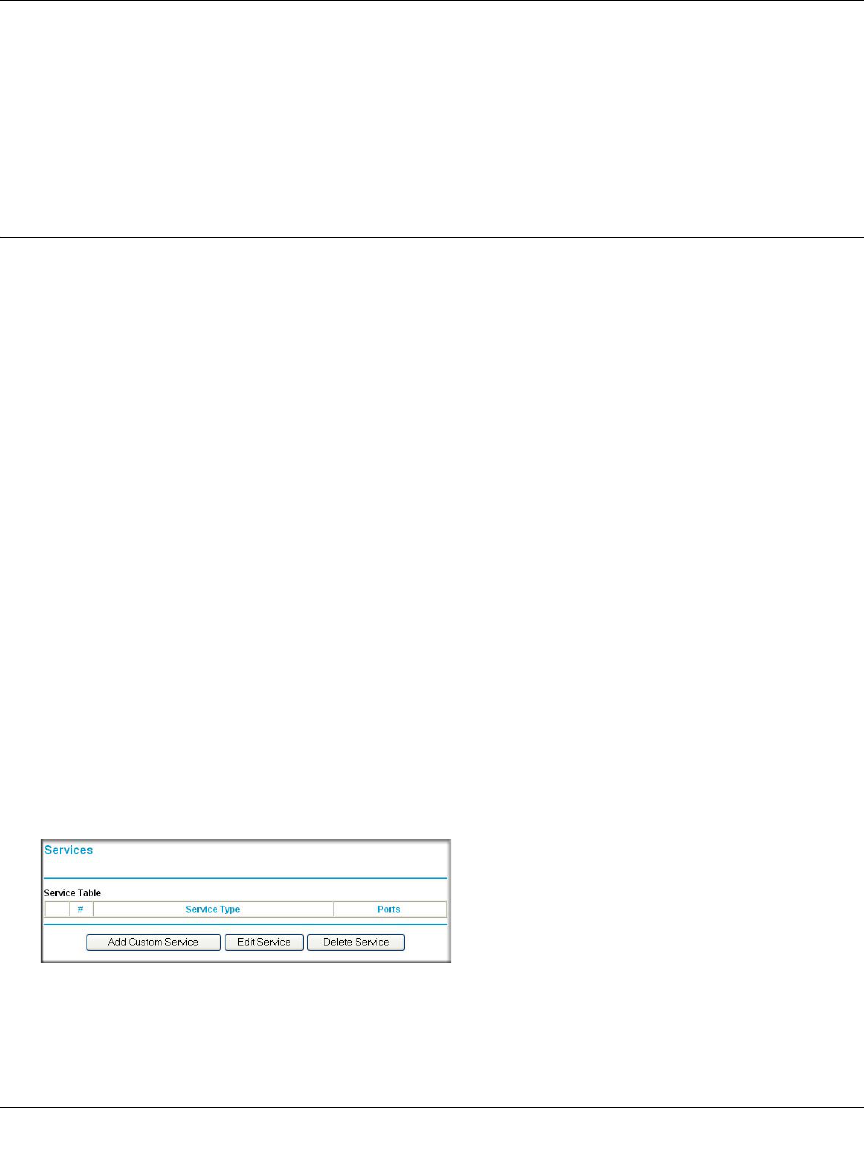
Reference Manual for the ADSL Modem Wireless Router DG834G
4-12 Protecting Your Network
v1.0, January 2006
For any traffic attempting to pass through the firewall, the packet information is subjected to the
rules in the order shown in the Rules Table, beginning at the top and proceeding to the default rules
at the bottom. In some cases, the order of precedence of two or more rules may be important in
determining the disposition of a packet. The Move button allows you to relocate a defined rule to a
new position in the table.
Services
Services are functions performed by server computers at the request of client computers. For
example, Web servers serve Web pages, time servers serve time and date information, and game
hosts serve data about other players’ moves. When a computer on the Internet sends a request for
service to a server computer, the requested service is identified by a service or port number. This
number appears as the destination port number in the transmitted IP packets. For example, a packet
that is sent with destination port number 80 is an HTTP (Web server) request.
The service numbers for many common protocols are defined by the Internet Engineering Task
Force (IETF) and published in RFC1700, “Assigned Numbers.” Service numbers for other
applications are typically chosen from the range 1024 to 65535 by the authors of the application.
Although the DG834G v3 already holds a list of many service port numbers, you are not limited to
these choices. Use the procedure below to create your own service definitions.
How to Define Services
1. Log in to the modem router at its default LAN address of http://192.168.0.1 with its default
User Name of admin, default password of password, or using whatever Password and LAN
address you have chosen for the modem router.
2. Select the Services link of the Security menu to display the Services menu shown:
• To create a new Service, click the Add Custom Service button.
Figure 4-9
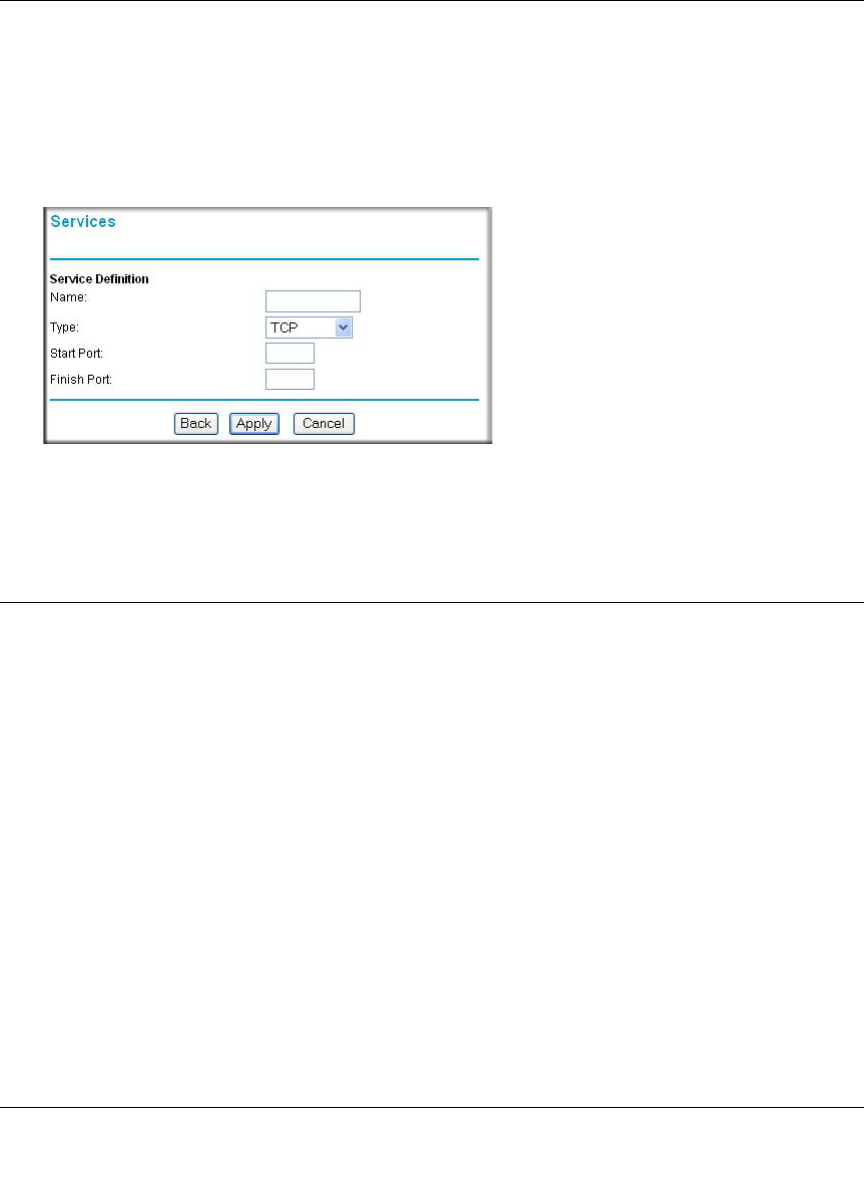
Reference Manual for the ADSL Modem Wireless Router DG834G
Protecting Your Network 4-13
v1.0, January 2006
• To edit an existing Service, select its button on the left side of the table and click Edit
Service.
• To delete an existing Service, select its button on the left side of the table and click Delete
Service.
3. Use the page shown below to define or edit a service.
4. Click Apply to save your changes.
Setting Times and Scheduling Firewall Services
The ADSL Modem Wireless Router uses the Network Time Protocol (NTP) to obtain the current
time and date from one of several Network Time Servers on the Internet.
How to Set Your Time Zone
In order to localize the time for your log entries, you must specify your Time Zone:
1. Log in to the modem router at its default LAN address of http://192.168.0.1 with its default
User Name of admin, default password of password, or using whatever Password and LAN
address you have chosen for the modem router.
Figure 4-10
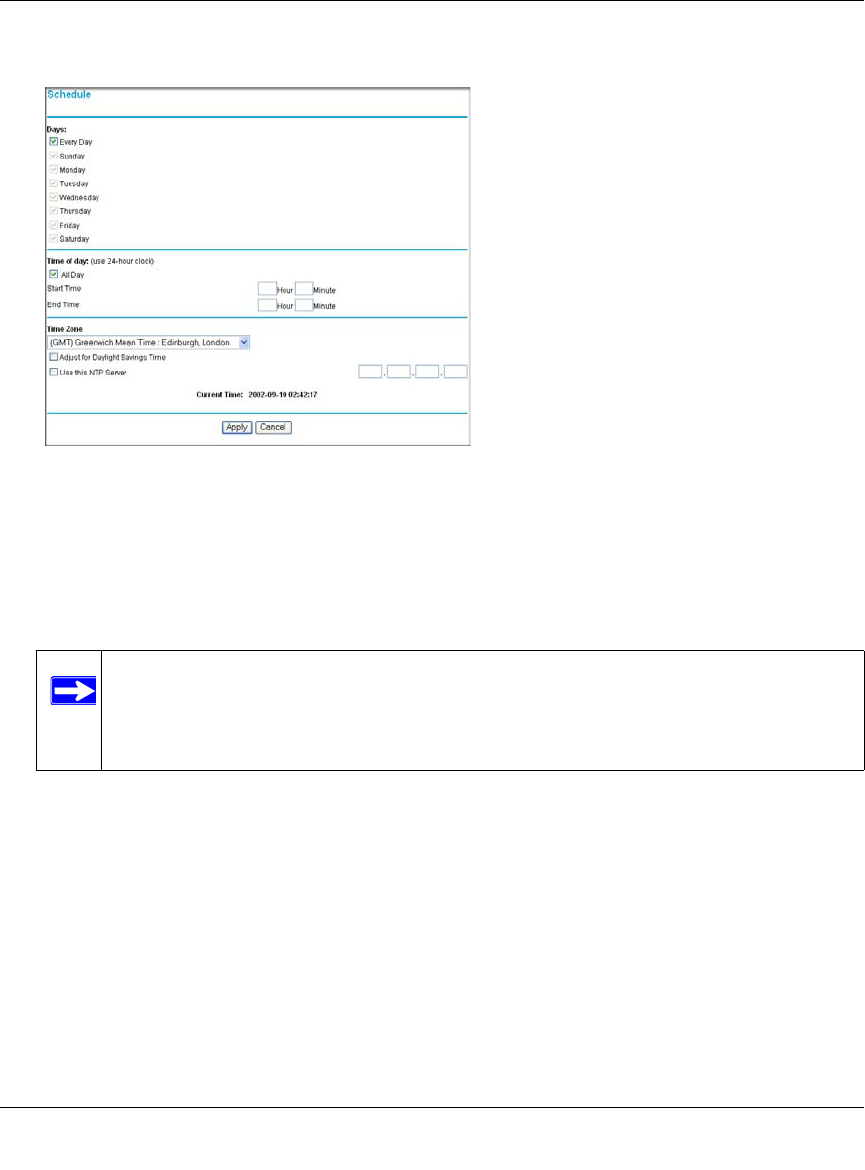
Reference Manual for the ADSL Modem Wireless Router DG834G
4-14 Protecting Your Network
v1.0, January 2006
2. Select the Schedule link of the Security menu to display menu shown below.
3. Select your time zone. This setting will be used for the blocking schedule according to your
local time zone and for time-stamping log entries.
Select the Adjust for daylight savings time check box if your time zone is currently in
daylight savings time.
4. The modem router has a list of NETGEAR NTP servers. If you would prefer to use a particular
NTP server as the primary server, enter its IP address under Use this NTP Server.
5. Click Apply to save your settings.
Figure 4-11
Note: If your region uses Daylight Savings Time, you must manually select Adjust
for Daylight Savings Time on the first day of Daylight Savings Time, and
clear it at the end. Enabling Daylight Savings Time will cause one hour to be
added to the standard time.

Reference Manual for the ADSL Modem Wireless Router DG834G
Protecting Your Network 4-15
v1.0, January 2006
How to Schedule Firewall Services
If you enabled services blocking in the Block Services menu or Port forwarding in the Ports menu,
you can set up a schedule for when blocking occurs or when access is not restricted.
1. Log in to the modem router at its default LAN address of http://192.168.0.1 with its default
User Name of admin, default password of password, or using whatever Password and LAN
address you have chosen for the modem router.
2. Select the Schedule link of the Security menu to display menu shown above.
3. To block Internet services based on a schedule, select Every Day or select one or more days. If
you want to limit access completely for the selected days, select All Day. Otherwise, to limit
access during certain times for the selected days, enter Start Blocking and End Blocking times.
4. Enter the values in 24-hour time format. For example, 10:30 am would be 10 hours and 30
minutes and 10:30 pm would be 22 hours and 30 minutes. If you set the start time after the end
time, the schedule will be effective through midnight the next day.
5. Click Apply to save your changes.
Trend Micro Home Network Security
You can enable Home Network Security as if you didn’t do so when you originally set up your
router. Home routers provide an enhanced Internet experience, but the likelihood of attacks also
increases. Trend Micro Home Network Security addresses the security needs of computers
accessing the Internet via home routers.
Note: The 54 Mbps ADSL Modem Wireless Router Model DG834G supports Home
Network Security. To take advantage of this feature you must register an account
with Trend Micro. For more information, refer to the Home Network Security
Quick Start Guide on the NETGEAR Resource CD, or to
http://www.trendmicro.com/offers/netgear. The Trend Micro software requires
Microsoft Internet Explorer 5.5 or higher.
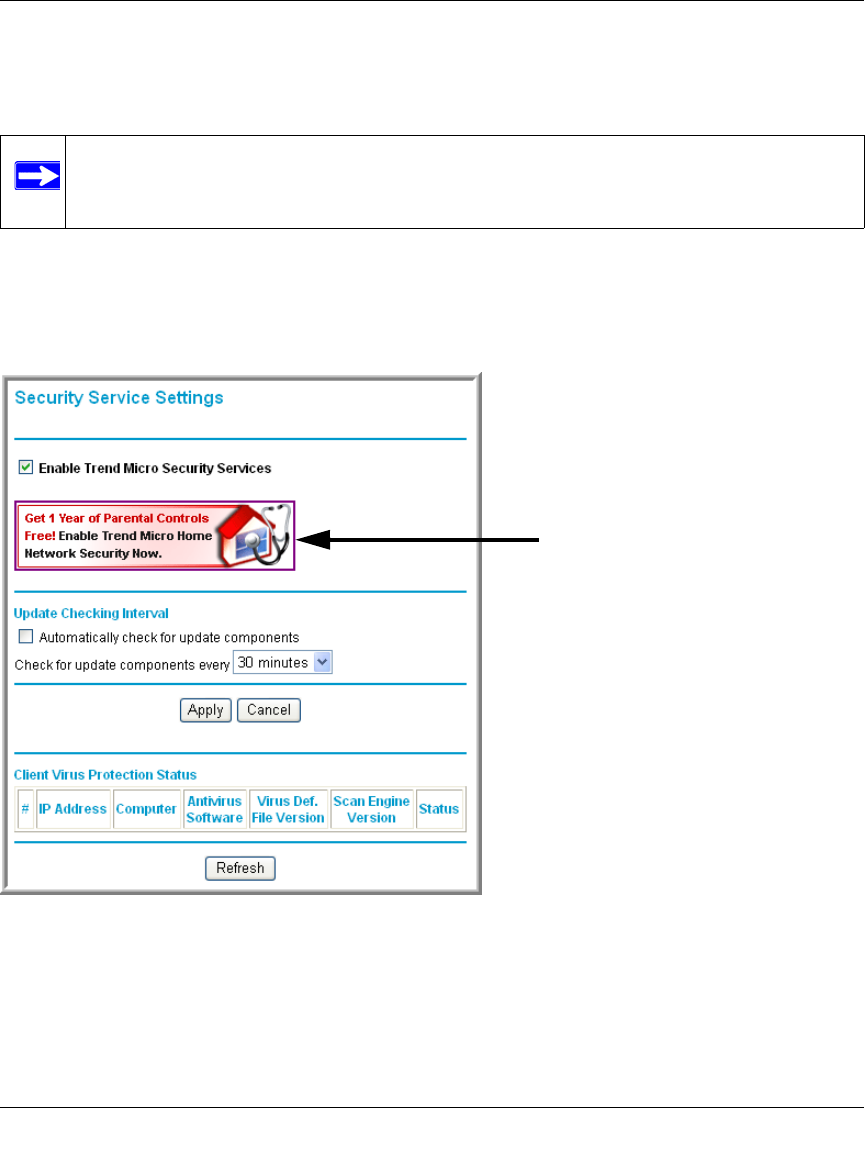
Reference Manual for the ADSL Modem Wireless Router DG834G
4-16 Protecting Your Network
v1.0, January 2006
To begin using Home Network Security, configure the Security Service and Parental Controls
menus on your ADSL Modem Wireless Router. Each screen has a GUI button to click that will
take you to the Trend Micro Web site to open your Trend Micro account.
Security Service Settings
Click Security Service under Content Filtering on the Main menu to get the Security Service
Settings menu shown below:
To install Home Network Security, click the Trend Micro banner and then follow the on-screen
instructions. For assistance, refer to the Home Network Security Quick Start Guide included on the
NETGEAR Resource CD. (You can download this document and the Home Network Security
User’s Guide at http://www.trendmicro.com/en/support/tmss/netgear.)
Note: Because of overlapping functionality, the Block Sites feature, described in “How to
Block Keywords and Sites” on page 4-3, is disabled if you enable Trend Micro
Home Security.
Figure 4-12
Click this banner to install the
Trend Micro dashboard and
set up your Trend Micro account.

Reference Manual for the ADSL Modem Wireless Router DG834G
Protecting Your Network 4-17
v1.0, January 2006
• Enable Trend Micro Security Services. Select this check box and then click Apply to enable
the Security Service features on this page (automatic updates and Client Virus Protection
Status information).
•Automatically check for update components. Select this check box to automatically check
for updates to Trend Micro scanning components. Choose the desired checking interval from
the list, and then click Apply.
•Client Virus Protection Status. Provides information on all computers on your network.
–IP Address: The computer’s IP address
–Computer Name: The name of the computer (as shown in Control Panel > System)
–Antivirus Software: The type of antivirus software installed on the computer
–Virus Def. File Version: The version of the virus pattern file in use by the antivirus
software
–Scan Engine: The version of the scan engine in use by the antivirus software
–Status: Indicates if the virus pattern file or scan engine require updating (if no recognized
antivirus software is found, the status is “Potential Threat”)
Note: If your ISP bills by the amount of time or traffic you use, set the update
frequency to once a day.
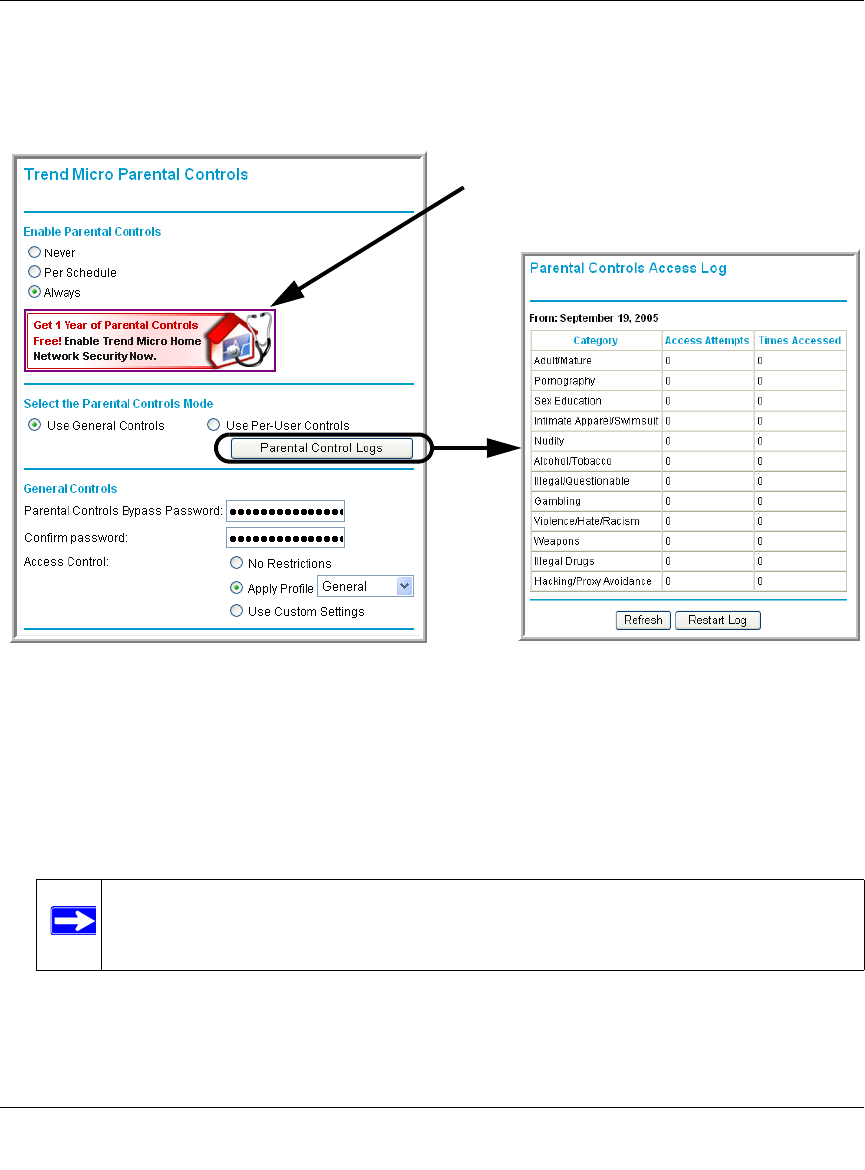
Reference Manual for the ADSL Modem Wireless Router DG834G
4-18 Protecting Your Network
v1.0, January 2006
Parental Controls Settings
Click Parental Controls under Content Filtering on the Main menu to get the Trend Micro
Parental Controls menu shown below:
Figure 4-13: Trend Micro Parental Controls menu
To configure Parental Controls:
• Click Always to turn on Parental Controls all the time.
• Click Never to turn off Parental Controls.
• Click Per Schedule to turn on Parental Controls at the times specified on the Schedule page.
Note: After changing Parental Controls settings, click Apply to save changes.
Click this banner to install the Trend Micro
dashboard and set up your Trend Micro
account.

Reference Manual for the ADSL Modem Wireless Router DG834G
Protecting Your Network 4-19
v1.0, January 2006
To select Parental Controls Mode:
• Click Use General Controls to select General mode. In General mode, one access profile
applies to all users.
• Click Use Per-User Controls to select Per-User mode. In Per-User mode, each user has an
individual access profile.
To configure General mode:
1. Enter a password in the Parental Controls Bypass Password box, re-enter it in the Confirm
password box, and then click Apply. This password allows users to access pages that are
blocked by Parental Controls.
2. Select the access profile that will apply to all users, as follows:
• To select a predefined profile, click Apply Profile and then choose a profile from the list.
• To create a custom profile, click Use Custom Settings and then select the check boxes as
desired. (For additional choices, click More Categories).
• To allow unrestricted Internet access, click No Restrictions.
3. Click Apply.
To configure Per-User mode:
The User Account Information table in Per-User mode shows each user’s name, access profile, and
status. Users with Active status can access the Internet sites permitted by their access profiles.
Users with Inactive status cannot log in and cannot access any Internet sites.
To add a new user:
1. Click Add. Type the new user’s login name and password, and then re-enter the password in
the Confirm password box.
2. Select the new user’s status. To allow Internet access, click Active. To completely disable this
user’s Internet access, click Inactive.
3. Select the access profile that will apply to this user, as follows:
• To select a predefined profile, click Apply Profile and then choose a profile from the list.
Note: When in Per-User mode, everyone accessing the Internet through the router is
required to log in.

Reference Manual for the ADSL Modem Wireless Router DG834G
4-20 Protecting Your Network
v1.0, January 2006
• To create a custom profile, click Use Custom Settings and then select the check boxes as
desired. (For additional choices, click More Categories).
• To allow unrestricted Internet access, click No Restrictions.
4. Click Apply.
To change a user’s account information:
1. Select the user’s name in the User Account Information table and then click Edit.
2. Make the desired changes, and then click Apply.
To delete a user, select the user’s name in the User Account Information table and then click
Delete.
Parental Controls Logs
Click Parental Controls Logs to view attempts to access restricted sites, and actual accesses.
Blocking criteria for potentially offensive categories
Trend Micro has defined twelve potentially offensive categories of Web sites. Following are the
blocking criteria for each category:
•Adult/Mature Content: Sites that contain material of an adult nature but without excessive
violence, sexual content, or nudity. These sites may include profane or vulgar content not
appropriate for children.
•Alcohol/Tobacco: Sites that promote or sell alcohol and tobacco products. Includes sites that
glamorize or otherwise encourage alcohol or tobacco use. Does not include sites that sell
alcohol or tobacco as a subset of another business.
•Gambling: Sites where users can place bets or participate in betting pools (including lotteries)
online. Also includes sites that provide information, assistance, recommendations, or training
on placing bets or participating in games of chance. Does not include sites that sell gambling-
related products or machines. Also does not include offline casino and hotel sites, unless
meeting one of the foregoing criteria).
•Hacking/Proxy Avoidance: Sites providing information on illegal or questionable access to,
or use of, communications equipment and software, or that provide information on how to
bypass proxy server features or gain unauthorized access to URLs.
•Illegal Drugs: Sites that promote, offer, sell, supply, or advocate the illegal use, cultivation,
manufacture, or distribution of drugs, pharmaceuticals, intoxicating plants and chemicals, and
related paraphernalia.

Reference Manual for the ADSL Modem Wireless Router DG834G
Protecting Your Network 4-21
v1.0, January 2006
•Illegal/Questionable: Sites that advocate or advise on performing illegal acts such as service
theft, evading law enforcement, fraud, burglary techniques, and plagiarism. Also includes sites
that provide or sell questionable educational materials, such as term papers.
•Intimate Apparel/Swimsuit: Sites that contain images of swimsuits, intimate apparel, or
other suggestive clothing. Does not include sites selling undergarments as a subset of another
business.
•Nudity: Sites containing nude or seminude depictions of the human body. Such depictions
need not be sexual in intent or effect. May include sites containing nude paintings or photo
galleries of an artistic nature. This category includes nudist or naturist sites.
•Pornography: Sites that contain sexually explicit material.
•Sex Education: Sites that provide information (sometimes graphic) on reproduction, sexual
development, safe sex practices, sexuality, birth control, and sexual development. Also
includes sites that offer tips for better sex as well as products used for sexual enhancement.
•Violence/Hate/Racism: Sites depicting or advocating physical harm to people or property.
Includes sites that convey hostility or aggression toward, or the denigration of, an individual or
group on the basis of race, religion, gender, nationality, ethnic origin, and so forth.
•Weapons: Sites that sell, review, or describe guns, knives, martial arts devices, and related
accessories. Does not include sites that promote weapons collecting, or groups that either
support or oppose weapons ownership.

Reference Manual for the ADSL Modem Wireless Router DG834G
4-22 Protecting Your Network
v1.0, January 2006
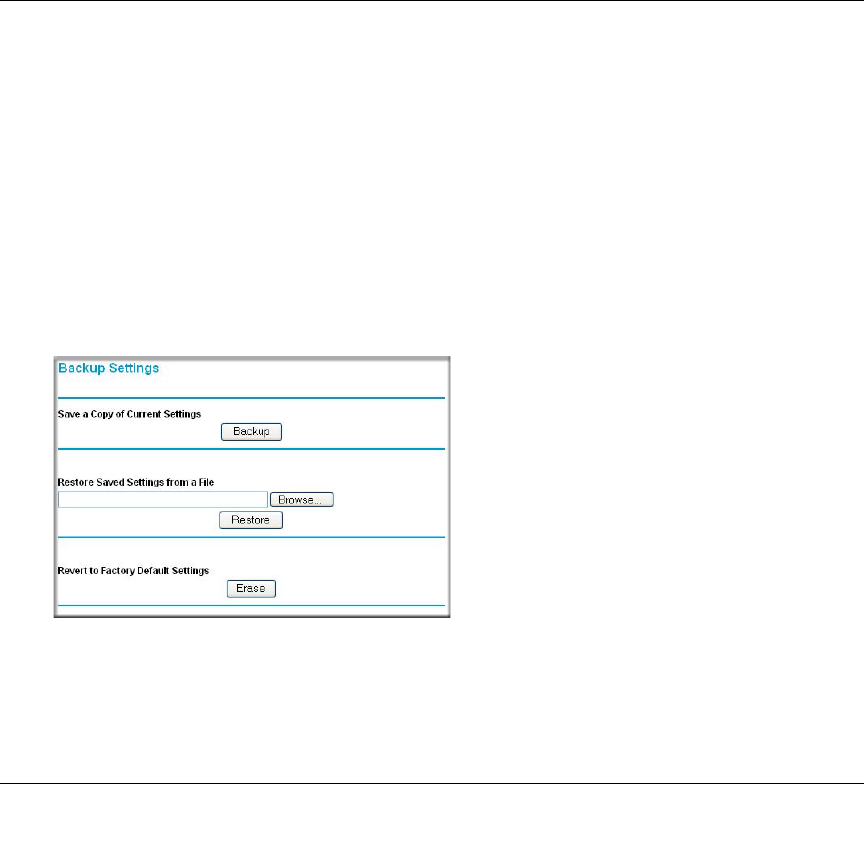
Managing Your Network 5-1
v1.0, January 2006
Chapter 5
Managing Your Network
This chapter describes how to perform network management tasks with your 54 Mbps ADSL
Modem Wireless Router Model DG834G.
Backing Up, Restoring, or Erasing Your Settings
The configuration settings of the ADSL Modem Wireless Router are stored in a configuration file
in the modem router. This file can be backed up to your computer, restored, or reverted to factory
default settings. The procedures below explain how to do these tasks.
How to Back Up the Configuration to a File
1. Log in to the modem router at its default LAN address of http://192.168.0.1 with its default
User Name of admin, default password of password, or using whatever User Name,
Password and LAN address you have chosen for the modem router.
2. From the Maintenance heading of the Main Menu, select the Backup Settings menu shown.
3. Click Backup to save a copy of the current settings.
4. Store the .cfg file on a computer on your network.
Figure 5-1

Reference Manual for the ADSL Modem Wireless Router DG834G
5-2 Managing Your Network
v1.0, January 2006
How to Restore the Configuration from a File
1. Log in to the modem router at its default LAN address of http://192.168.0.1 with its default
User Name of admin, default password of password, or using whatever User Name,
Password and LAN address you have chosen for the modem router.
2. From the Maintenance heading of the Main Menu, select the Settings Backup menu.
3. Enter the full path to the file on your network or click the Browse button to locate the file.
4. When you have located the .cfg file, click the Restore button to upload the file to the modem
router.
5. The modem router will then reboot automatically.
How to Erase the Configuration
It is sometimes desirable to restore the modem router to the factory default settings. This can be
done by using the Erase function.
1. To erase the configuration, from the Maintenance menu Settings Backup link, click the Erase
button on the screen.
2. The modem router will then reboot automatically.
After an erase, the modem router's password will be password, the LAN IP address will be
192.168.0.1, and the modem router's DHCP client will be enabled.
Upgrading the Modem Router’s Firmware
The software of the ADSL Modem Wireless Router is stored in FLASH memory, and can be
upgraded as new software is released by NETGEAR.
Upgrade files can be downloaded from NETGEAR's Web site. If the upgrade file is compressed
(.ZIP file), you must first extract the binary (.BIN or .IMG) file before uploading it to the modem
router.
Note: To restore the factory default configuration settings without knowing the login
password or IP address, you must use the Default Reset button on the rear panel of
the modem router. See “The Router’s Rear Panel” on page 2-9.
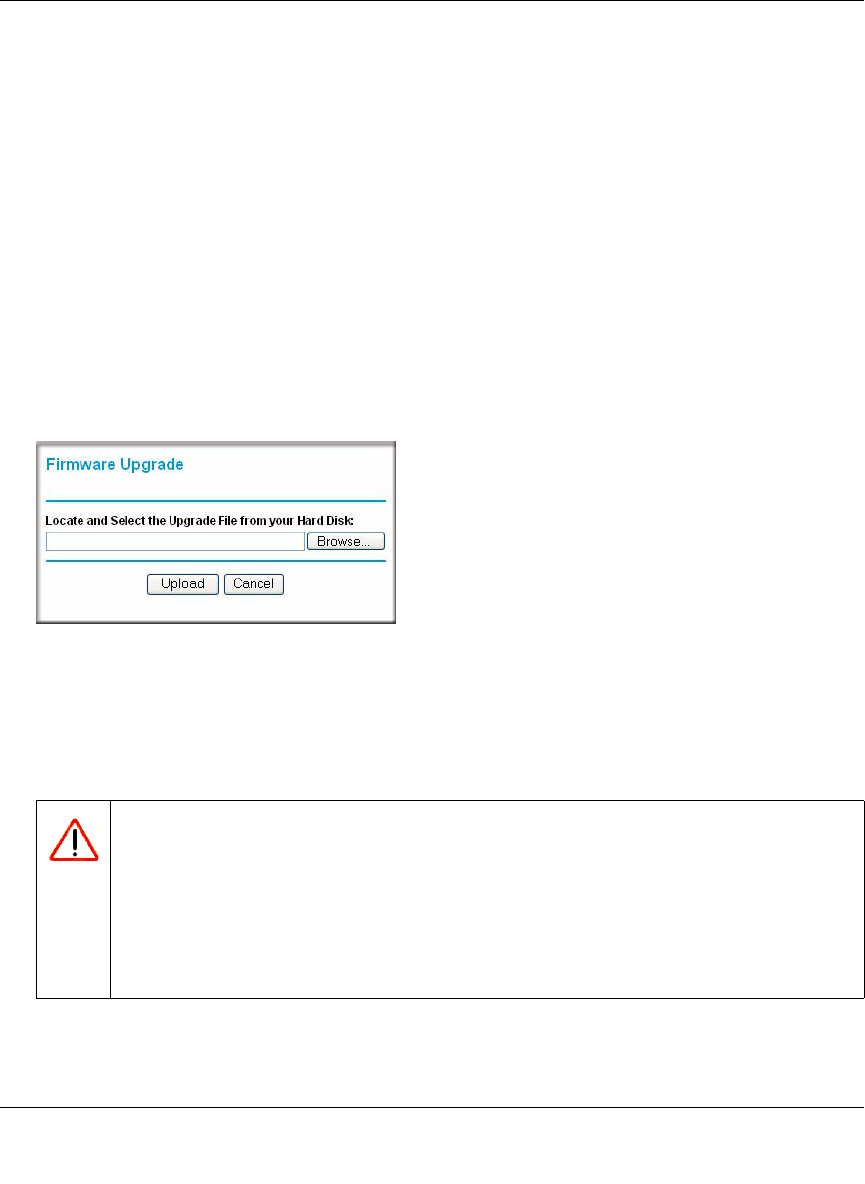
Reference Manual for the ADSL Modem Wireless Router DG834G
Managing Your Network 5-3
v1.0, January 2006
How to Upgrade the Modem Router Firmware
NETGEAR recommends that you back up your configuration before doing a firmware upgrade.
After the upgrade is complete, you may need to restore your configuration settings.
1. Download and unzip the new software file from NETGEAR.
The Web browser used to upload new firmware into the modem router must support HTTP
uploads. NETGEAR recommends using Microsoft Internet Explorer 5.0 or above, or Netscape
Navigator 4.7 or above.
2. Log in to the modem router at its default LAN address of http://192.168.0.1 with its default
User Name of admin, default password of password, or using whatever User Name,
Password and LAN address you have chosen for the modem router.
3. From the Main Menu of the browser interface, under the Maintenance heading, select the
Modem Router Upgrade heading to display the menu shown.
4. In the Modem Router Upgrade menu, click the Browse to locate the binary (.BIN or .IMG)
upgrade file.
5. Click Upload.
Figure 5-2
Warning: When uploading software to the modem router, it is important not to
interrupt the Web browser by closing the window, clicking a link, or
loading a new page. If the browser is interrupted, it may corrupt the
software. When the upload is complete, your modem router will
automatically restart. The upgrade process will typically take about one
minute. In some cases, you may need to clear the configuration and
reconfigure the modem router after upgrading.
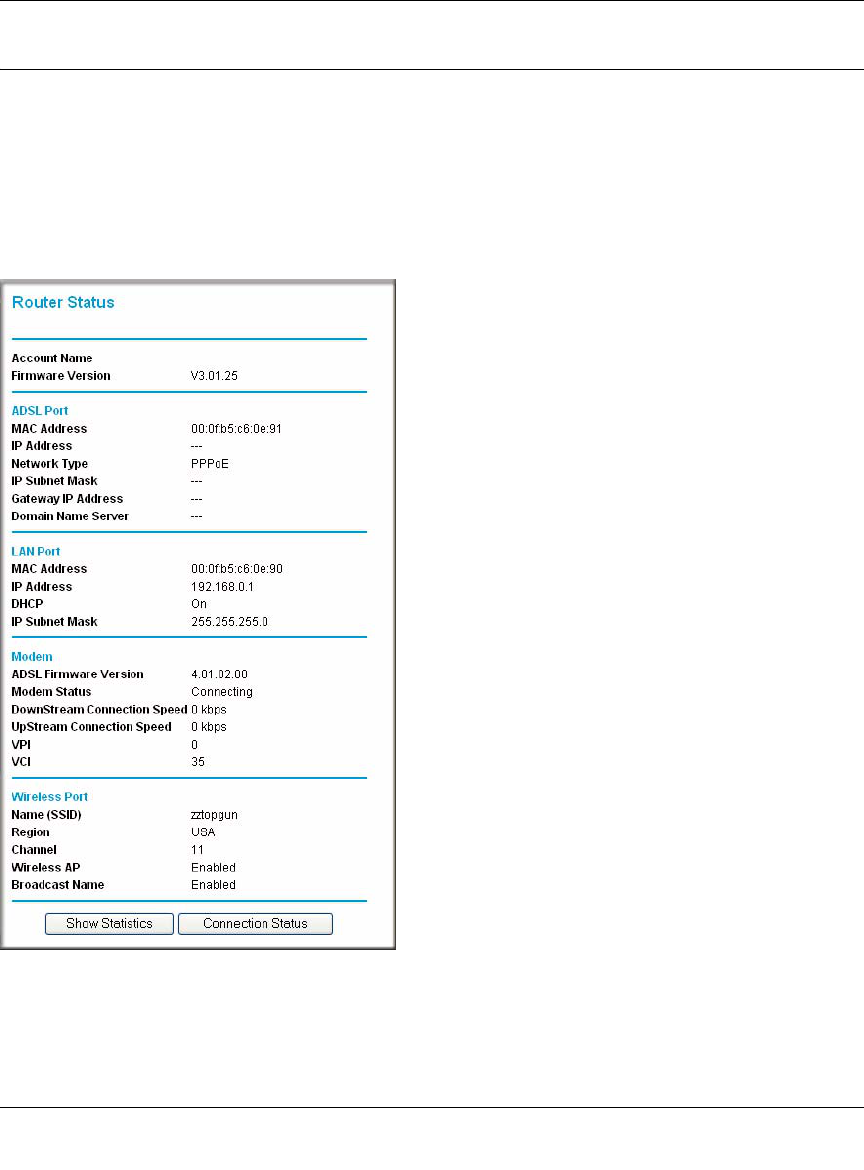
Reference Manual for the ADSL Modem Wireless Router DG834G
5-4 Managing Your Network
v1.0, January 2006
Network Management Information
The DG834G v3 provides a variety of status and usage information which is discussed below.
Viewing Modem Router Status and Usage Statistics
From the Main Menu, under Maintenance, click Modem Router Status to view this screen.
The Modem Router Status menu provides status and usage information.
Figure 5-3

Reference Manual for the ADSL Modem Wireless Router DG834G
Managing Your Network 5-5
v1.0, January 2006
This screen shows the following parameters:
Table 5-1. Menu 3.2 - Modem Router Status Fields
Field Description
Account Name The Host Name assigned to the modem router in the Basic Settings
menu.
Firmware Version This field displays the modem router firmware version.
ADSL Port These parameters apply to the Internet (ADSL) port of the modem
router.
MAC Address This field displays the Ethernet MAC address being used by the Internet
(ADSL) port of the modem router.
IP Address This field displays the IP address being used by the Internet (ADSL)
port of the modem router. If no address is shown, the modem router
cannot connect to the Internet.
Network Type The network type depends is determined by your ISP. Common network
types are PPPoE and PPPoA.
IP Subnet Mask This field displays the IP Subnet Mask being used by the Internet
(ADSL) port of the modem router.
Domain Name Server
(DNS) This field displays the DNS Server IP addresses being used by the
modem router. These addresses are usually obtained dynamically from
the ISP.
LAN Port These parameters apply to the Local (ADSL) port of the modem router.
MAC Address This field displays the Ethernet MAC address being used by the Local
(LAN) port of the modem router.
IP Address This field displays the IP address being used by the Local (LAN) port of
the modem router. The default is 192.168.0.1.
DHCP If OFF, the modem router will not assign IP addresses to PCs on the
LAN.
If ON, the modem router will assign IP addresses to PCs on the LAN.
IP Subnet Mask This field displays the IP Subnet Mask being used by the Local (LAN)
port of the modem router. The default is 255.255.255.0.
Modem These parameters apply to the Local (WAN) port of the modem router.
ADSL Firmware Version The version of the firmware.
Modem Status The connection status of the modem.
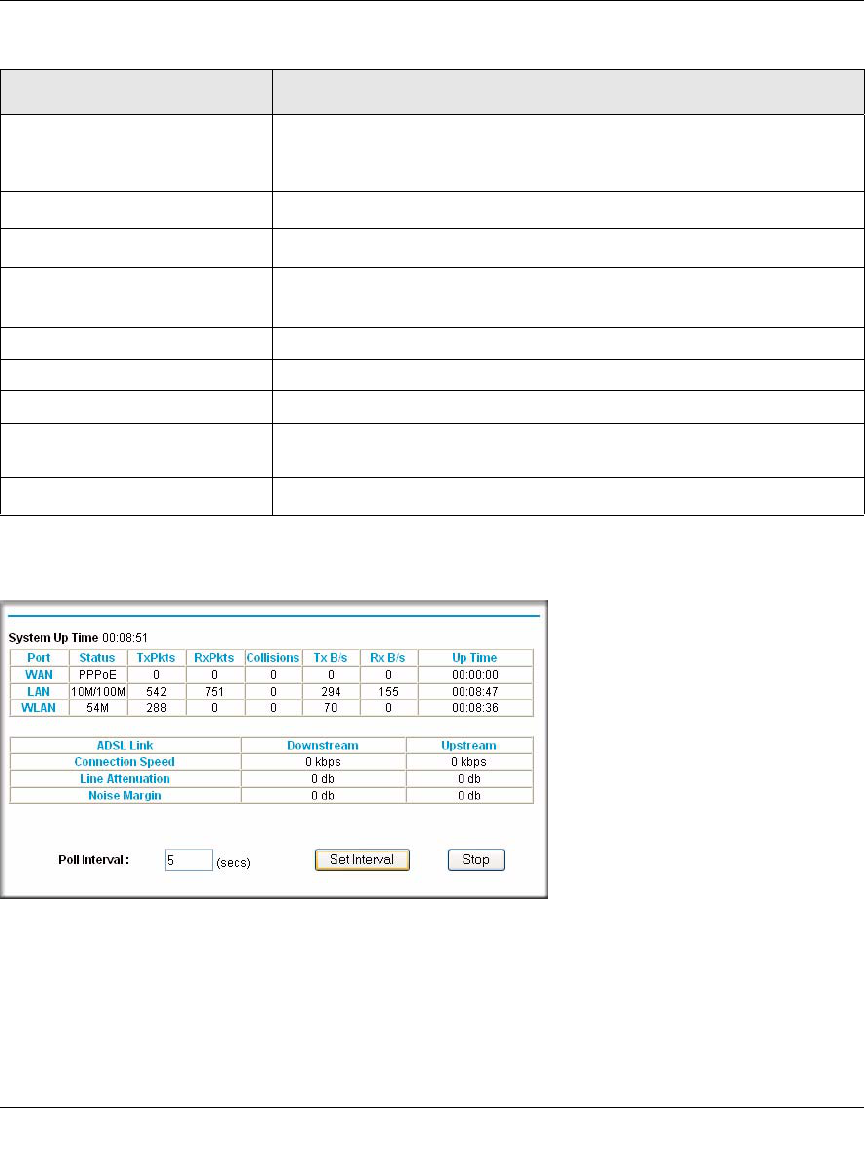
Reference Manual for the ADSL Modem Wireless Router DG834G
5-6 Managing Your Network
v1.0, January 2006
Click the Show Statistics button to display modem router usage statistics, as shown below:
Downstream Speed The speed at which the modem is receiving data from the ADSL line.
Upstream Speed The speed at which the modem is transmitting data to the ADSL line.
VPI The Virtual Path Identifier setting.
VCI The Virtual Channel Identifier setting.
Wireless Port These are the settings as set in the Wireless Settings page; see
“Understanding Wireless Settings” in Chapter 3 for details.
Name (SSID) The Service Set ID, also known as the wireless network name.
Region The country where the unit is set up for use.
Channel The current channel, which determines the operating frequency.
Wireless AP Indicates if the Access Point feature is disabled or not. If not enabled, the
Wireless LED on the front panel will be off.
Broadcast Name Indicates if the DG834G v3 is configured to broadcast its SSID.
Figure 5-4
Table 5-1. Menu 3.2 - Modem Router Status Fields (continued)
Field Description

Reference Manual for the ADSL Modem Wireless Router DG834G
Managing Your Network 5-7
v1.0, January 2006
This screen shows the following statistics:
Table 5-2. Router Statistics Fields
Field Description
WAN or LAN Port The statistics for the WAN (Internet) and LAN ports.
Status The link status of the port.
TxPkts The number of packets transmitted on this port since reset or manual clear.
RxPkts The number of packets received on this port since reset or manual clear.
Collisions The number of collisions on this port since reset or manual clear.
Tx B/s The current line utilization—percentage of current bandwidth used on this port.
Rx B/s The average line utilization for this port.
Up Time The time elapsed since the last power cycle or reset.
ADSL Link Downstream
or Upstream The statistics for the upstream and downstream ADSL link. These statistics will
be of interest to your technical support representative if you are having
problems obtaining or maintaining a connection.
Connection Speed Typically, the downstream speed is faster than the upstream speed.
Line Attenuation The line attenuation will increase the further you are physically located from
your ISP’s facilities.
Noise Margin This is the signal-to-noise ratio and is a measure of the quality of the signal on
the line.
Poll Interval Specifies the interval at which the statistics are updated in this window. Click
Stop to freeze the display.
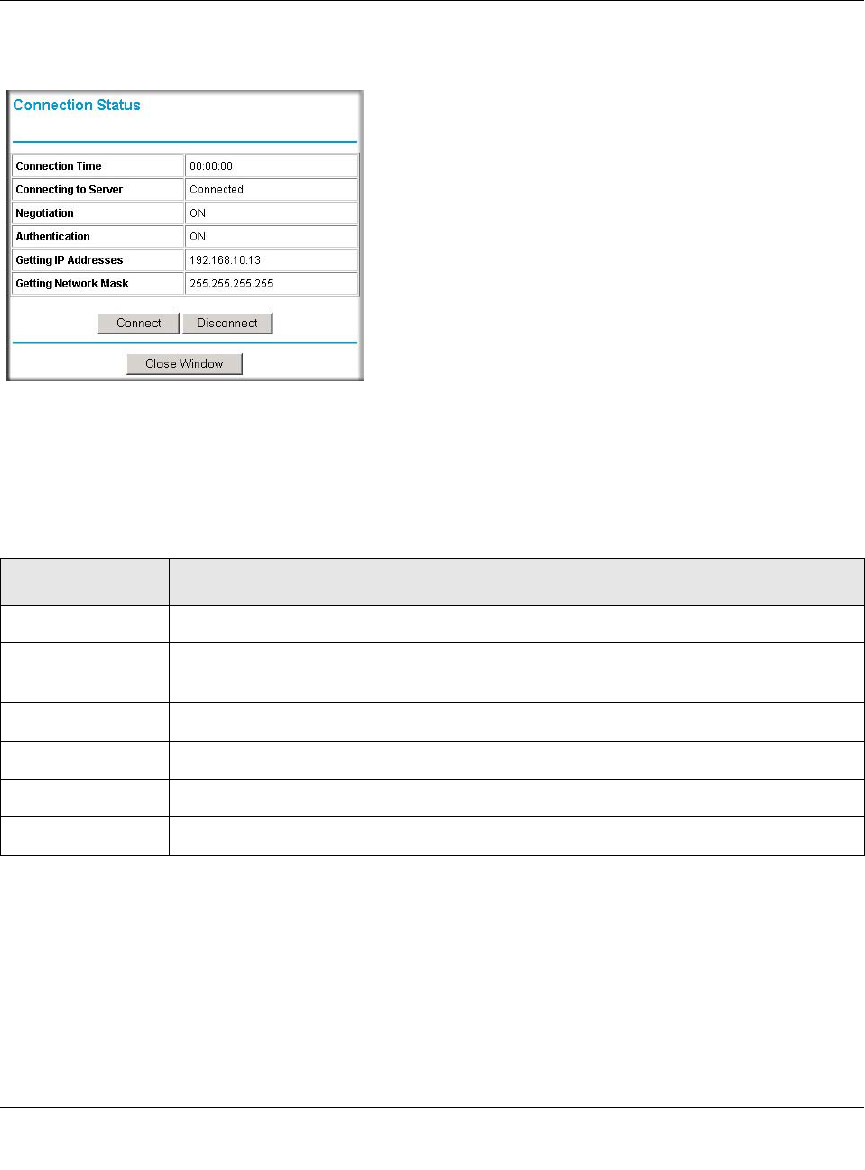
Reference Manual for the ADSL Modem Wireless Router DG834G
5-8 Managing Your Network
v1.0, January 2006
Click the Connection Status button to display modem router connection status, shown below:
This screen shows the following statistics:
Figure 5-5
Table 5-3. Connection Status Fields for PPPoA
Field Description
Connection Time The time elapsed since the last connection to the Internet via the ADSL port.
Connecting to
Sender The connection status.
Negotiation ON or OFF
Authentication ON or OFF
IP Address The IP Address assigned to the WAN port by the ADSL Internet Service Provider.
Network Mask The Network Mask assigned to the WAN port by the ADSL Internet Service Provider.
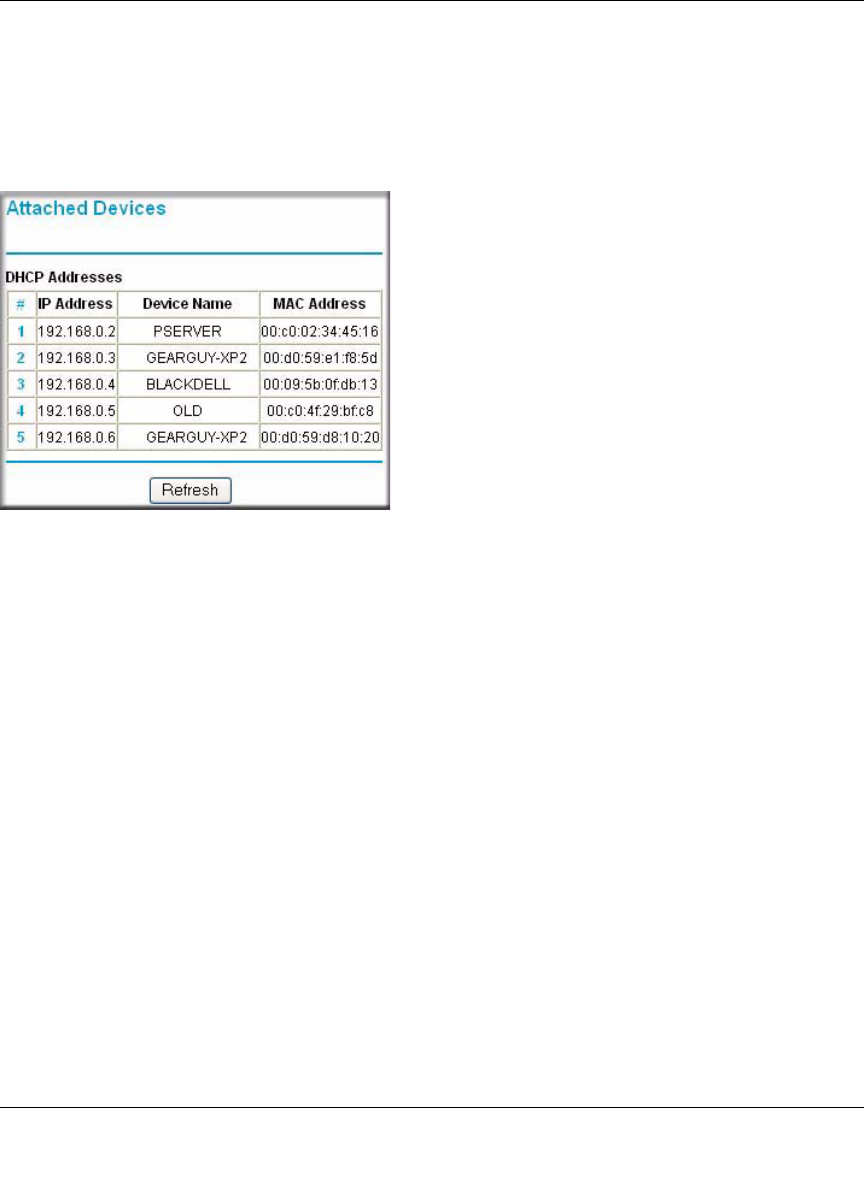
Reference Manual for the ADSL Modem Wireless Router DG834G
Managing Your Network 5-9
v1.0, January 2006
Viewing Attached Devices
The Attached Devices menu contains a table of all IP devices that the modem router has
discovered on the local network. From the Main Menu of the browser interface, under the
Maintenance heading, select Attached Devices to view the table, shown:
For each device, the table shows the IP address, Device Name if available, and the Ethernet MAC
address. Note that if the modem router is rebooted, the table data is lost until the modem router
rediscovers the devices. To force the modem router to look for attached devices, click the Refresh
button.
Viewing, Selecting, and Saving Logged Information
The modem router will log security-related events such as denied incoming service requests,
hacker probes, and administrator logins. If you enabled content filtering in the Block Sites menu,
the Logs page can show you when someone on your network tries to access a blocked site. If you
enabled e-mail notification, you will receive these logs in an e-mail message. If you do not have e-
mail notification enabled, you can view the logs here.
Figure 5-6

Reference Manual for the ADSL Modem Wireless Router DG834G
5-10 Managing Your Network
v1.0, January 2006
An example of the logs file is shown below.
Figure 5-7

Reference Manual for the ADSL Modem Wireless Router DG834G
Managing Your Network 5-11
v1.0, January 2006
Log entries are described in Table 5-4 below:
Log action buttons are described in Table 5-5 below:
Table 5-4. Security Log entry descriptions
Field Description
Date and Time The date and time the log entry was recorded.
Description or
Action The type of event and what action was taken if any.
Source IP The IP address of the initiating device for this log entry.
Source port and
interface The service port number of the initiating device, and whether it
originated from the LAN or WAN
Destination The name or IP address of the destination device or Web site.
Destination port
and interface The service port number of the destination device, and whether
it’s on the LAN or WAN.
Table 5-5. Security Log action buttons
Field Description
Refresh Refresh the log screen.
Clear Log Clear the log entries.
Send Log Email the log immediately.
Apply Apply the current settings.
Cancel Clear the current settings.

Reference Manual for the ADSL Modem Wireless Router DG834G
5-12 Managing Your Network
v1.0, January 2006
Selecting What Information to Log
Besides the standard information listed above, you can choose to log additional information. Those
optional selections are as follows:
• Attempted access to blocked site
• Connections to the Web-based interface of the modem router
• Modem Router operation (start up, get time, etc.)
• Known DoS attacks and Port Scans
Saving Log Files on a Server
You can choose to write the logs to a computer running a syslog program. To activate this feature,
select to Broadcast on Lan or enter the IP address of the server where the Syslog file will be
written.
Examples of Log Messages
Following are examples of log messages. In all cases, the log entry shows the timestamp as: Day,
Year-Month-Date Hour:Minute:Second.
Activation and Administration
Tue, 2002-05-21 18:48:39 - NETGEAR activated
[This entry indicates a power-up or reboot with initial time entry.]
Tue, 2002-05-21 18:55:00 - Administrator login successful - IP:192.168.0.2
Thu, 2002-05-21 18:56:58 - Administrator logout - IP:192.168.0.2
[This entry shows an administrator logging in and out from IP address 192.168.0.2.]
Tue, 2002-05-21 19:00:06 - Login screen timed out - IP:192.168.0.2
[This entry shows a time-out of the administrator login.]
Wed, 2002-05-22 22:00:19 - Log emailed
[This entry shows when the log was emailed.]
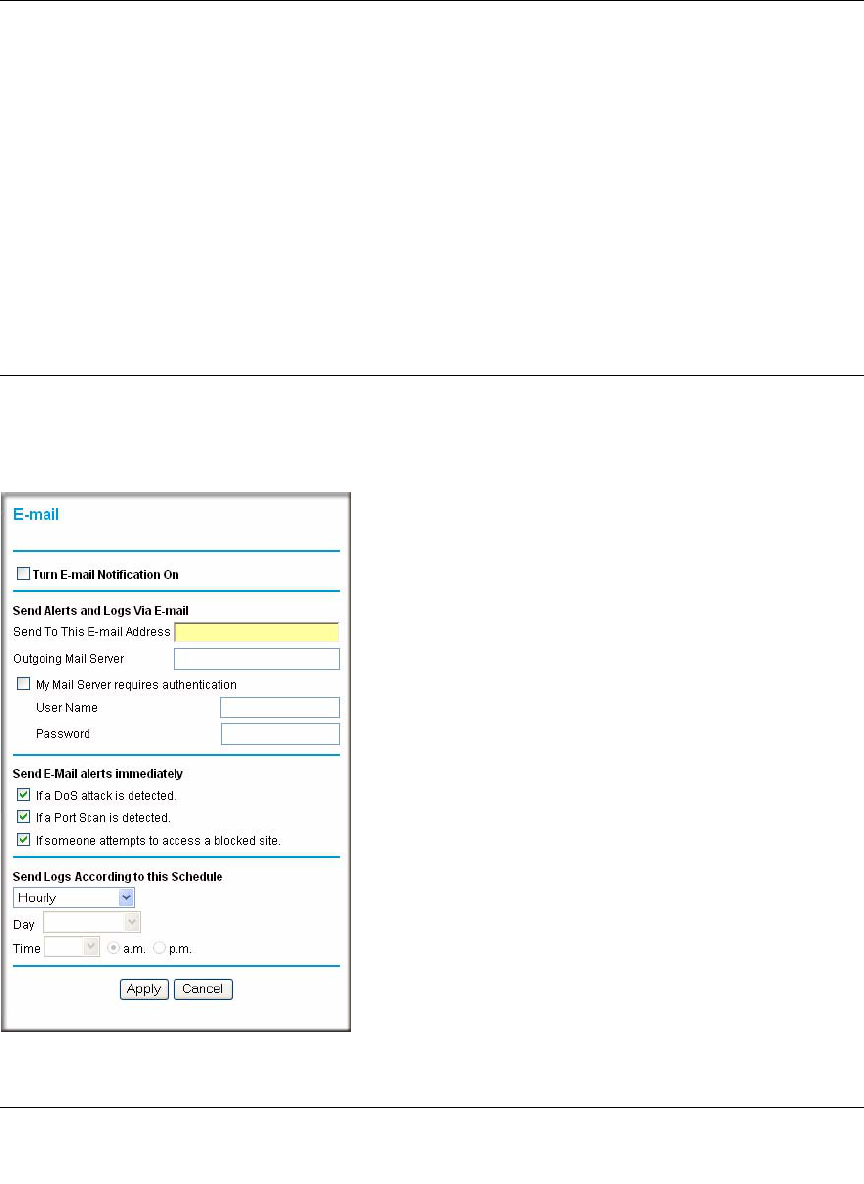
Reference Manual for the ADSL Modem Wireless Router DG834G
Managing Your Network 5-13
v1.0, January 2006
Dropped Packets
Wed, 2002-05-22 07:15:15 - TCP packet dropped - Source:64.12.47.28,4787,WAN -
Destination:134.177.0.11,21,LAN - [Inbound Default rule match]
Sun, 2002-05-22 12:50:33 - UDP packet dropped - Source:64.12.47.28,10714,WAN -
Destination:134.177.0.11,6970,LAN - [Inbound Default rule match]
Sun, 2002-05-22 21:02:53 - ICMP packet dropped - Source:64.12.47.28,0,WAN -
Destination:134.177.0.11,0,LAN - [Inbound Default rule match]
[These entries show an inbound FTP (port 21) packet, User Datagram Protocol (UDP) packet
(port 6970), and Internet Control Message Protocol (ICMP) packet (port 0) being dropped as a
result of the default inbound rule, which states that all inbound packets are denied.]
Enabling Security Event E-mail Notification
In order to receive logs and alerts by e-mail, you must provide your e-mail information in the E-
mail subheading:
Figure 5-8

Reference Manual for the ADSL Modem Wireless Router DG834G
5-14 Managing Your Network
v1.0, January 2006
•Turn e-mail notification on. Select this check box if you want to receive e-mail logs and
alerts from the modem router.
•Send alerts and logs via email.
—Send To This E-mail Address Enter the e-mail address where you want to send the alerts
and logs. Use a full e-mail address, such as ChrisXY@myISP.com.
—Outgoing Mail Server. Enter the name or IP address of the outgoing SMTP mail server of
your ISP (such as mail.myISP.com).
— Check My Mail Server requires authentication if you need to login to your SMTP
server to send E-mail. If you check this box, you must enter the user name and password
for the mail server.
•Send alert immediately. Select the corresponding check box if you would like immediate
notification of a significant security event, such as a known attack, port scan, or attempted
access to a blocked site.
•Send logs according to this schedule. Specifies how often to send the logs: Hourly, Daily,
Weekly, or When Full.
– Day for sending log
Specifies which day of the week to send the log. Relevant when the log is sent weekly or
daily.
– Time for sending log
Specifies the time of day to send the log. Relevant when the log is sent daily or weekly.
If the Weekly, Daily or Hourly option is selected and the log fills up before the specified
period, the log is automatically e-mailed to the specified e-mail address. After the log is sent, it
is cleared from the modem router’s memory. If the modem router cannot e-mail the log file,
the log buffer may fill up. In this case, the modem router overwrites the log and discards its
contents.
Tip: If you cannot remember the above information from when you set up your
e-mail account, check the settings in your e-mail program.
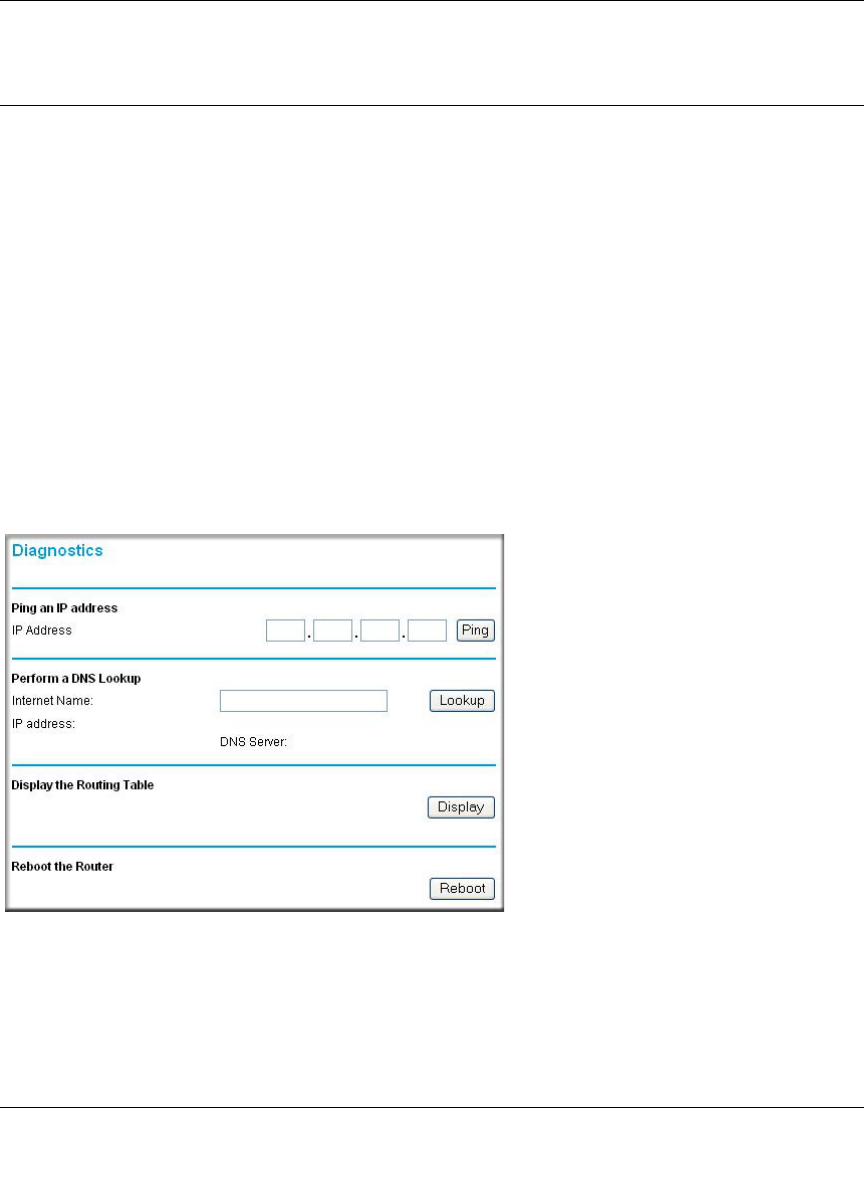
Reference Manual for the ADSL Modem Wireless Router DG834G
Managing Your Network 5-15
v1.0, January 2006
Running Diagnostic Utilities and Rebooting the Modem
Router
The ADSL Modem Wireless Router has a diagnostics feature. You can use the diagnostics menu to
perform the following functions from the modem router:
• Ping an IP Address to test connectivity to see if you can reach a remote host.
• Perform a DNS Lookup to test if an Internet name resolves to an IP address to verify that the
DNS server configuration is working.
• Display the Routing Table to identify what other modem routers the modem router is
communicating with.
• Reboot the modem router to enable new network configurations to take effect or to clear
problems with the modem router’s network connection.
From the Main Menu of the browser interface, under the Maintenance heading, select the Modem
Router Diagnostics heading to display the menu shown.
Figure 5-9
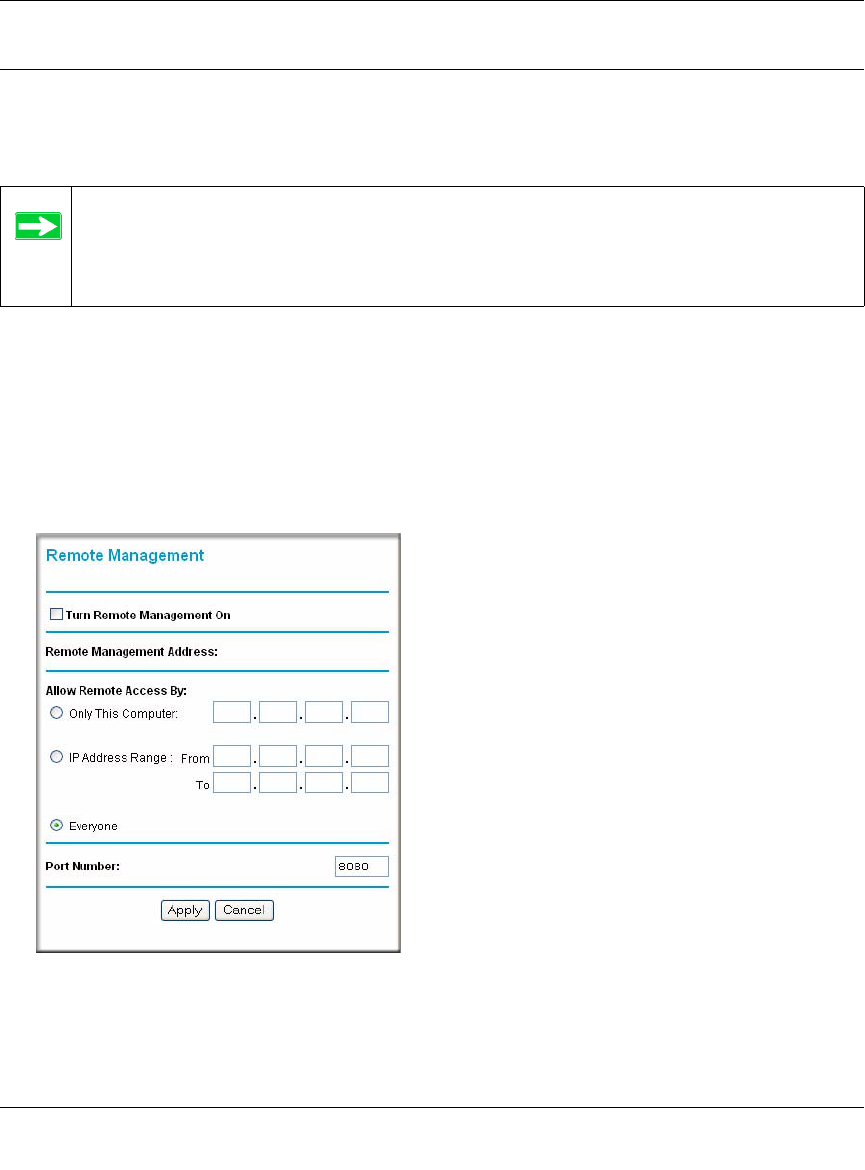
Reference Manual for the ADSL Modem Wireless Router DG834G
5-16 Managing Your Network
v1.0, January 2006
Enabling Remote Management
Using the Remote Management page, you can allow a user or users on the Internet to configure,
upgrade and check the status of your 54 Mbps ADSL Modem Wireless Router Model DG834G.
Configuring Remote Management
1. Log in to the modem router at its default LAN address of http://192.168.0.1 with its default
User Name of admin, default password of password, or using whatever User Name,
Password and LAN address you have chosen for the modem router.
2. From the Advanced section of the main menu, select the Remote Management link.
3. Select the Turn Remote Management On check box.
Tip: Be sure to change the modem router's default password to a very secure password.
The ideal password should contain no dictionary words from any language, and
should be a mixture of letters (both upper and lower case), numbers, and symbols.
Your password can be up to 30 characters.
Figure 5-10

Reference Manual for the ADSL Modem Wireless Router DG834G
Managing Your Network 5-17
v1.0, January 2006
4. Specify what external addresses will be allowed to access the modem router’s remote
management.
For security, restrict access to as few external IP addresses as practical:
• To allow access from any IP address on the Internet, select Everyone.
• To allow access from a range of IP addresses on the Internet, select IP address range.
Enter a beginning and ending IP address to define the allowed range.
• To allow access from a single IP address on the Internet, select Only this Computer.
Enter the IP address that will be allowed access.
5. Specify the Port Number that will be used for accessing the management interface.
Web browser access normally uses the standard HTTP service port 80. For greater security,
you can change the remote management Web interface to a custom port by entering that
number in the box provided. Choose a number between 1024 and 65535, but do not use the
number of any common service port. The default is 8080, which is a common alternate for
HTTP.
6. Click Apply to have your changes take effect.
When accessing your modem router from the Internet, you will type your modem router's
WAN IP address in your browser's Address (in IE) or Location (in Netscape) box, followed by
a colon (:) and the custom port number. For example, if your external address is 134.177.0.123
and you use port number 8080, enter in your browser:
http://134.177.0.123:8080
Note: In this case, the http:// must be included in the address.

Reference Manual for the ADSL Modem Wireless Router DG834G
5-18 Managing Your Network
v1.0, January 2006

Advanced Configuration 6-1
v1.0, January 2006
Chapter 6
Advanced Configuration
This chapter describes how to configure the advanced features of your 54 Mbps ADSL Modem
Wireless Router Model DG834G.
Configuring Advanced Security
The 54 Mbps ADSL Modem Wireless Router Model DG834G provides a variety of advanced
features, such as:
• Setting up a Demilitarized Zone (DMZ) Server
• Connecting Automatically, as Required
• Disabling Port Scan and DOS Protection
• Responding to a Ping on the Internet WAN Port
•MTU Size
• Flexibility on configuring your LAN TCP/IP settings
• Using the Router as a DHCP Server
• Configuring Dynamic DNS
• Configuring Static Routes
These features are discussed below.

Reference Manual for the ADSL Modem Wireless Router DG834G
6-2 Advanced Configuration
v1.0, January 2006
Setting Up A Default DMZ Server
The Default DMZ Server feature is helpful when using some online games and videoconferencing
applications that are incompatible with NAT. The modem router is programmed to recognize some
of these applications and to work properly with them, but there are other applications that may not
function well. In some cases, one local computer can run the application properly if that
computer’s IP address is entered as the Default DMZ Server.
Incoming traffic from the Internet is normally discarded by the modem router unless the traffic is a
response to one of your local computers or a service that you have configured in the Ports menu.
Instead of discarding this traffic, you can have it forwarded to one computer on your network. This
computer is called the Default DMZ Server.
How to Configure a Default DMZ Server
To assign a computer or server to be a Default DMZ server, follow these steps:
1. Log in to the modem router at its default LAN address of http://192.168.0.1 with its default
User Name of admin, default password of password, or using whatever Password and LAN
address you have chosen for the modem router.
Warning: For security reasons, you should avoid using the Default DMZ Server feature.
When a computer is designated as the Default DMZ Server, it loses much of
the protection of the firewall, and is exposed to many exploits from the
Internet. If compromised, the computer can be used to attack your network.
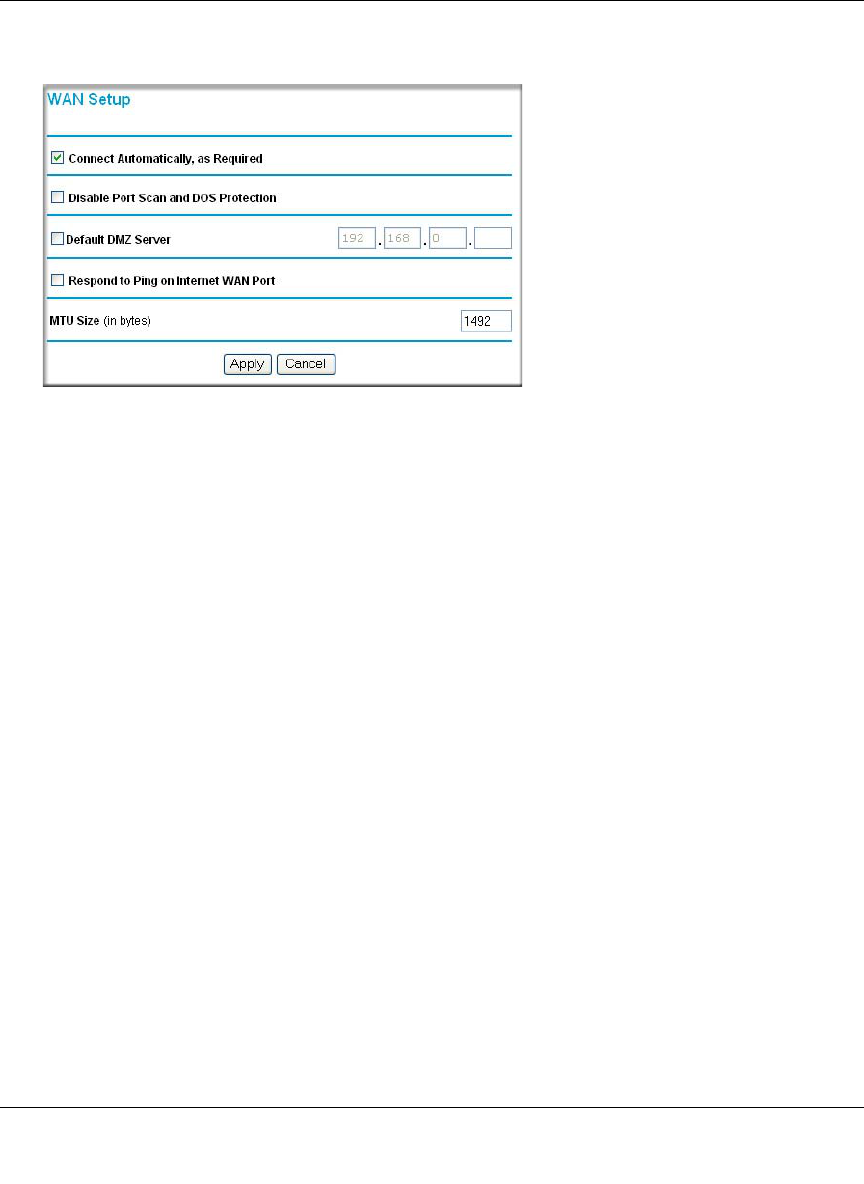
Reference Manual for the ADSL Modem Wireless Router DG834G
Advanced Configuration 6-3
v1.0, January 2006
2. From the Main Menu, under Advanced, click the WAN Setup link to view the page shown:
3. Select the Default DMZ Server check box.
4. Type the IP address for that server.
5. Click Apply to save your changes.
Connect Automatically, as Required
Normally, this option should be enabled, so that an Internet connection will be made automatically,
whenever Internet-bound traffic is detected. If this causes high connection costs, you can disable
this setting.
If disabled, you must connect manually, using the sub-screen accessed from the "Connection
Status" button on the Status screen.
If you have an "Always on" connection, this setting has no effect.
Disable Port Scan and DOS Protection
The Firewall protects your LAN against Port Scans and Denial of Service (DOS) attacks. This
should be disabled only in special circumstances.
Figure 6-1

Reference Manual for the ADSL Modem Wireless Router DG834G
6-4 Advanced Configuration
v1.0, January 2006
Respond to Ping on Internet WAN Port
If you want the modem router to respond to a 'ping' from the Internet, select the Respond to Ping
on Internet WAN Port check box. This should only be used as a diagnostic tool, since it allows
your modem router to be discovered. Do not select this box unless you have a specific reason to do
so.
MTU Size
The normal MTU (Maximum Transmit Unit) value for most Ethernet networks is 1500 Bytes, or
1492 Bytes for PPPoE connections. For some ISPs you may need to reduce the MTU. But this is
rarely required, and should not be done unless you are sure it is necessary for your ISP connection.
Configuring LAN IP Settings
The LAN IP Setup menu allows configuration of LAN IP services such as DHCP and RIP. These
features can be found under the Advanced heading in the Main Menu of the browser interface.
The modem router is shipped preconfigured to use private IP addresses on the LAN side, and to act
as a DHCP server. The modem router’s default LAN IP configuration is:
• LAN IP addresses—192.168.0.1
• Subnet mask—255.255.255.0
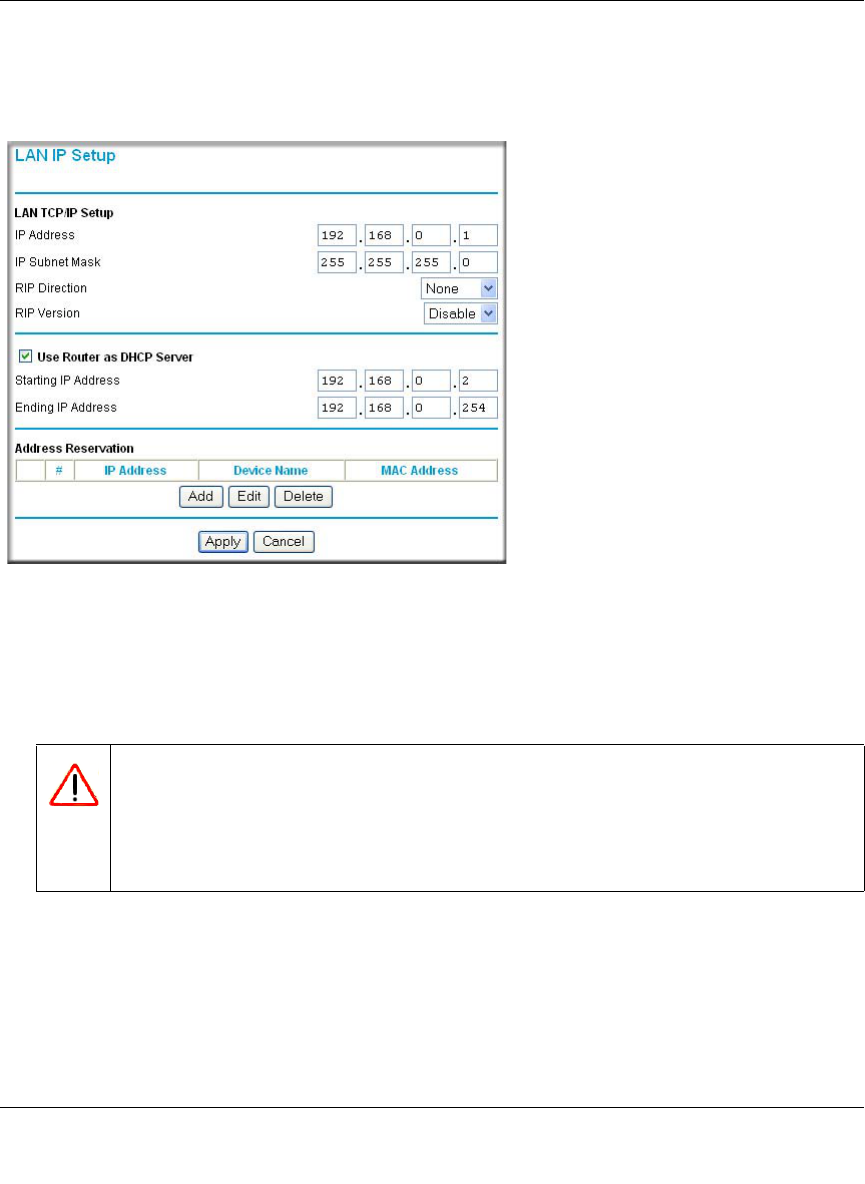
Reference Manual for the ADSL Modem Wireless Router DG834G
Advanced Configuration 6-5
v1.0, January 2006
These addresses are part of the Internet Engineering Task Force (IETF)-designated private address
range for use in private networks, and should be suitable in most applications. If your network has
a requirement to use a different IP addressing scheme, you can make those changes in this menu.
The LAN TCP/IP Setup parameters are:
• IP Address
This is the LAN IP address of the modem router.
• IP Subnet Mask
This is the LAN Subnet Mask of the modem router. Combined with the IP address, the IP
Subnet Mask allows a device to know which other addresses are local to it, and which must be
reached through a gateway or modem router.
Figure 6-2
Warning: If you change the LAN IP address of the modem router while connected
through the browser, you or anyone else using the router will be
disconnected. You must then open a new connection to the new IP
address and log in again. Others using the router will have to restart their
computer and connect to the router again.

Reference Manual for the ADSL Modem Wireless Router DG834G
6-6 Advanced Configuration
v1.0, January 2006
• RIP Direction
RIP (Router Information Protocol) allows a modem router to exchange routing information
with other routers. The RIP Direction selection controls how the Modem Router sends and
receives RIP packets. Both is the default.
— When set to Both or Out Only, the modem router will broadcast its routing table
periodically.
— When set to Both or In Only, it will incorporate the RIP information that it receives.
— When set to None, it will not send any RIP packets and will ignore any RIP packets
received.
• RIP Version
This controls the format and the broadcasting method of the RIP packets that the modem
router sends. It recognizes both formats when receiving. By default, this is set for RIP-1.
— RIP-1 is universally supported. RIP-1 is probably adequate for most networks, unless you
have an unusual network setup.
— RIP-2 carries more information. Both RIP-2B and RIP-2M send the routing data in RIP-2
format.
– RIP-2B uses subnet broadcasting.
– RIP-2M uses multicasting.
DHCP
By default, the modem router will function as a DHCP (Dynamic Host Configuration Protocol)
server, allowing it to assign IP, DNS server, and default gateway addresses to all computers
connected to the modem router's LAN. The assigned default gateway address is the LAN address
of the router. IP addresses will be assigned to the attached PCs from a pool of addresses specified
in this menu. Each pool address is tested before it is assigned to avoid duplicate addresses on the
LAN.
For most applications, the default DHCP and TCP/IP settings of the router are satisfactory. See
“Internet Networking and TCP/IP Addressing” in Appendix C for an explanation of DHCP and
information about how to assign IP addresses for your network.
Use Router as DHCP server
If another device on your network will be the DHCP server, or if you will manually configure the
network settings of all of your computers, clear the ‘Use router as DHCP server’ check box.
Otherwise, leave it selected.

Reference Manual for the ADSL Modem Wireless Router DG834G
Advanced Configuration 6-7
v1.0, January 2006
Specify the pool of IP addresses to be assigned by setting the Starting IP Address and Ending IP
Address. These addresses should be part of the same IP address subnet as the router’s LAN IP
address. Using the default addressing scheme, you should define a range between 192.168.0.2 and
192.168.0.254, although you may want to save part of the range for devices with fixed addresses.
The router will deliver the following parameters to any LAN device that requests DHCP:
• An IP Address from the range you have defined
• Subnet Mask
• Gateway IP Address is the router’s LAN IP address
• Primary DNS Server, if you entered a Primary DNS address in the Basic Settings menu;
otherwise, the router’s LAN IP address
• Secondary DNS Server, if you entered a Secondary DNS address in the Basic Settings menu
• WINS Server, short for Windows Internet Naming Service Server, determines the IP address
associated with a particular Windows computer. A WINS server records and reports a list of
names and IP address of Windows PCs on its local network. If you connect to a remote
network that contains a WINS server, enter the server’s IP address here. This allows your PCs
to browse the network using the Network Neighborhood feature of Windows.
Reserved IP addresses
When you specify a reserved IP address for a computer on the LAN, that computer will always
receive the same IP address each time it access the router’s DHCP server. Reserved IP addresses
should be assigned to servers that require permanent IP settings.
To reserve an IP address:
1. Click the Add button.
2. In the IP Address box, type the IP address to assign to the computer or server.
Choose an IP address from the router’s LAN subnet, such as 192.168.0.x.
3. Type the MAC Address of the computer or server.
Tip: If the computer is already present on your network, you can copy its MAC
address from the Attached Devices menu and paste it here.
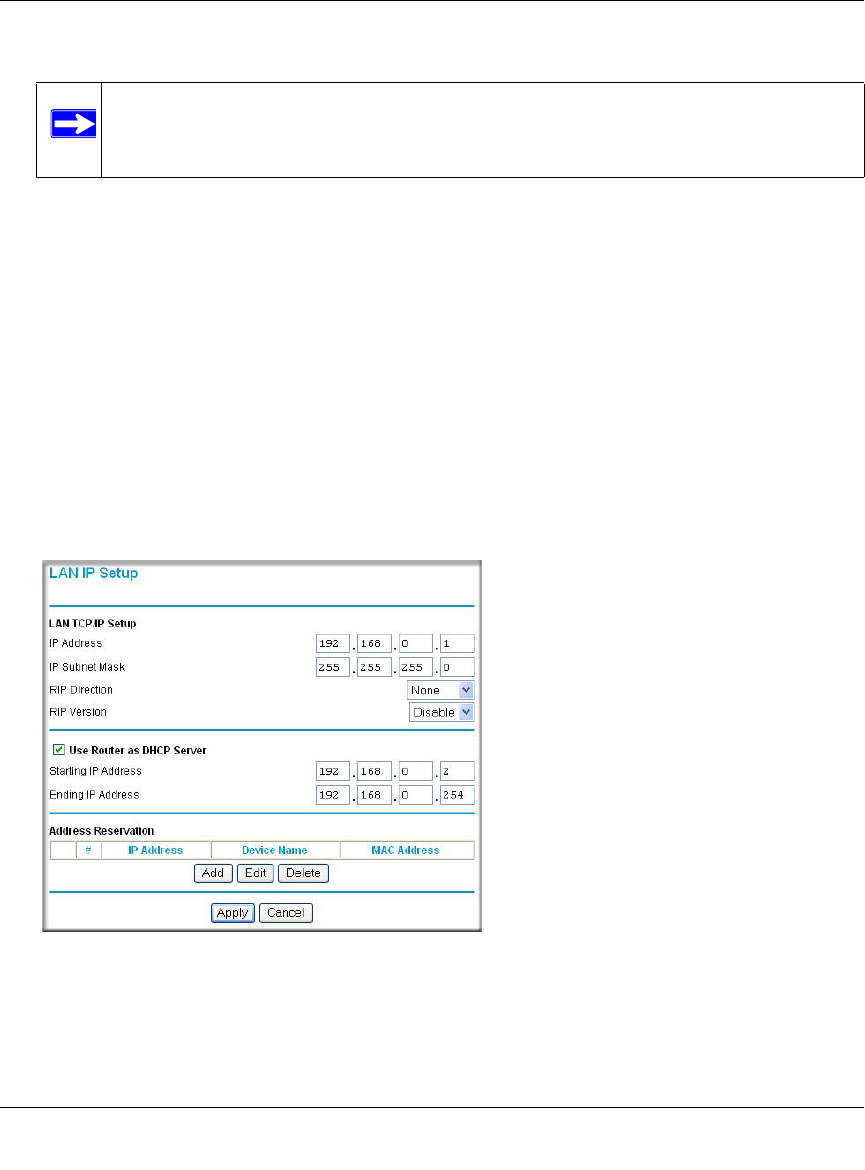
Reference Manual for the ADSL Modem Wireless Router DG834G
6-8 Advanced Configuration
v1.0, January 2006
4. Click Apply to enter the reserved address into the table.
To edit or delete a reserved address entry:
1. Click the button next to the reserved address you want to edit or delete.
2. Click Edit or Delete.
How to Configure LAN TCP/IP Settings
1. Log in to the router at its default LAN address of http://192.168.0.1 with its default User Name
of admin, default password of password, or using whatever User Name, Password and LAN
address you have chosen for the router.
2. From the Main Menu, under Advanced, click the LAN IP Setup link to view the menu,
shown:
3. Enter the TCP/IP, DHCP, or Reserved IP parameters.
4. Click Apply to save your changes.
Note: The reserved address will not be assigned until the next time the computer
contacts the router's DHCP server. Reboot the computer or access its IP
configuration and force a DHCP release and renew.
Figure 6-3
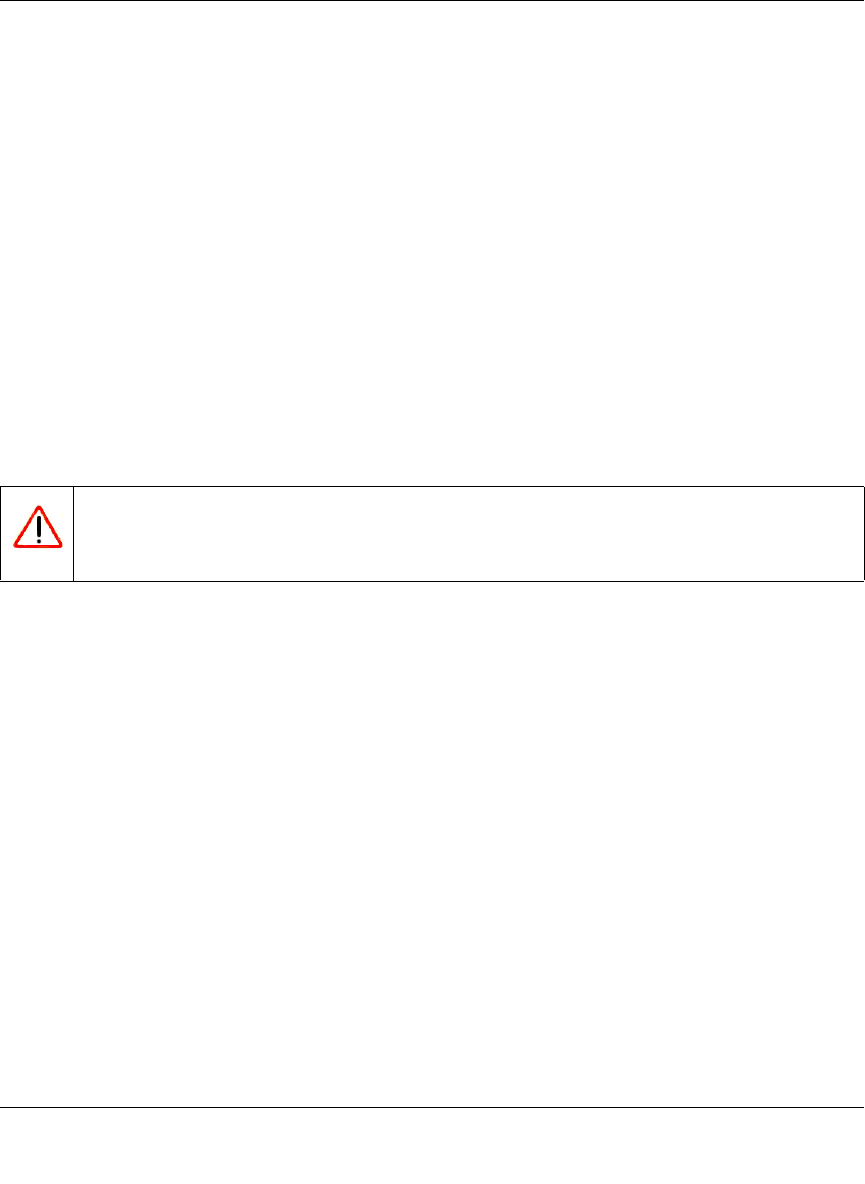
Reference Manual for the ADSL Modem Wireless Router DG834G
Advanced Configuration 6-9
v1.0, January 2006
Configuring Dynamic DNS
If your network has a permanently assigned IP address, you can register a domain name and have
that name linked with your IP address by public Domain Name Servers (DNS). However, if your
Internet account uses a dynamically assigned IP address, you will not know in advance what your
IP address will be, and the address can change frequently. In this case, you can use a commercial
dynamic DNS service that will allow you to register your domain to their IP address, and will
forward traffic directed at your domain to your frequently-changing IP address.
The router contains a client that can connect to a dynamic DNS service provider. To use this
feature, you must select a service provider and obtain an account with them. After you have
configured your account information in the router, whenever your ISP-assigned IP address
changes, your router will automatically contact your dynamic DNS service provider, log in to your
account, and register your new IP address.
How to Configure Dynamic DNS
1. Log in to the router at its default LAN address of http://192.168.0.1 with its default User Name
of admin, default password of password, or using whatever User Name, Password and LAN
address you have chosen for the router.
Warning: If your ISP assigns a private WAN IP address such as 192.168.x.x or 10.x.x.x,
the dynamic DNS service will not work because private addresses will not be
routed on the Internet.
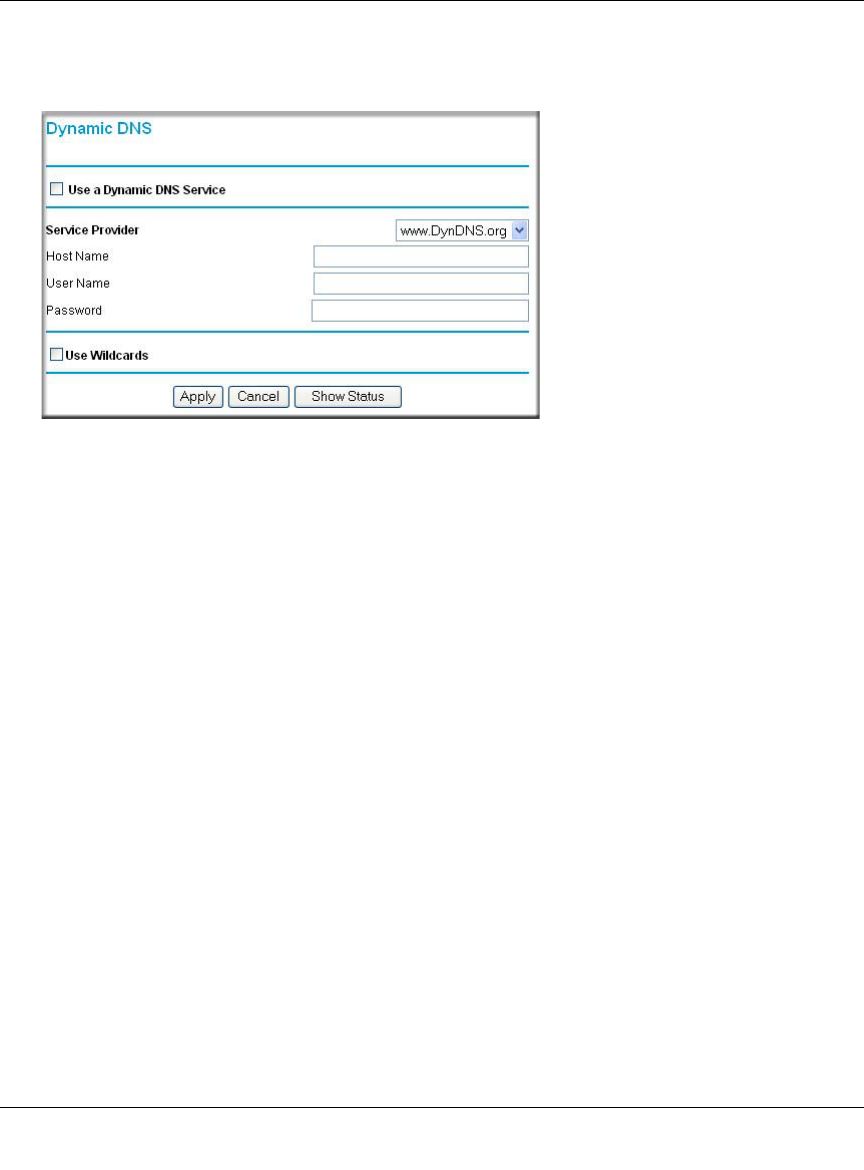
Reference Manual for the ADSL Modem Wireless Router DG834G
6-10 Advanced Configuration
v1.0, January 2006
2. From the Main Menu of the browser interface, under Advanced, select Dynamic DNS to
display the page below.
3. Access the Web site of one of the dynamic DNS service providers whose names appear in the
‘Service Provider’ box, and register for an account.
For example, for dyndns.org, go to www.dyndns.org.
4. Select the Use a dynamic DNS service check box.
5. Select the name of your dynamic DNS Service Provider.
6. Type the Host Name that your dynamic DNS service provider gave you.
The dynamic DNS service provider may call this the domain name. If your URL is
myName.dyndns.org, then your Host Name is “myName.”
7. Type the User Name for your dynamic DNS account.
8. Type the Password (or key) for your dynamic DNS account.
9. If your dynamic DNS provider allows the use of wildcards in resolving your URL, you can
select the Use wildcards check box to activate this feature.
For example, the wildcard feature will cause *.yourhost.dyndns.org to be aliased to the same
IP address as yourhost.dyndns.org
10. Click Apply to save your configuration.
Figure 6-4

Reference Manual for the ADSL Modem Wireless Router DG834G
Advanced Configuration 6-11
v1.0, January 2006
Using Static Routes
Static Routes provide additional routing information to your router. Under normal circumstances,
the router has adequate routing information after it has been configured for Internet access, and
you do not need to configure additional static routes. You must configure static routes only for
unusual cases such as multiple routers or multiple IP subnets located on your network.
Static Route Example
As an example of when a static route is needed, consider the following case:
• Your primary Internet access is through a cable modem to an ISP.
• You have an ISDN router on your home network for connecting to the company where you are
employed. This router’s address on your LAN is 192.168.0.100.
• Your company’s network is 134.177.0.0.
When you first configured your router, two implicit static routes were created. A default route was
created with your ISP as the modem router, and a second static route was created to your local
network for all 192.168.0.x addresses. With this configuration, if you attempt to access a device on
the 134.177.0.0 network, your router will forward your request to the ISP. The ISP forwards your
request to the company where you are employed, and the request will likely be denied by the
company’s firewall.
In this case you must define a static route, telling your router that 134.177.0.0 should be accessed
through the ISDN router at 192.168.0.100. The static route would look like Figure 6-6.
In this example:
• The Destination IP Address and IP Subnet Mask fields specify that this static route applies to
all 134.177.x.x addresses.
• The Modem Router IP Address fields specifies that all traffic for these addresses should be
forwarded to the ISDN router at 192.168.0.100.
• A Metric value of 1 will work since the ISDN router is on the LAN.
This represents the number of routers between your network and the destination. This is a
direct connection so it is set to 1.
• Private is selected only as a precautionary security measure in case RIP is activated.
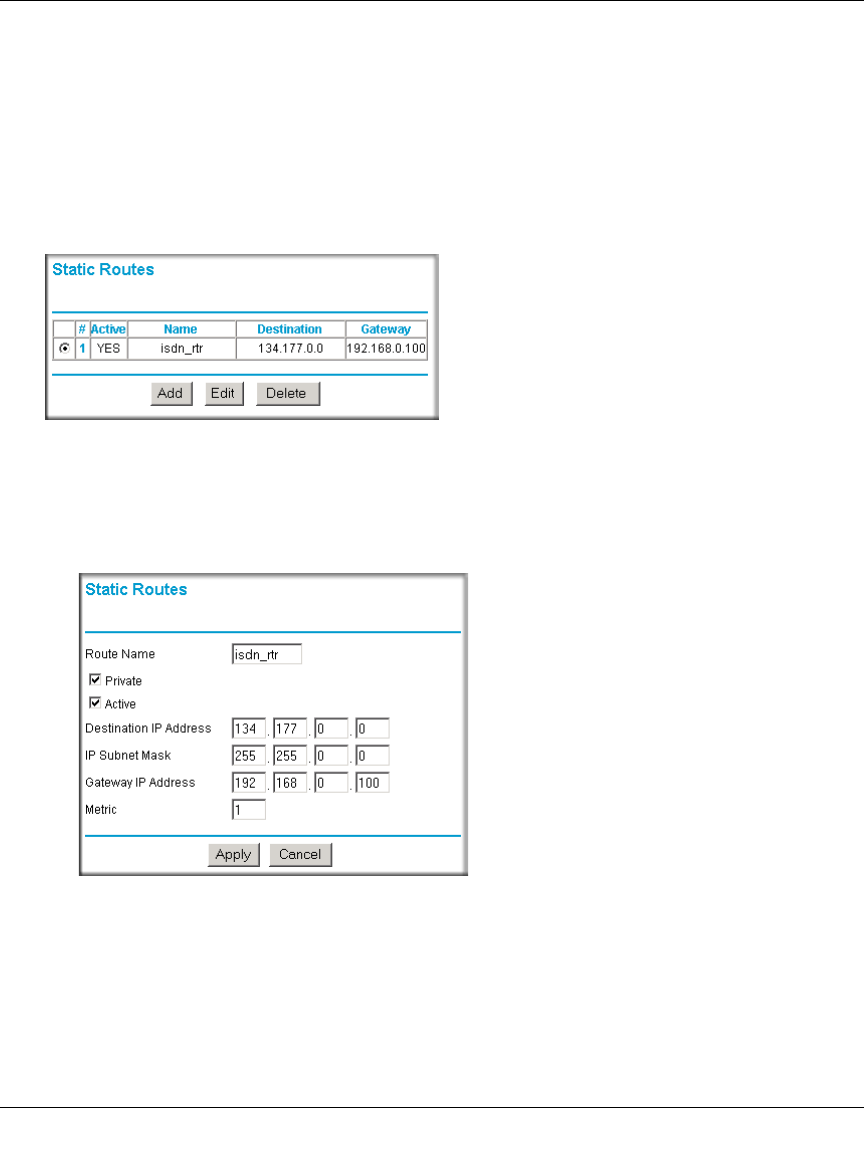
Reference Manual for the ADSL Modem Wireless Router DG834G
6-12 Advanced Configuration
v1.0, January 2006
How to Configure Static Routes
1. Log in to the router at its default LAN address of http://192.168.0.1 with its default User Name
of admin, default password of password, or using whatever User Name, Password and LAN
address you have chosen for the router.
2. From the Main Menu of the browser interface, under Advanced, click Static Routes to view
the Static Routes menu, shown in Figure 6-5.
3. To add or edit a Static Route:
a. Click the Edit button to open the Edit Menu, shown in Figure 6-6.
b. Type a route name for this static route in the Route Name box under the table.
This is for identification purpose only.
c. Select Private if you want to limit access to the LAN only.
The static route will not be reported in RIP.
Figure 6-5
Figure 6-6
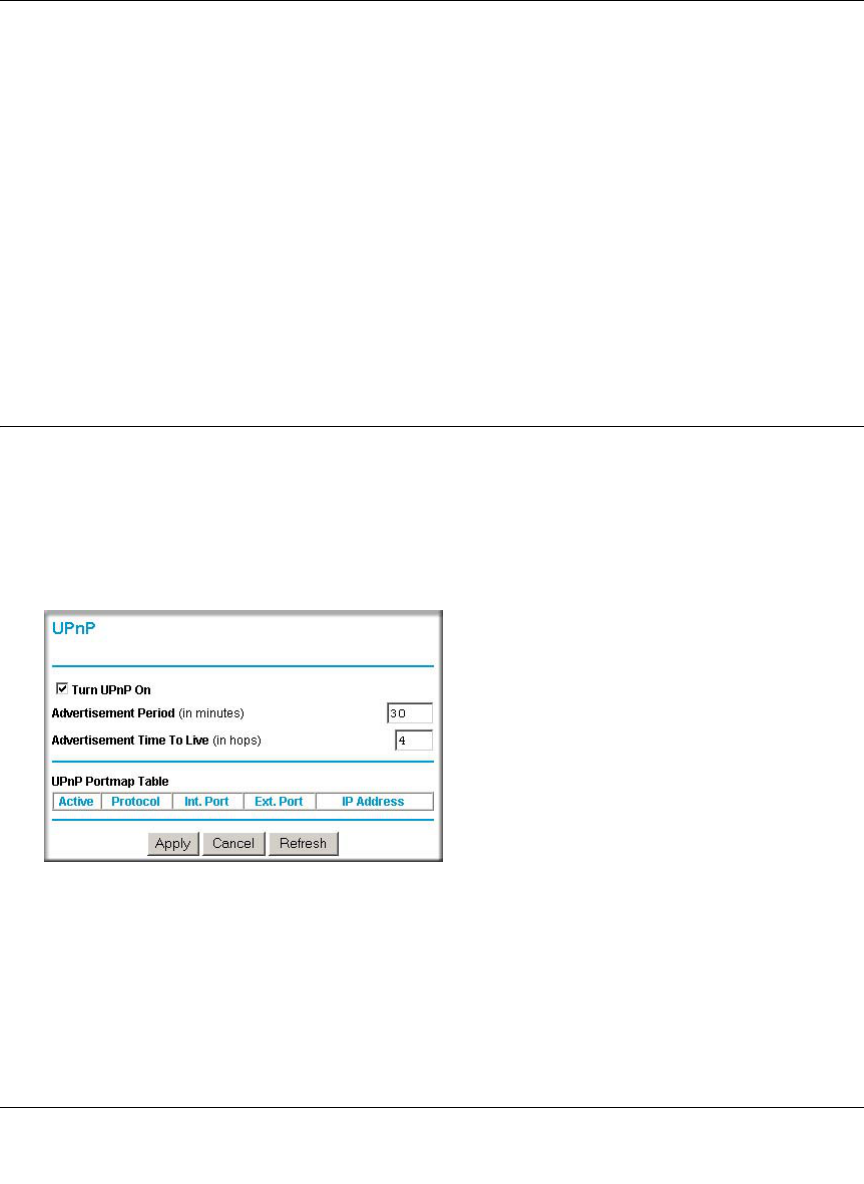
Reference Manual for the ADSL Modem Wireless Router DG834G
Advanced Configuration 6-13
v1.0, January 2006
d. Select Active to make this route effective.
e. Type the Destination IP Address of the final destination.
f. Type the IP Subnet Mask for this destination.
If the destination is a single host, type 255.255.255.255.
g. Type the Gateway IP Address, which must be a router on the same LAN segment as the
router.
h. Type a number between 1 and 15 as the Metric value.
This represents the number of routers between your network and the destination. Usually,
a setting of 2 or 3 works, but if this is a direct connection, set it to 1.
4. Click Apply to have the static route entered into the table.
Universal Plug and Play (UPnP)
Universal Plug and Play (UPnP) helps devices, such as Internet appliances and computers, access
the network and connect to other devices as needed. UPnP devices can automatically discover the
services from other registered UPnP devices on the network.
1. Click UPnP on the main menu to invoke the UPnP menu:
2. Fill out the UPnP screen:
•Turn UPnP On: UPnP can be enabled or disabled for automatic device configuration. The
default setting for UPnP is enabled. If disabled, the Router will not allow any device to
automatically control the resources, such as port forwarding (mapping), of the Router.
Figure 6-7

Reference Manual for the ADSL Modem Wireless Router DG834G
6-14 Advanced Configuration
v1.0, January 2006
•Advertisement Period: The Advertisement Period is how often the Router will advertise
(broadcast) its UPnP information. This value can range from 1 to 1440 minutes. The
default period is for 30 minutes. Shorter durations will ensure that control points have
current device status at the expense of additional network traffic. Longer durations may
compromise the freshness of the device status but can significantly reduce network traffic.
•Advertisement Time To Live: The time to live for the advertisement is measured in hops
(steps) for each UPnP packet sent. A hop is the number of steps allowed to propagate for
each UPnP advertisement before it disappears. The number of hops can range from 1 to
255. The default value for the advertisement time to live is 4 hops, which should be fine
for most home networks. If you notice that some devices are not being updated or reached
correctly, then it may be necessary to increase this value a little.
•UPnP Portmap Table: The UPnP Portmap Table displays the IP address of each UPnP
device that is currently accessing the Router and which ports (Internal and External) that
device has opened. The UPnP Portmap Table also displays what type of port is opened and
if that port is still active for each IP address.
3. To save, cancel or refresh the table:
a. Click Apply to save the new settings to the Router.
b. Click Cancel to disregard any unsaved changes.
c. Click Refresh to update the portmap table and to show the active ports that are currently
opened by UPnP devices.

Virtual Private Networking 7-1
v1.0, January 2006
Chapter 7
Virtual Private Networking
This chapter describes how to use the virtual private networking (VPN) features of the ADSL
Modem Wireless Router. VPN communications paths are called tunnels. VPN tunnels provide
secure, encrypted communications between your local network and a remote network or computer.
See “Virtual Private Networking (VPN)” in Appendix C to learn more about VPN.
This chapter is organized as follows:
•“Overview of VPN Configuration” on page 7-2 provides an overview of the two most
common VPN configurations: Client-to-Gateway and Gateway-to-Gateway.
•“Planning a VPN” on page 7-4 provides a worksheet for recording the configuration
parameters of the VPN you want to set up, along with the VPN Committee (VPNC)
recommended default parameters set by the VPN Wizard.
•“VPN Tunnel Configuration” on page 7-6 summarizes the three ways to configure a VPN
tunnel: VPN Wizard (recommended for most situations), Auto Policy, and Manual Policy.
•“How to Set Up a Client-to-Gateway VPN Configuration” on page 7-7 provides the steps
needed to configure a VPN tunnel between a remote PC and a network gateway using the VPN
Wizard and the NETGEAR ProSafe VPN Client.
•“How to Set Up a Gateway-to-Gateway VPN Configuration” on page 7-21 provides the steps
needed to configure a VPN tunnel between two network gateways using the VPN Wizard.
•“VPN Tunnel Control” on page 7-29 provides the step-by-step procedures for activating,
verifying, deactivating, and deleting a VPN tunnel once the VPN tunnel has been configured.
•“How to Set Up VPN Tunnels in Special Circumstances” on page 7-38 provides the steps
needed to configure VPN tunnels when there are special circumstances and the VPNC
recommended defaults of the VPN Wizard are inappropriate. The two alternatives for
configuring VPN tunnels are Auto Policy and Manual Policy.
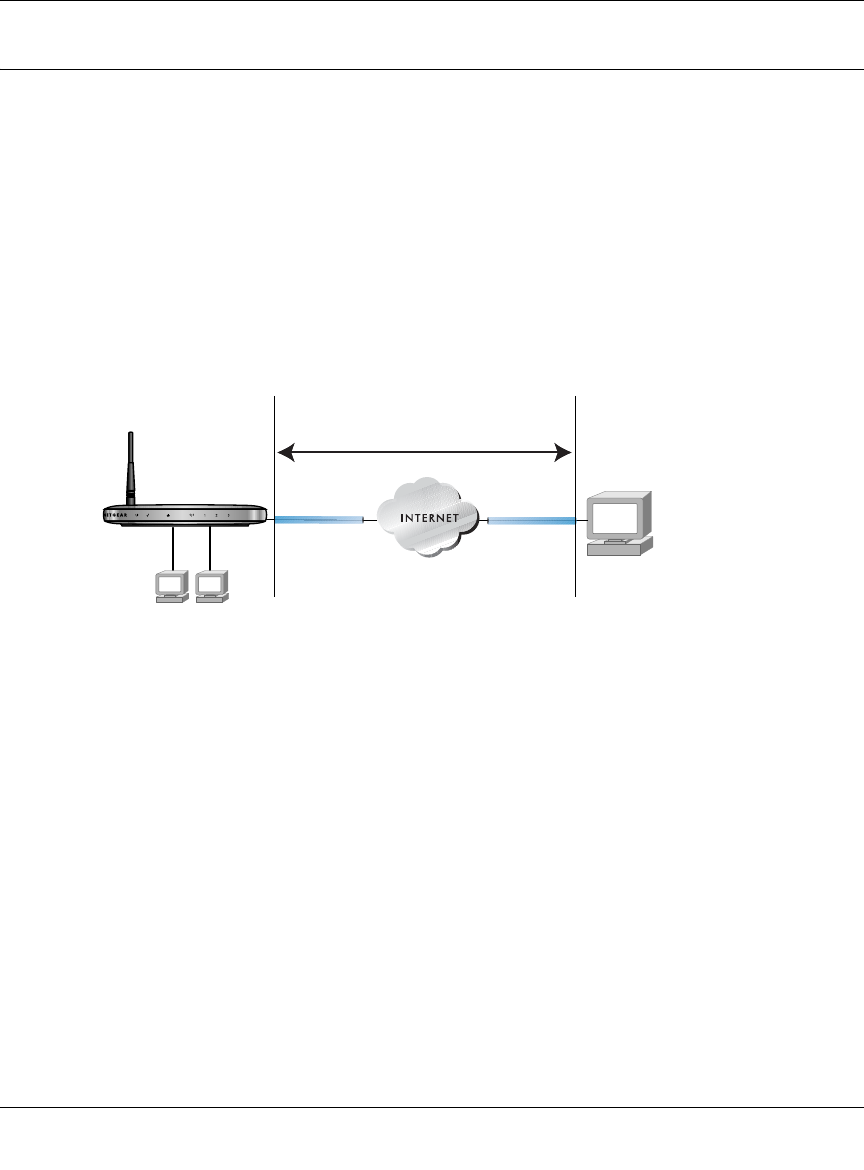
Reference Manual for the ADSL Modem Wireless Router DG834G
7-2 Virtual Private Networking
v1.0, January 2006
Overview of VPN Configuration
Two common scenarios for configuring VPN tunnels are between a remote personal computer and
a network gateway and between two or more network gateways. The DG834G v3 supports both of
these types of VPN configurations. The ADSL Modem Wireless Router supports up to five
concurrent tunnels.
Client-to-Gateway VPN Tunnels
Client-to-Gateway VPN Tunnels provide secure access from a remote PC, such as a telecommuter
connecting to an office network.
A VPN client access allows a remote PC to connect to your network from any location on the
Internet. In this case, the remote PC is one tunnel endpoint, running the VPN client software. The
ADSL Modem Wireless Router on your network is the other tunnel endpoint. See “How to Set Up
a Client-to-Gateway VPN Configuration” on page 7-7 to set up this configuration.
Figure 7-1
VPN Tunnel
DG834G
PC
(Running NETGEAR
ProSafe VPN Client)
PCs

Reference Manual for the ADSL Modem Wireless Router DG834G
Virtual Private Networking 7-3
v1.0, January 2006
Gateway-to-Gateway VPN Tunnels
• Gateway-to-Gateway VPN Tunnels provide secure access between networks, such as a branch
or home office and a main office.
A VPN between two or more NETGEAR VPN-enabled routers is a good way to connect branch or
home offices and business partners over the Internet. VPN tunnels also enable access to network
resources across the Internet. In this case, use DG834G v3s on each end of the tunnel to form the
VPN tunnel end points. See “How to Set Up a Gateway-to-Gateway VPN Configuration” on
page 7-21 to set up this configuration.
Figure 7-2
AB
VPN Tunnel
DG834G VPN Firewall DG834G VPN Firewall
PCs PCs

Reference Manual for the ADSL Modem Wireless Router DG834G
7-4 Virtual Private Networking
v1.0, January 2006
Planning a VPN
When you set up a VPN, it is helpful to plan the network configuration and record the
configuration parameters on a worksheet:
To set up a VPN connection, you must configure each endpoint with specific identification and
connection information describing the other endpoint. You must configure the outbound VPN
settings on one end to match the inbound VPN settings on other end, and vice versa.
This set of configuration information defines a security association (SA) between the two VPN
endpoints. When planning your VPN, you must make a few choices first:
• Will the local end be any device on the LAN, a portion of the local network (as defined by a
subnet or by a range of IP addresses), or a single PC?
Table 7-1. VPN Tunnel Configuration Worksheet
Connection Name:
Pre-Shared Key:
Secure Association -- Main Mode or Manual Keys:
Perfect Forward Secrecy -- Enabled or Disabled:
NETBIOS -- Enabled or Disabled:
Encryption Protocol -- DES or 3DES:
Authentication Protocol -- MD5 or SHA-1:
Diffie-Hellman (DH) Group -- Group 1 or Group 2:
Key Life in seconds:
IKE Life Time in seconds:
VPN Endpoint Local IPSec ID LAN IP Address Subnet Mask FQDN or Gateway IP
(WAN IP Address)

Reference Manual for the ADSL Modem Wireless Router DG834G
Virtual Private Networking 7-5
v1.0, January 2006
• Will the remote end be any device on the remote LAN, a portion of the remote network (as
defined by a subnet or by a range of IP addresses), or a single PC?
• Will either endpoint use Fully Qualified Domain Names (FQDNs)? FQDNs supplied by
Dynamic DNS providers (see “The Use of a Fully Qualified Domain Name (FQDN)” on
page B-8) can allow a VPN endpoint with a dynamic IP address to initiate or respond to a
tunnel request. Otherwise, the side using a dynamic IP address must always be the initiator.
• What method will you use to configure your VPN tunnels?
— The VPN Wizard using VPNC defaults (see Table 7-2)
— The typical automated Internet Key Exchange (IKE) setup (see “Using Auto Policy to
Configure VPN Tunnels” on page 7-38)
— A Manual Keying setup in which you must specify each phase of the connection (see
“Using Manual Policy to Configure VPN Tunnels” on page 7-48)?
• What level of IPSec VPN encryption will you use?
— DES - The Data Encryption Standard (DES) processes input data that is 64 bits wide,
encrypting these values using a 56 bit key. Faster but less secure than 3DES.
— 3DES - (Triple DES) achieves a higher level of security by encrypting the data three times
using DES with three different, unrelated keys.
• What level of authentication will you use?
— MDS: 128 bits, faster but less secure.
— SHA-1: 160 bits, slower but more secure.
Table 7-2. Parameters Recommended by the VPNC and Used in the VPN Wizard
Parameter Factory Default
Secure Association Main Mode
Authentication Method Pre-shared Key
Encryption Method 3DES
Authentication Protocol SHA-1
Diffie-Hellman (DH) Group Group 2 (1024 bit)
Key Life 8 hours
IKE Life Time 1 hour
NETBIOS Enabled
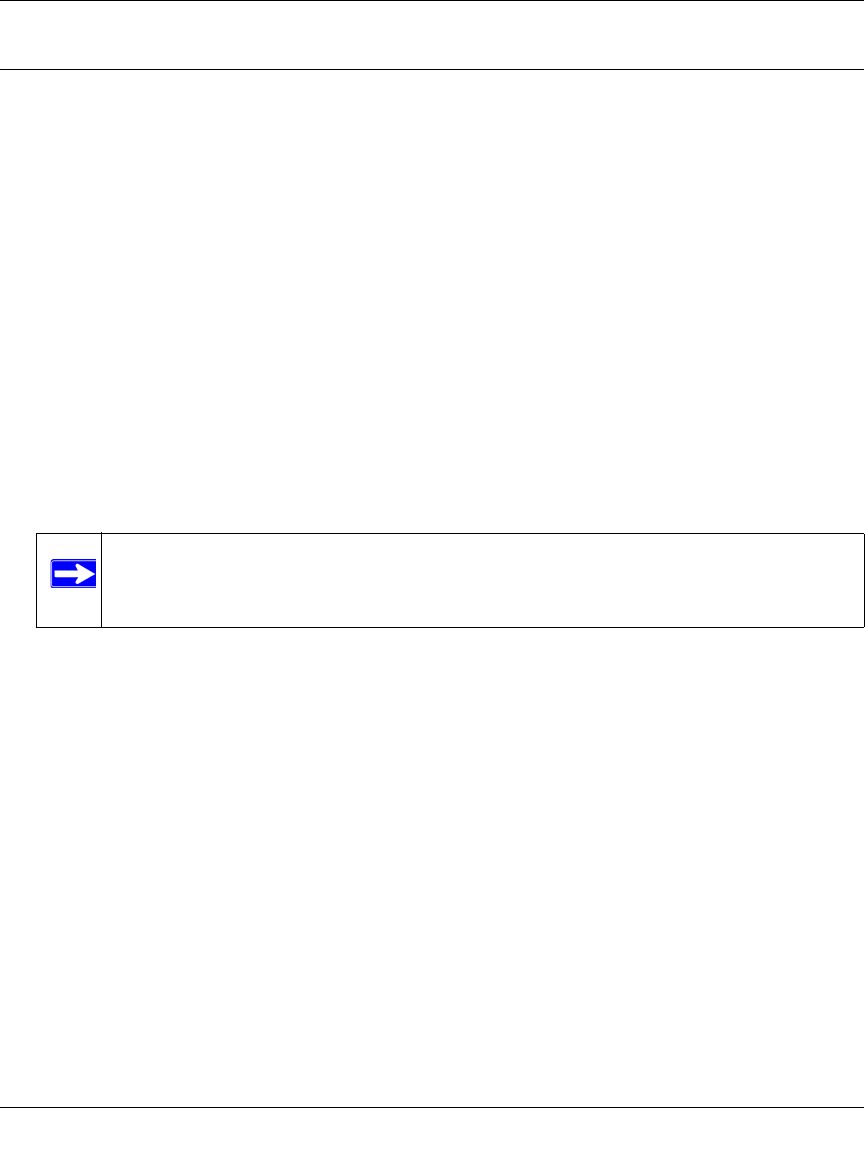
Reference Manual for the ADSL Modem Wireless Router DG834G
7-6 Virtual Private Networking
v1.0, January 2006
VPN Tunnel Configuration
There are two tunnel configurations and three ways to configure them:
• Use the VPN Wizard to configure a VPN tunnel (recommended for most situations):
— See “How to Set Up a Client-to-Gateway VPN Configuration” on page 7-7.
— See “How to Set Up a Gateway-to-Gateway VPN Configuration” on page 7-21.
• See “Using Auto Policy to Configure VPN Tunnels” on page 7-38 when the VPN Wizard and
its VPNC defaults (see Table 7-2) are not appropriate for your special circumstances, but you
want to automate the Internet Key Exchange (IKE) setup.
• See “Using Manual Policy to Configure VPN Tunnels” on page 7-48 when the VPN Wizard
and its VPNC defaults (see Table 7-2) are not appropriate for your special circumstances and
you must specify each phase of the connection. You manually enter all the authentication and
key parameters. You have more control over the process, however the process is more
complex and there are more opportunities for errors or configuration mismatches between
your DG834G v3 and the corresponding VPN endpoint gateway or client workstation.
Note: NETGEAR publishes additional interoperability scenarios with various
gateway and client software products. Look on the NETGEAR web site at
www.netgear.com for these interoperability scenarios.
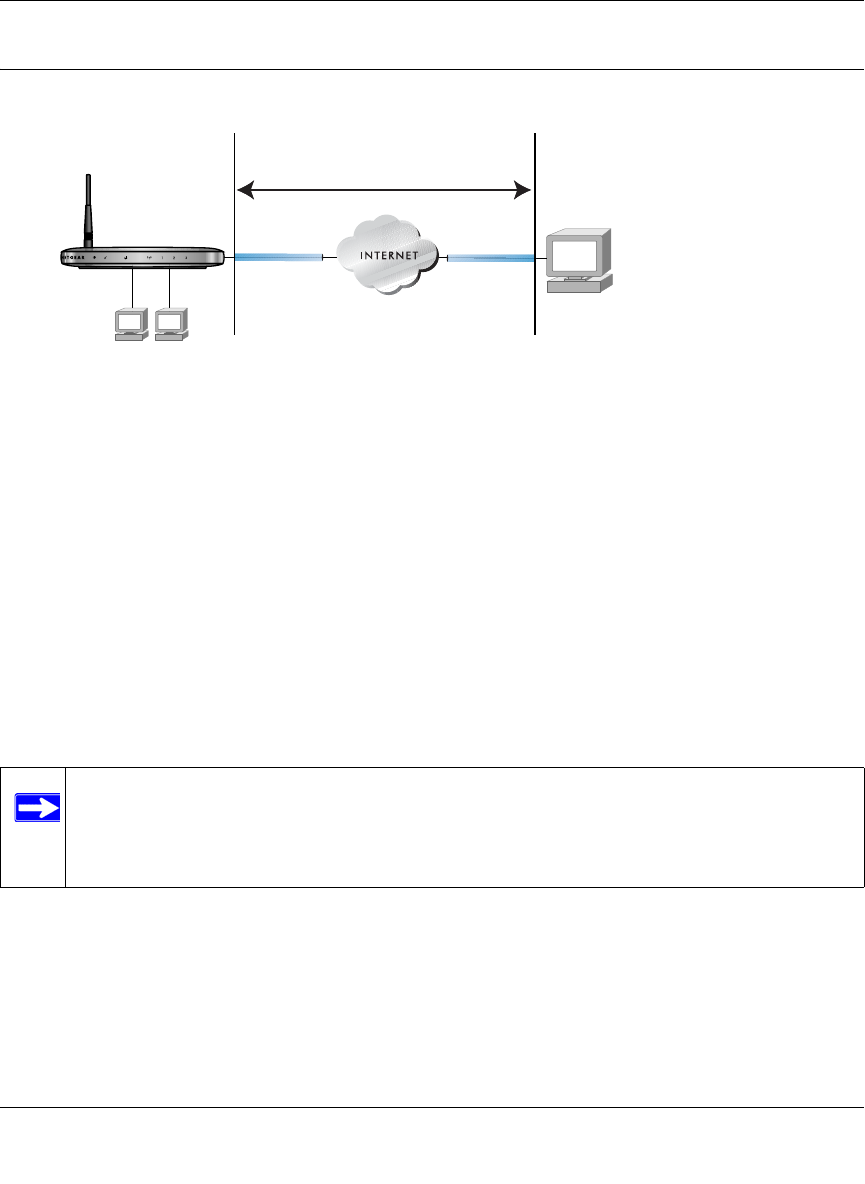
Reference Manual for the ADSL Modem Wireless Router DG834G
Virtual Private Networking 7-7
v1.0, January 2006
How to Set Up a Client-to-Gateway VPN Configuration
Setting up a VPN between a remote PC running the NETGEAR ProSafe VPN Client and a
network gateway involves the following two steps:
•“Step 1: Configuring the Client-to-Gateway VPN Tunnel on the DG834G v3” on page 7-7
uses the VPN Wizard to configure the VPN tunnel between the remote PC and network
gateway.
•“Step 2: Configuring the NETGEAR ProSafe VPN Client on the Remote PC” on page 7-12
configures the NETGEAR ProSafe VPN Client endpoint.
Step 1: Configuring the Client-to-Gateway VPN Tunnel on the
DG834G v3
The worksheet below identifies the parameters used in the following procedure. A blank
worksheet is at “Planning a VPN” on page 7-4.
Figure 7-3
Note: This section uses the VPN Wizard to set up the VPN tunnel using the VPNC
default parameters listed in Table 7-2 on page 7-5. If you have special requirements
not covered by these VPNC-recommended parameters, refer to “How to Set Up
VPN Tunnels in Special Circumstances” on page 7-38 to set up the VPN tunnel.
192.168.3.1
VPN Tunnel
DG834G
22.23.24.25
PC
(Running NETGEAR
ProSafe VPN Client)
PCs
0.0.0.0

Reference Manual for the ADSL Modem Wireless Router DG834G
7-8 Virtual Private Networking
v1.0, January 2006
Follow this procedure to configure a client-to-gateway VPN tunnel using the VPN Wizard.
Table 7-3. VPN Tunnel Configuration Worksheet
Connection Name: RoadWarrior
Pre-Shared Key: 12345678
Secure Association -- Main Mode or Manual Keys: Main
Perfect Forward Secrecy -- Enabled or Disabled: Disabled
NETBIOS -- Enabled or Disabled: Enabled
Encryption Protocol -- DES or 3DES: 3DES
Authentication Protocol -- MD5 or SHA-1: SHA-1
Diffie-Hellman (DH) Group -- Group 1 or Group 2: Group 2
Key Life in seconds: 28800 (8 hours)
IKE Life Time in seconds: 3600 (1 hour)
VPN Endpoint Local IPSec ID LAN IP Address Subnet Mask FQDN or Gateway IP
(WAN IP Address)
Client toDG834 — — Dynamic
DG834G v3 toClient 192.168.3.1 255.255.255.0 22.23.24.25
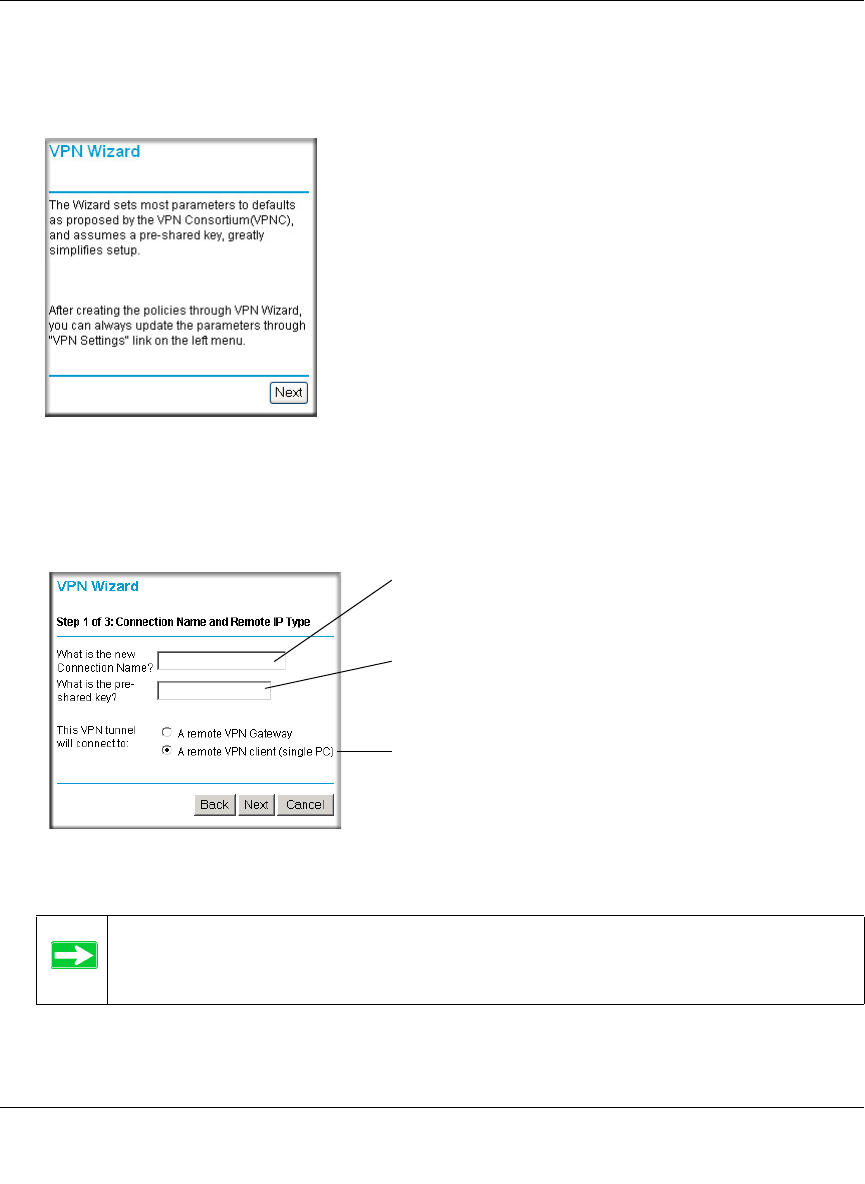
Reference Manual for the ADSL Modem Wireless Router DG834G
Virtual Private Networking 7-9
v1.0, January 2006
1. Log in to the DG834G v3 at its LAN address of http://192.168.0.1 with its default user name
of admin and password of password. Click the VPN Wizard link in the main menu to
display this screen. Click Next to proceed.
2. Fill in the Connection Name and the pre-shared key, select the type of target end point, and
click Next to proceed.
Figure 7-4
Figure 7-5
Tip: The Connection Name is arbitrary and not relevant to how the configuration
functions.
Enter the new Connection Name:
(e.g., RoadWarrior)
Enter the pre-shared key:
(e.g., 12345678)
Select the radio button:
A remote VPN client (single PC)
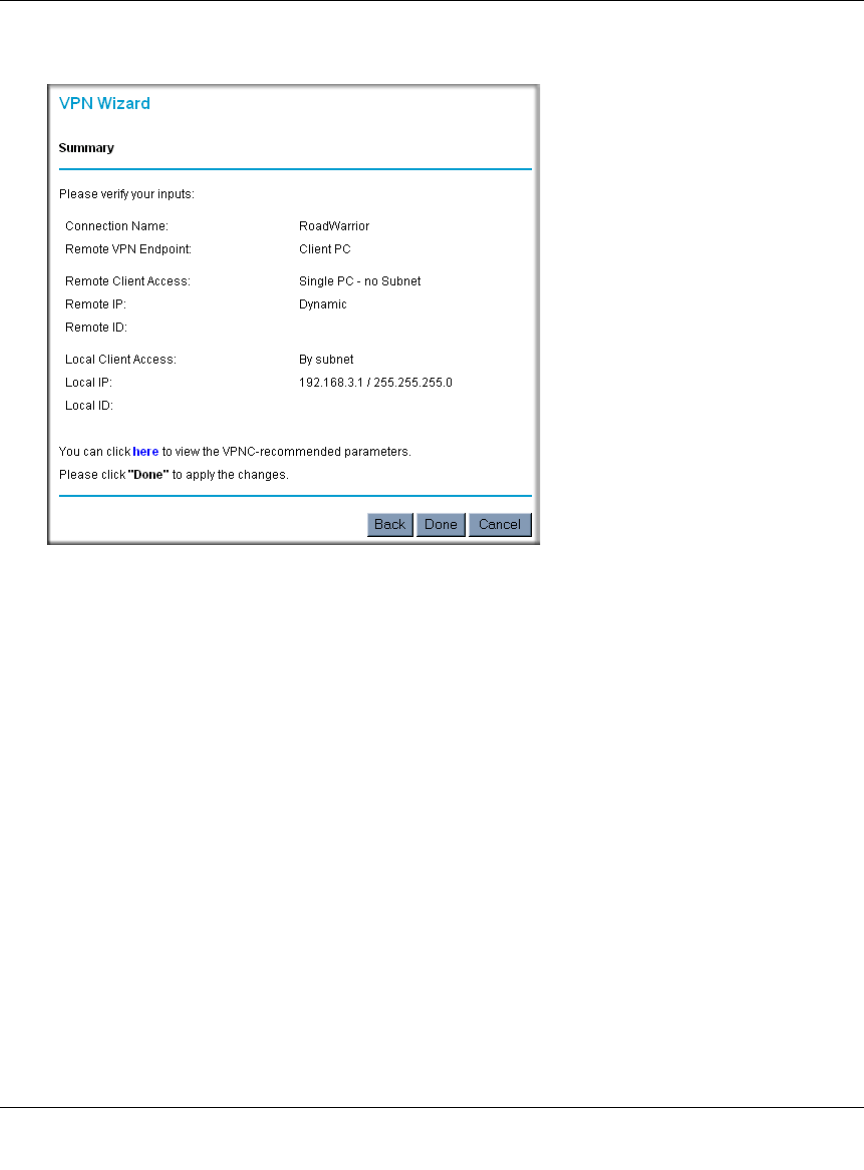
Reference Manual for the ADSL Modem Wireless Router DG834G
7-10 Virtual Private Networking
v1.0, January 2006
The Summary screen below displays.
Figure 7-6
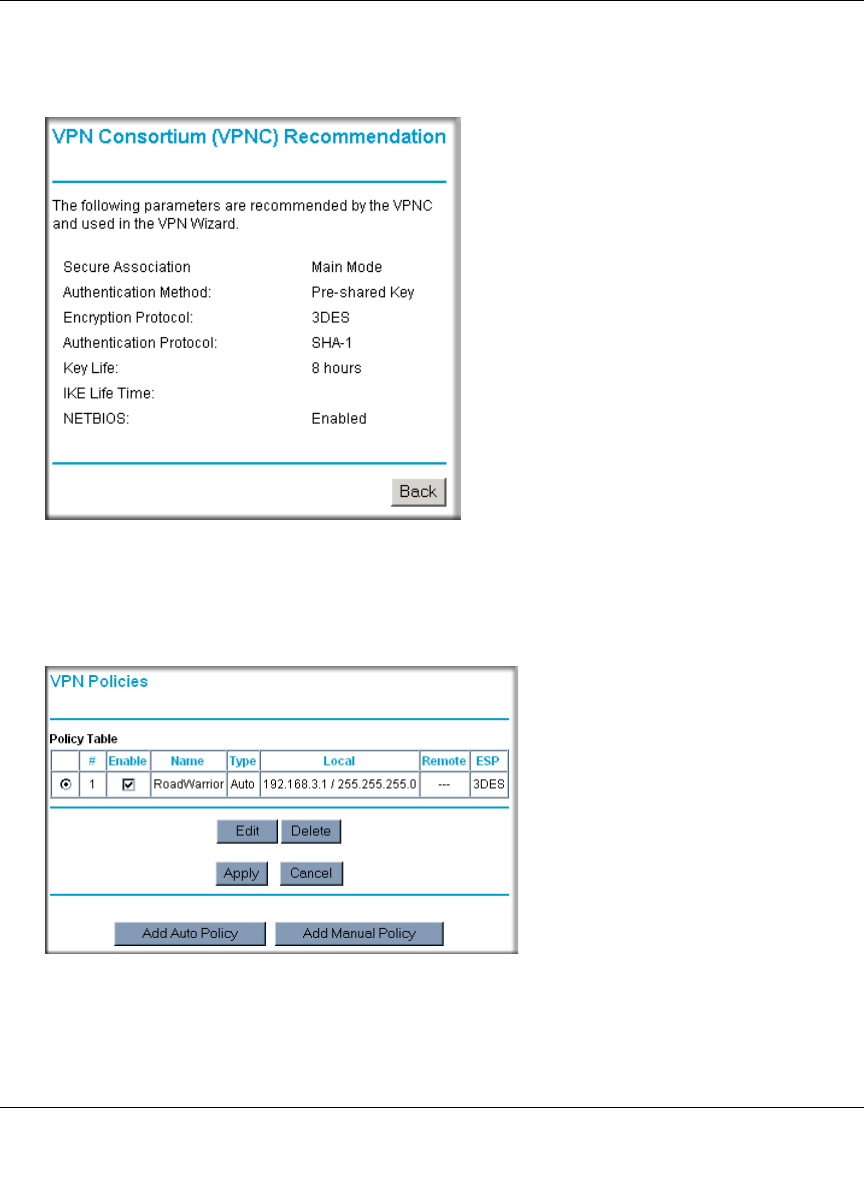
Reference Manual for the ADSL Modem Wireless Router DG834G
Virtual Private Networking 7-11
v1.0, January 2006
To view the VPNC recommended authentication and encryption settings used by the VPN
Wizard, click the “here” link. Click Back to return to the Summary screen.
3. Click Done on the Summary screen to complete the configuration procedure. The VPN
Policies menu below displays showing that the new tunnel is enabled.
Figure 7-7
Figure 7-8
1 hour
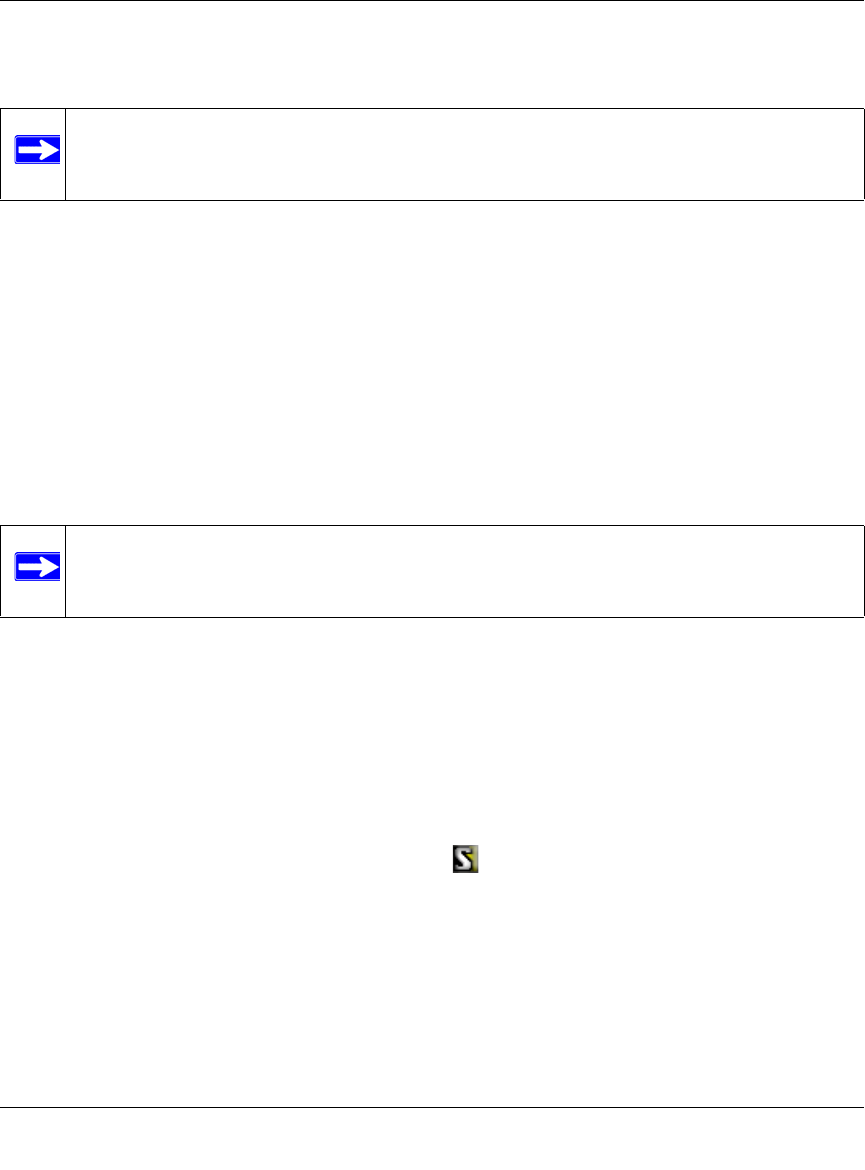
Reference Manual for the ADSL Modem Wireless Router DG834G
7-12 Virtual Private Networking
v1.0, January 2006
To view or modify the tunnel settings, select the radio button next to the tunnel entry and click
Edit.
Step 2: Configuring the NETGEAR ProSafe VPN Client on the
Remote PC
This procedure describes how to configure the NETGEAR ProSafe VPN Client. We will assume
the PC running the client has a dynamically assigned IP address.
The PC must have the NETGEAR ProSafe VPN Client program installed that supports IPSec. Go
to the NETGEAR website (http://www.netgear.com) and select VPN01L_VPN05L in the Product
Quick Find drop-down menu for information on how to purchase the NETGEAR ProSafe VPN
Client.
1. Install the NETGEAR ProSafe VPN Client on the remote PC and reboot.
• You may need to insert your Windows CD to complete the installation.
• If you do not have a modem or dial-up adapter installed in your PC, you may see the
warning message stating “The NETGEAR ProSafe VPN Component requires at least one
dial-up adapter be installed.” You can disregard this message.
• Install the IPSec Component. You may have the option to install either the VPN Adapter
or the IPSec Component or both. The VPN Adapter is not necessary.
• The system should show the ProSafe icon ( ) in the system tray after rebooting.
• Double-click the system tray icon to open the Security Policy Editor.
2. Add a new connection.
a. Run the NETGEAR ProSafe Security Policy Editor program and, using the “VPN Tunnel
Configuration Worksheet” on page 7-8, create a VPN Connection.
Note: Refer to “Using Auto Policy to Configure VPN Tunnels” on page 7-38 to enable
the IKE keepalive capability on an existing VPN tunnel.
Note: Before installing the NETGEAR ProSafe VPN Client software, be sure to turn off
any virus protection or firewall software you may be running on your PC.
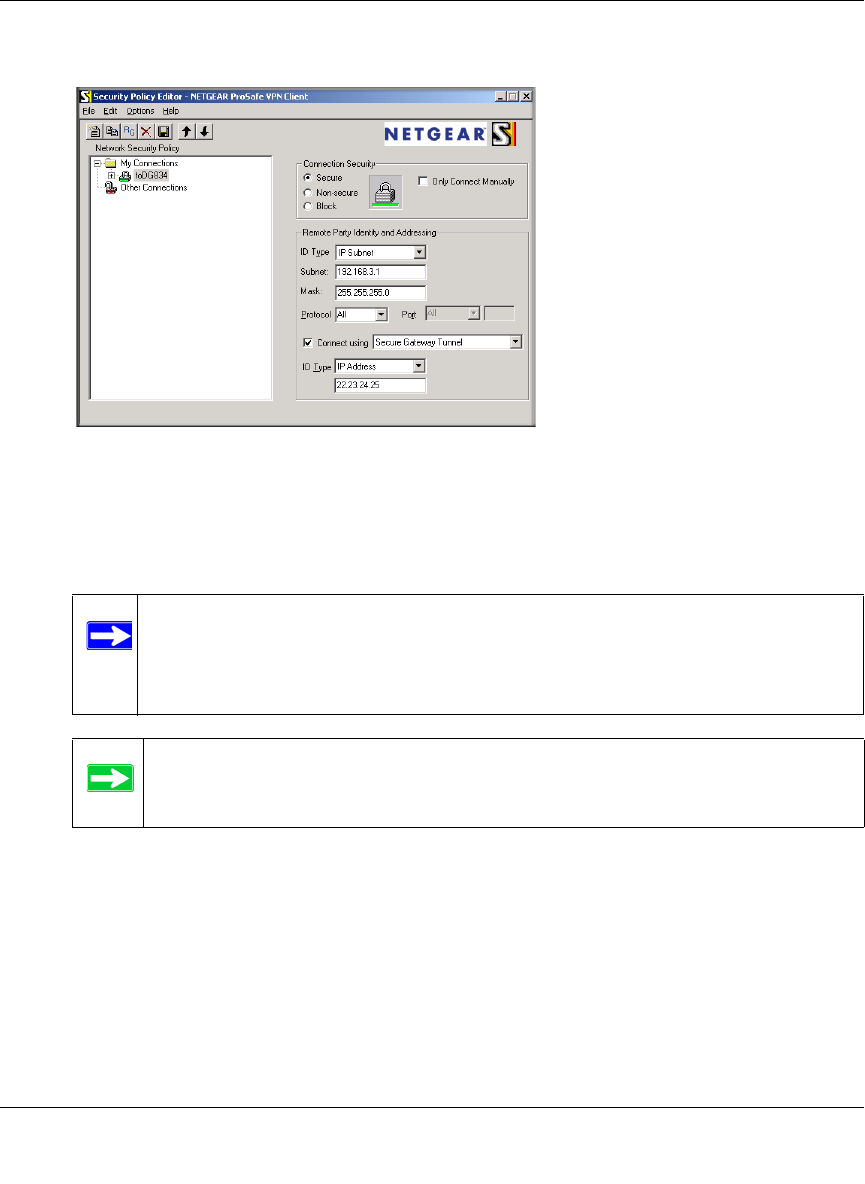
Reference Manual for the ADSL Modem Wireless Router DG834G
Virtual Private Networking 7-13
v1.0, January 2006
b. From the Edit menu of the Security Policy Editor, click Add, then Connection.
A “New Connection” listing appears in the list of policies. Rename the “New Connection”
so that it matches the Connection Name you entered in the VPN Settings of the DG834G
v3 on LAN A.
c. Select Secure in the Connection Security check-box group.
d. Select IP Subnet in the ID Type menu.
e. In this example, type 192.168.3.1 in the Subnet field as the network address of the
DG834G v3.
f. Enter 255.255.255.0 in the Mask field as the LAN Subnet Mask of the DG834G v3.
g. Select All in the Protocol menu to allow all traffic through the VPN tunnel.
Figure 7-9
Note: In this example, the Connection Name used on the client side of the VPN
tunnel is toDG834 and it does not have to match the RoadWarrior
Connection Name used on the gateway side of the VPN tunnel because
Connection Names are arbitrary to how the VPN tunnel functions.
Tip: Choose Connection Names that make sense to the people using and
administering the VPN.
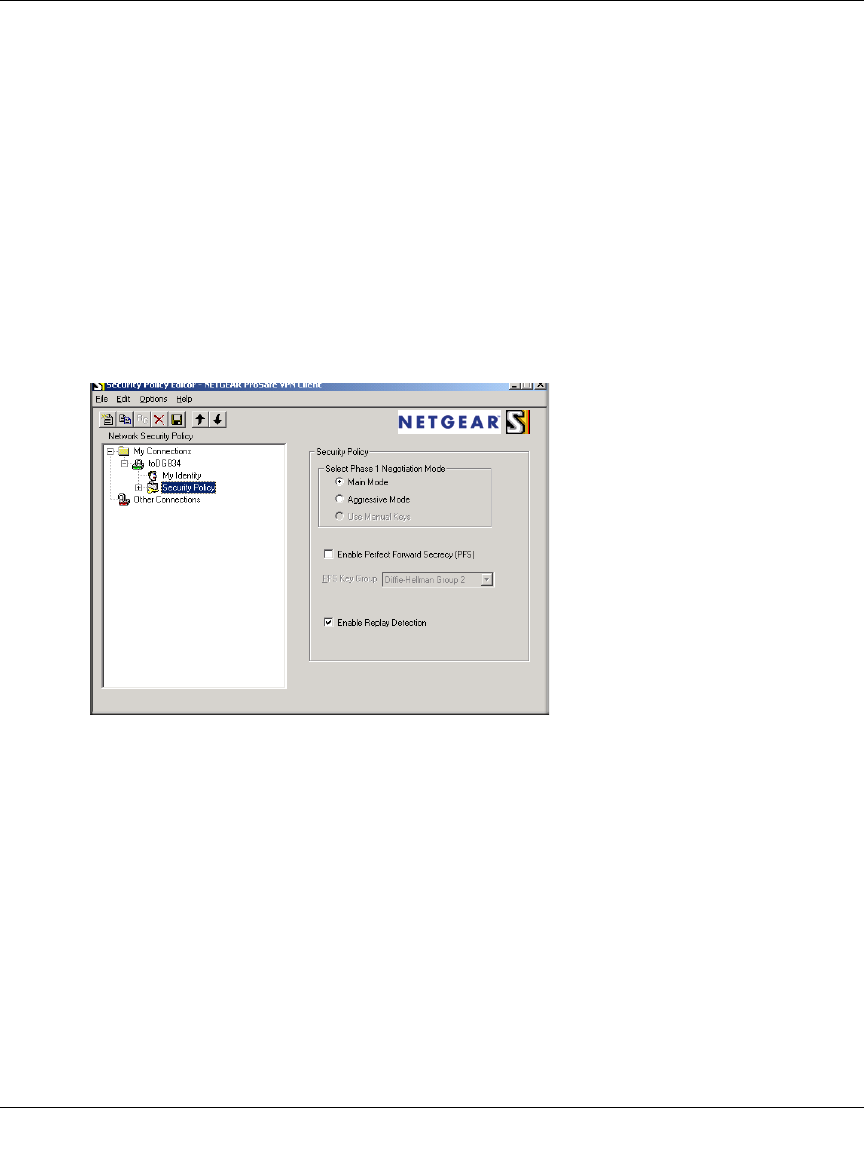
Reference Manual for the ADSL Modem Wireless Router DG834G
7-14 Virtual Private Networking
v1.0, January 2006
h. Select the Connect using Secure Gateway Tunnel check box.
i. Select IP Address in the ID Type menu below the check box.
j. Enter the public WAN IP Address of the DG834G v3 in the field directly below the ID
Type menu. In this example, 22.23.24.25 would be used.
k. The resulting Connection Settings are shown in Figure 7-10.
3. Configure the Security Policy in the NETGEAR ProSafe VPN Client software:
a. In the Network Security Policy list, expand the new connection by double clicking its
name or clicking on the “+” symbol. My Identity and Security Policy subheadings appear
below the connection name.
b. Click on the Security Policy subheading to show the Security Policy menu.
c. Select the Main Mode in the Select Phase 1 Negotiation Mode check-box group.
4. Configure the VPN Client Identity.
In this step, you will provide information about the remote VPN client PC. You will need to
provide the Pre-Shared Key that you configured in the DG834G v3 and either a fixed IP
address or a “fixed virtual” IP address of the VPN client PC.
Figure 7-10
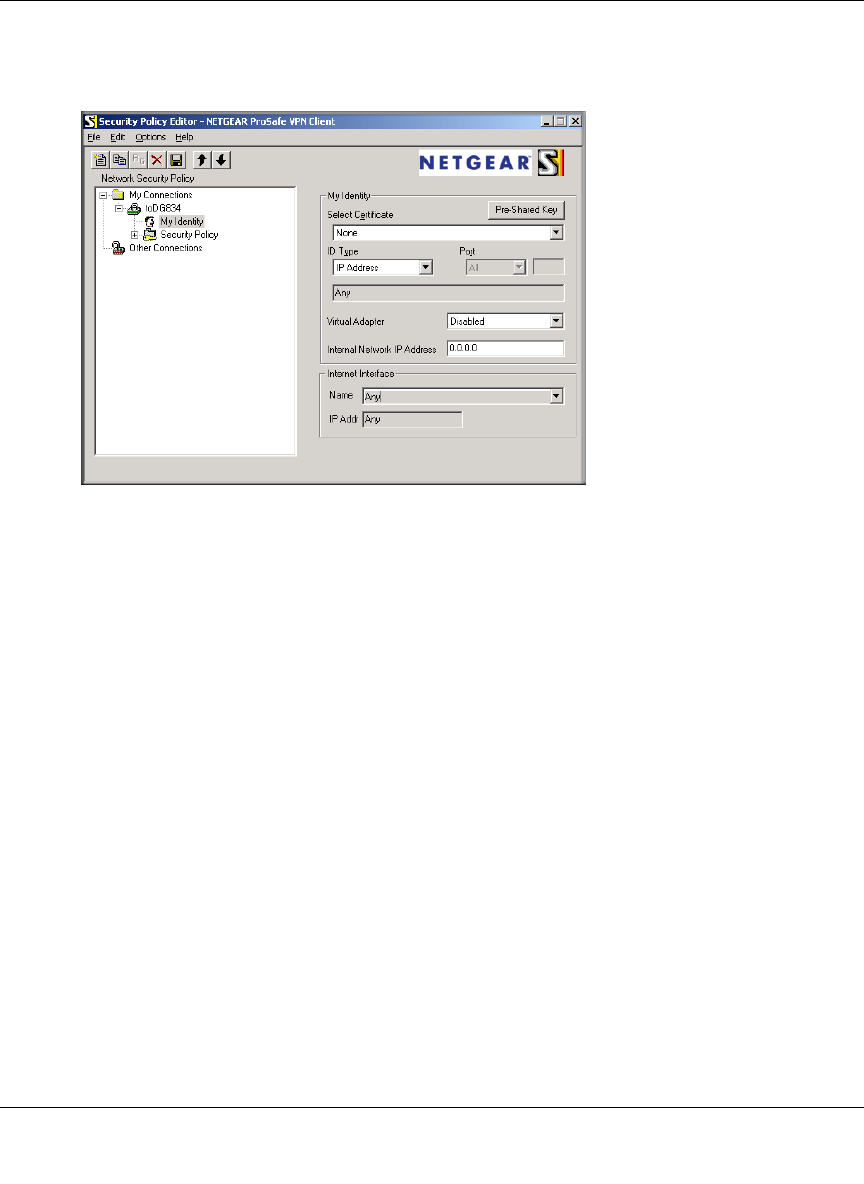
Reference Manual for the ADSL Modem Wireless Router DG834G
Virtual Private Networking 7-15
v1.0, January 2006
a. In the Network Security Policy list on the left side of the Security Policy Editor window,
click on My Identity.
b. Choose None in the Select Certificate menu.
c. Select IP Address in the ID Type menu. If you are using a virtual fixed IP address, enter
this address in the Internal Network IP Address box. Otherwise, leave this box empty.
d. In the Internet Interface box, select the adapter you use to access the Internet. Select PPP
Adapter in the Name menu if you have a dial-up Internet account. Select your Ethernet
adapter if you have a dedicated Cable or DSL line. You may also choose Any if you will
be switching between adapters or if you have only one adapter.
Figure 7-11
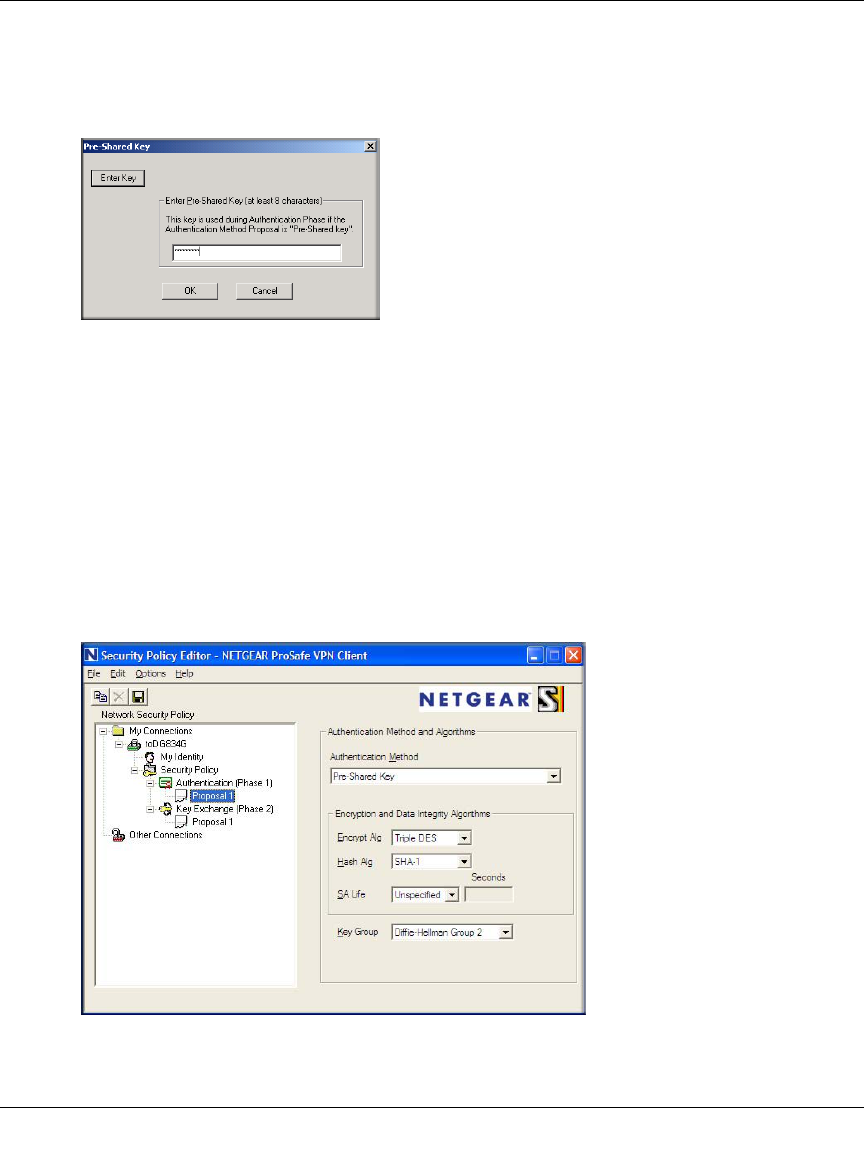
Reference Manual for the ADSL Modem Wireless Router DG834G
7-16 Virtual Private Networking
v1.0, January 2006
e. Click the Pre-Shared Key button. In the Pre-Shared Key dialog box, click the Enter Key
button. Enter the DG834G v3's Pre-Shared Key and click OK. In this example, 12345678
is entered. This field is case sensitive.
5. Configure the VPN Client Authentication Proposal.
In this step, you will provide the type of encryption (DES or 3DES) to be used for this
connection. This selection must match your selection in the DG834G v3 configuration.
a. In the Network Security Policy list on the left side of the Security Policy Editor window,
expand the Security Policy heading by double clicking its name or clicking on the “+”
symbol.
b. Expand the Authentication subheading by double clicking its name or clicking on the “+”
symbol. Then select Proposal 1 below Authentication.
Figure 7-12
Figure 7-13
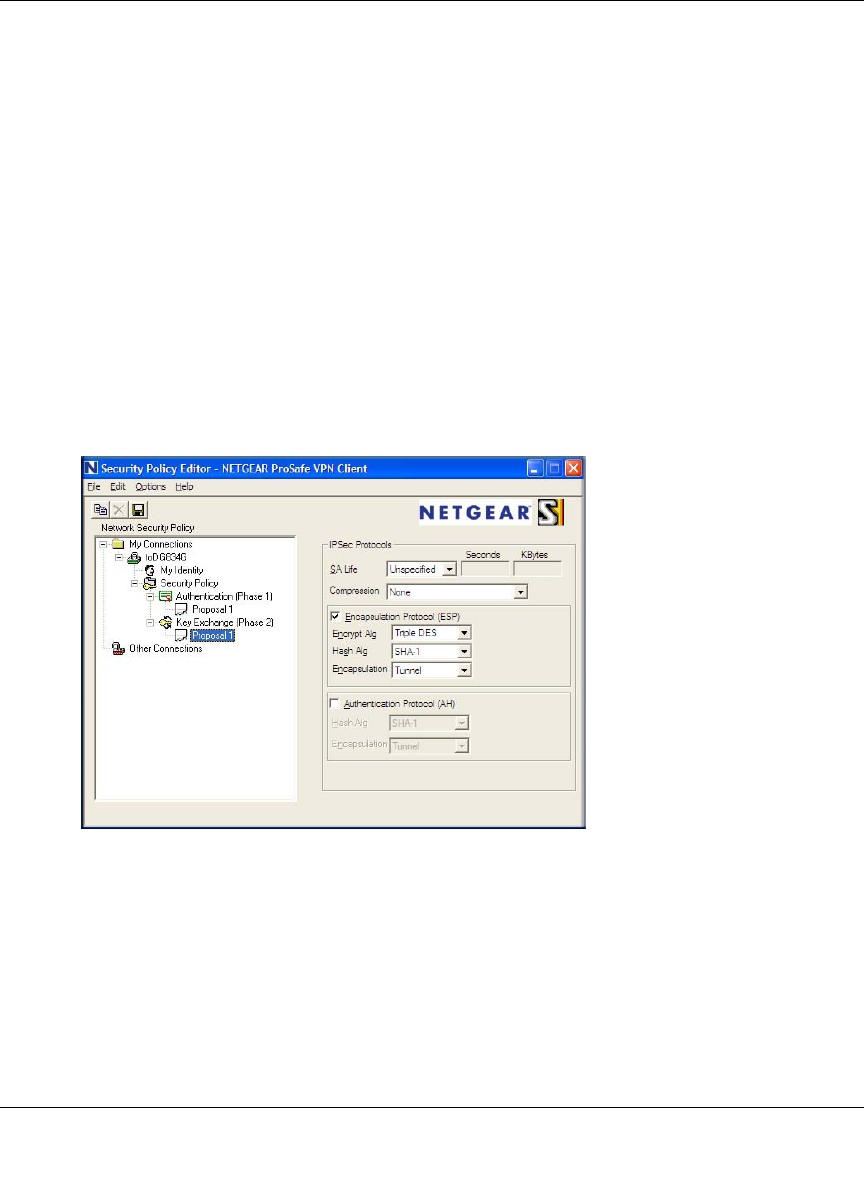
Reference Manual for the ADSL Modem Wireless Router DG834G
Virtual Private Networking 7-17
v1.0, January 2006
c. In the Authentication Method menu, select Pre-Shared key.
d. In the Encrypt Alg menu, select the type of encryption to correspond with what was
configured for the Encryption Protocol in the DG834G v3 in Table 7-3 on page 7-8. In this
example, use Triple DES.
e. In the Hash Alg menu, select SHA-1.
f. In the SA Life menu, select Unspecified.
g. In the Key Group menu, select Diffie-Hellman Group 2.
6. Configure the VPN Client Key Exchange Proposal.
In this step, you will provide the type of encryption (DES or 3DES) to be used for this
connection. This selection must match your selection in the DG834G v3 configuration.
a. Expand the Key Exchange subheading by double clicking its name or clicking on the “+”
symbol. Then select Proposal 1 below Key Exchange.
b. In the SA Life menu, select Unspecified.
c. In the Compression menu, select None.
d. Check the Encapsulation Protocol (ESP) checkbox.
e. In the Encrypt Alg menu, select the type of encryption to correspond with what was
configured for the Encryption Protocol in the DG834G v3 in Table 7-3 on page 7-8. In this
example, use Triple DES.
Figure 7-14

Reference Manual for the ADSL Modem Wireless Router DG834G
7-18 Virtual Private Networking
v1.0, January 2006
f. In the Hash Alg menu, select SHA-1.
g. In the Encapsulation menu, select Tunnel.
h. Leave the Authentication Protocol (AH) checkbox unchecked.
7. Save the VPN Client Settings.
From the File menu at the top of the Security Policy Editor window, select Save.
After you have configured and saved the VPN client information, your PC will automatically
open the VPN connection when you attempt to access any IP addresses in the range of the
remote VPN router’s LAN.
8. Check the VPN Connection.
To check the VPN Connection, you can initiate a request from the remote PC to the DG834G
v3’s network by using the “Connect” option in the NETGEAR ProSafe menu bar. The
NETGEAR ProSafe client will report the results of the attempt to connect. Since the remote
PC has a dynamically assigned WAN IP address, it must initiate the request.
To perform a ping test using our example, start from the remote PC:
a. Establish an Internet connection from the PC.
b. On the Windows taskbar, click the Start button, and then click Run.
c. Type ping -t 192.168.3.1 , and then click OK.
Figure 7-15
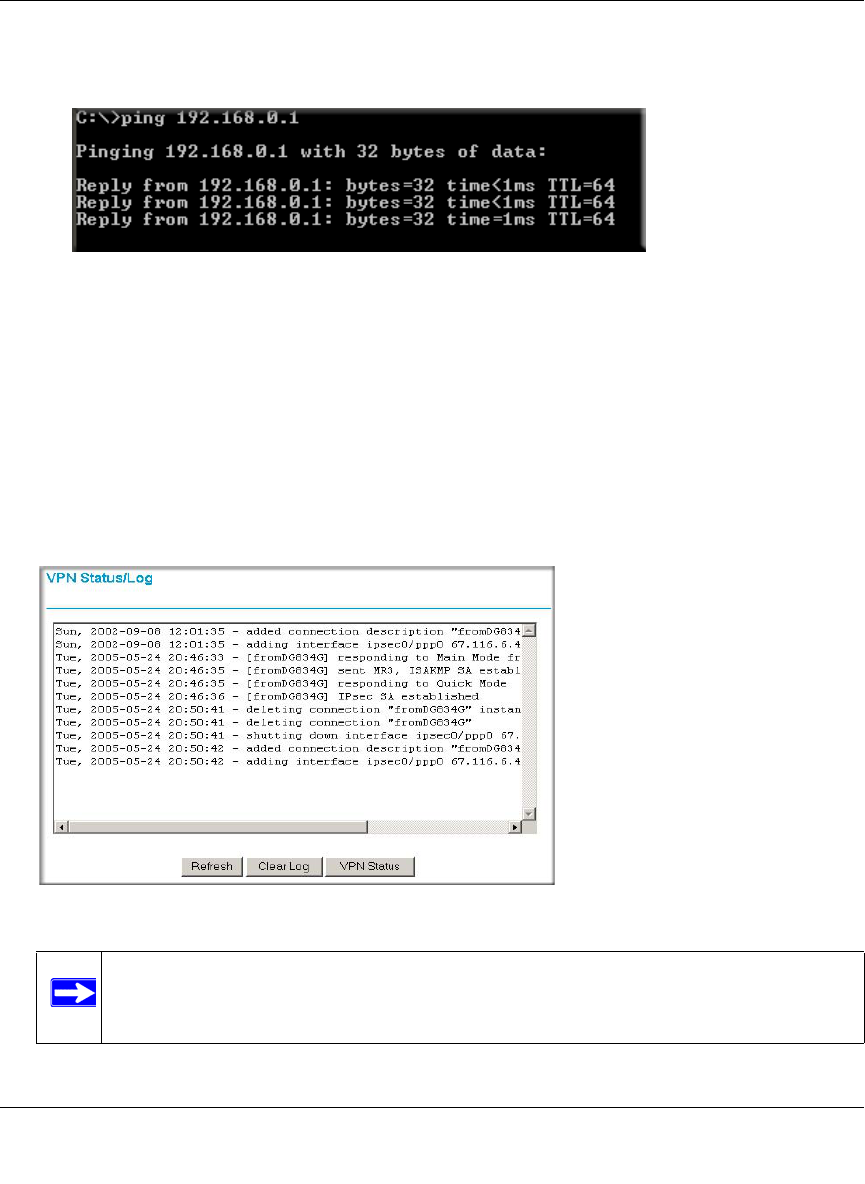
Reference Manual for the ADSL Modem Wireless Router DG834G
Virtual Private Networking 7-19
v1.0, January 2006
This will cause a continuous ping to be sent to the first DG834G v3. After between several
seconds and two minutes, the ping response should change from “timed out” to “reply.”
Once the connection is established, you can open the browser of the PC and enter the LAN IP
address of the remote DG834G v3. After a short wait, you should see the login screen of the
Modem Router (unless another PC already has the DG834G v3 management interface open).
Information on the progress and status of the VPN client connection can be viewed by opening
the NETGEAR ProSafe Log Viewer.
To launch this function, click on the Windows Start button, then select Programs, then
NETGEAR ProSafe VPN Client, then Log Viewer. The Log Viewer screen for a successful
connection is shown below:
Figure 7-16
Figure 7-17
Note: Use the active VPN tunnel information and pings to determine whether a failed
connection is due to the VPN tunnel or some reason outside the VPN tunnel.
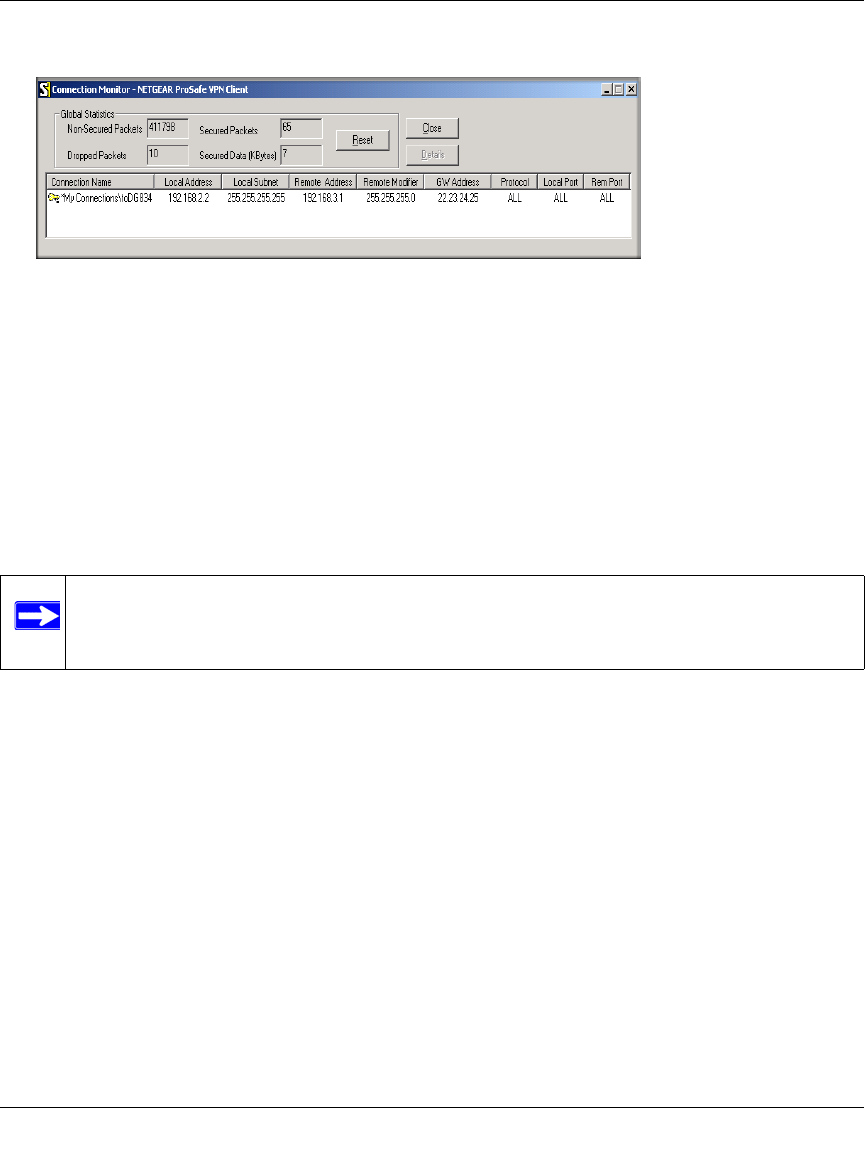
Reference Manual for the ADSL Modem Wireless Router DG834G
7-20 Virtual Private Networking
v1.0, January 2006
9. The Connection Monitor screen for this connection is shown below:
In this example you can see the following:
• The DG834G v3 has a public IP WAN address of 22.23.24.25.
• The DG834G v3 has a LAN IP address of 192.168.3.1.
• The VPN client PC has a dynamically assigned address of 192.168.2.2.
While the connection is being established, the Connection Name field in this menu will say “SA”
before the name of the connection. When the connection is successful, the “SA” will change to the
yellow key symbol shown in the illustration above.
Figure 7-18
Note: While your PC is connected to a remote LAN through a VPN, you might not have
normal Internet access. If this is the case, you will need to close the VPN
connection in order to have normal Internet access.
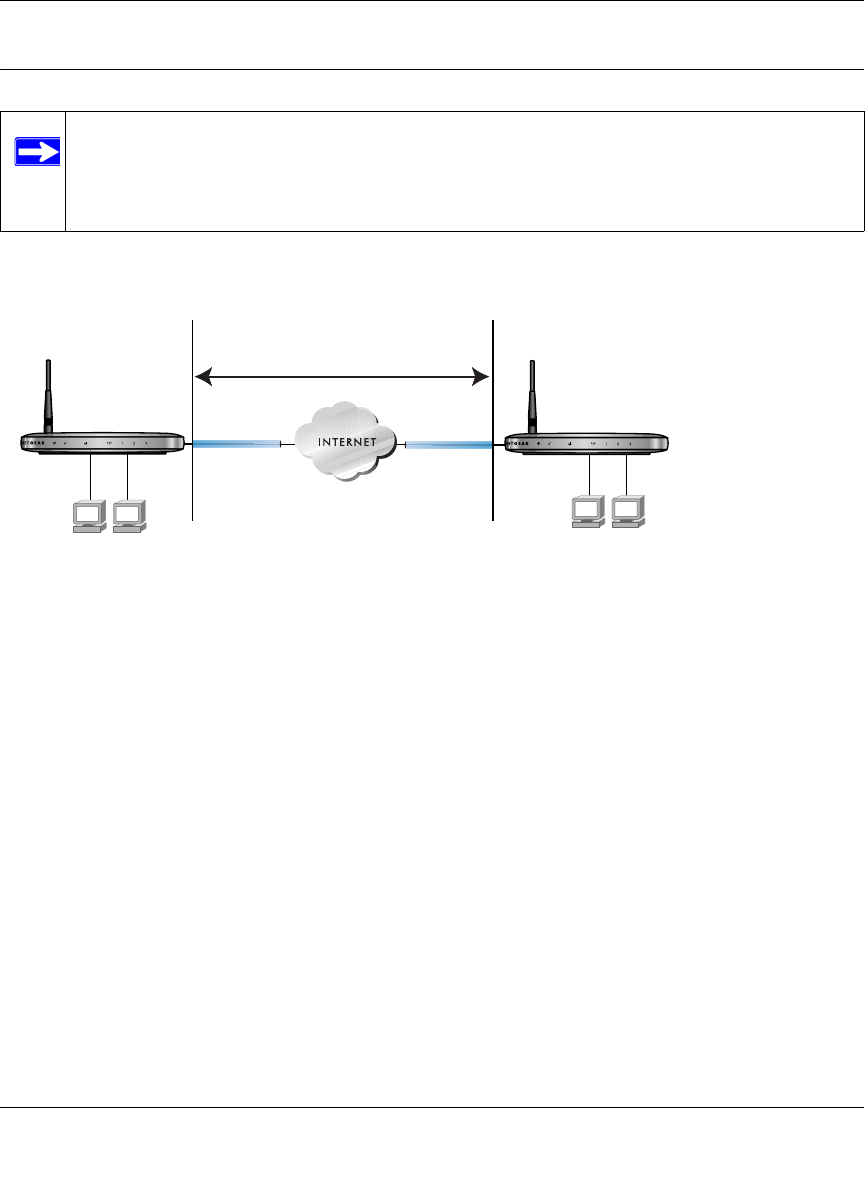
Reference Manual for the ADSL Modem Wireless Router DG834G
Virtual Private Networking 7-21
v1.0, January 2006
How to Set Up a Gateway-to-Gateway VPN Configuration
Follow this procedure to configure a gateway-to-gateway VPN tunnel using the VPN Wizard.
Set the LAN IPs on each DG834G v3 to different subnets and configure each properly for the
Internet. The examples below assume the following settings:
Note: This section uses the VPN Wizard to set up the VPN tunnel using the VPNC
default parameters listed in Table 7-2 on page 7-5. If you have special requirements
not covered by these VPNC-recommended parameters, refer to “How to Set Up
VPN Tunnels in Special Circumstances” on page 7-38 to set up the VPN tunnel.
Figure 7-19
AB
VPN Tunnel
DG834G VPN
Firewall DG834G VPN Firewall
PCs PCs
192.168.0.1 192.168.3.1
14.15.16.17
22.23.24.25

Reference Manual for the ADSL Modem Wireless Router DG834G
7-22 Virtual Private Networking
v1.0, January 2006
Follow this procedure to configure a gateway-to-gateway VPN tunnel using the VPN Wizard.
1. Log in to the DG834G v3 on LAN A at its default LAN address of http://192.168.0.1 with its
default user name of admin and password of password. Click the VPN Wizard link in the
main menu to display this screen. Click Next to proceed.
Table 7-4. VPN Tunnel Configuration Worksheet
Connection Name: GtoG
Pre-Shared Key: 12345678
Secure Association -- Main Mode or Manual Keys: Main
Perfect Forward Secrecy -- Enabled or Disabled: Disabled
NETBIOS -- Enabled or Disabled: Enabled
Encryption Protocol -- DES or 3DES: 3DES
Authentication Protocol -- MD5 or SHA-1: SHA-1
Diffie-Hellman (DH) Group -- Group 1 or Group 2: Group 2
Key Life in seconds: 28800 (8 hours)
IKE Life Time in seconds: 3600 (1 hour)
VPN Endpoint Local IPSec ID LAN IP Address Subnet Mask FQDN or Gateway IP
(WAN IP Address)
DG834G v3_A GW_A 192.168.0.1 255.255.255.0 14.15.16.17
DG834G v3_B GW_B 192.168.3.1 255.255.255.0 22.23.24.25
Note: The LAN IP address ranges of each VPN endpoint must be different. The
connection will fail if both are using the NETGEAR default address range of
192.168.0.x.
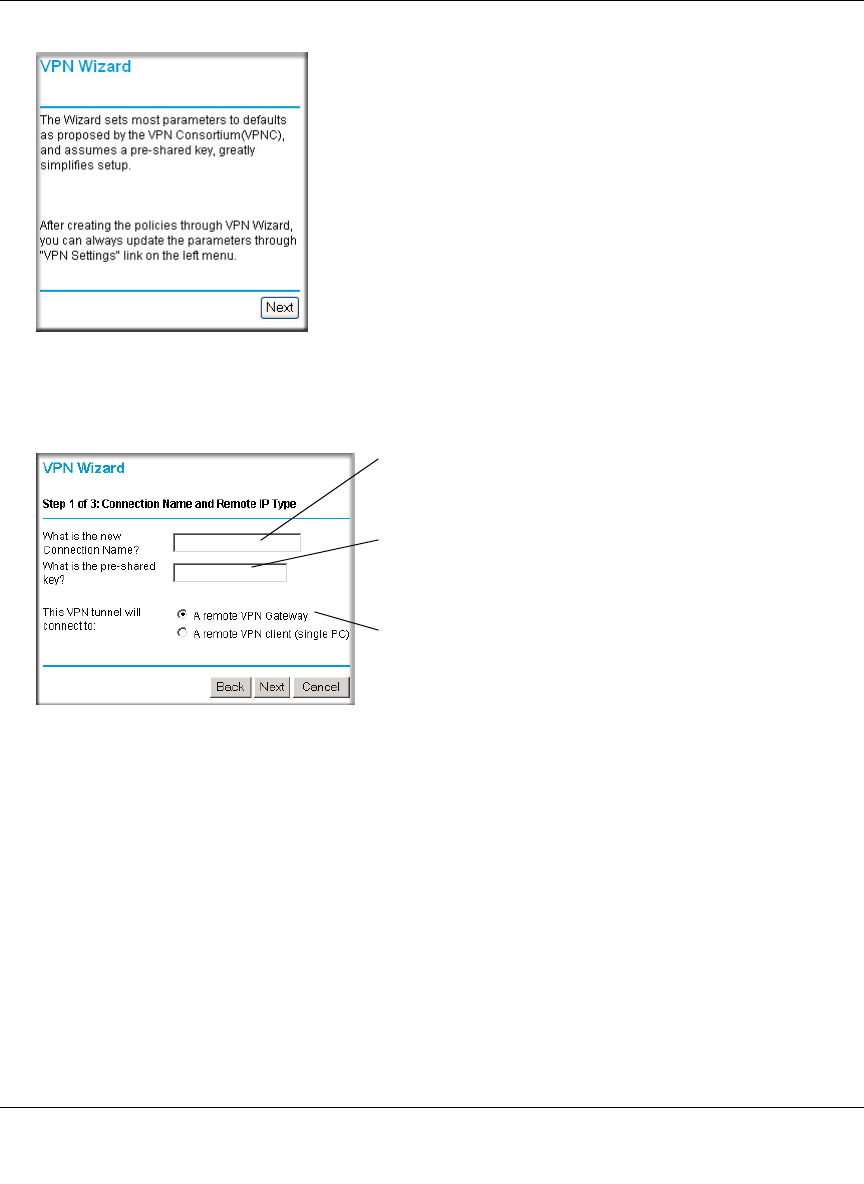
Reference Manual for the ADSL Modem Wireless Router DG834G
Virtual Private Networking 7-23
v1.0, January 2006
2. Fill in the Connection Name and the pre-shared key, select the type of target end point, and
click Next to proceed.
Figure 7-20
Figure 7-21
Enter t
h
e new
C
onnect
i
on Name:
(e.g., GtoG)
Enter the pre-shared key:
(e.g., 12345678)
Select the radio button:
A remote VPN Gateway
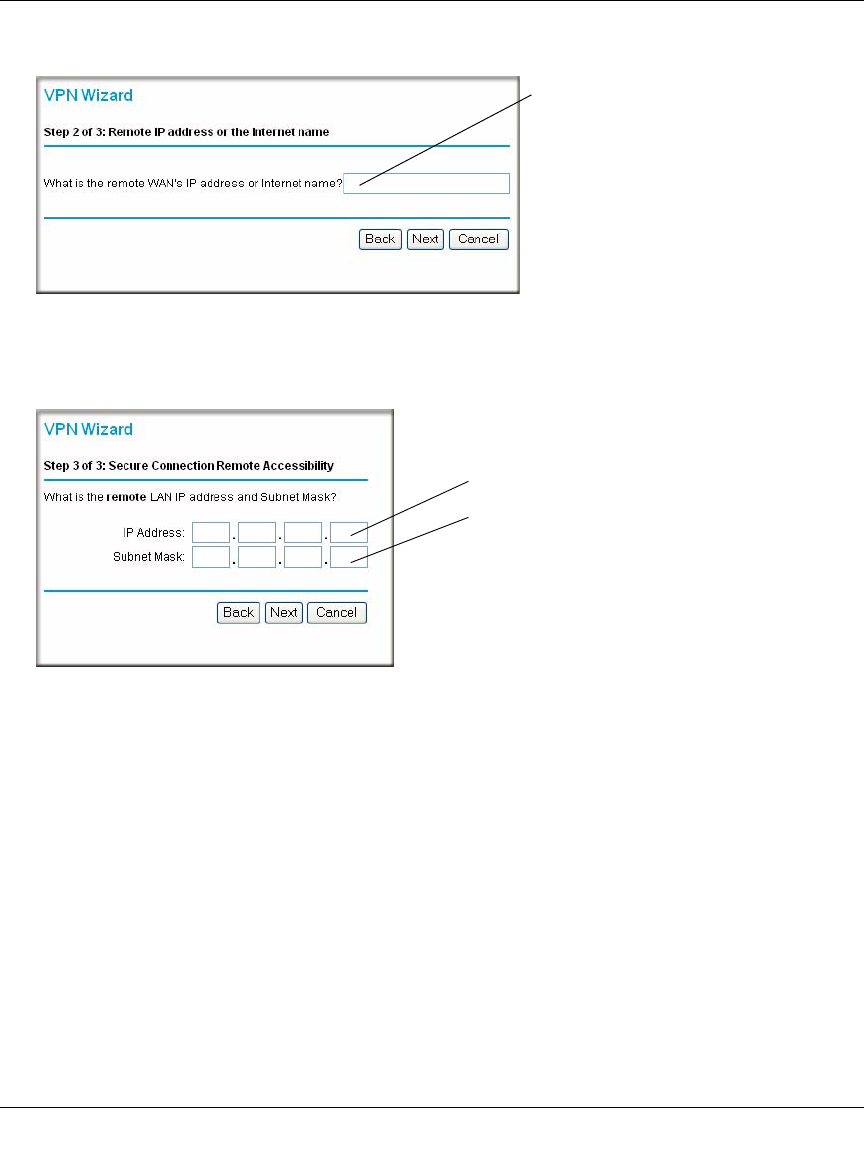
Reference Manual for the ADSL Modem Wireless Router DG834G
7-24 Virtual Private Networking
v1.0, January 2006
3. Fill in the IP Address or FQDN for the target VPN endpoint WAN connection and click Next.
4. Identify the IP addresses at the target endpoint which can use this tunnel, and click Next.
Figure 7-22
Figure 7-23
Enter the WAN IP address of the
remote VPN gateway: (e.g.,
22.23.24.25)
Enter t
h
e L
A
N IP sett
i
ngs o
f
t
h
e remote
VPN gateway:
• IP Address (e.g., 192.168.3.1)
• Subnet Mask (e.g., 255.255.255.0)
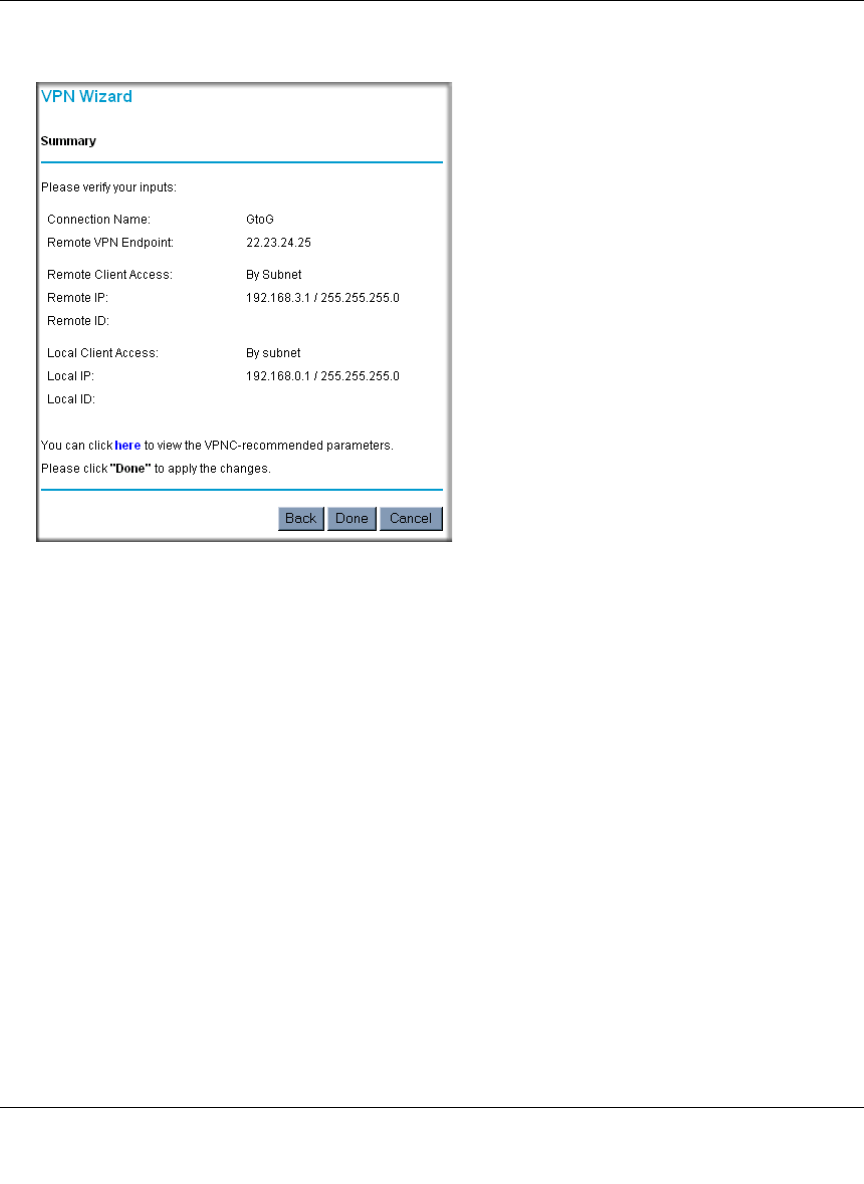
Reference Manual for the ADSL Modem Wireless Router DG834G
Virtual Private Networking 7-25
v1.0, January 2006
The Summary screen below displays.
Figure 7-24
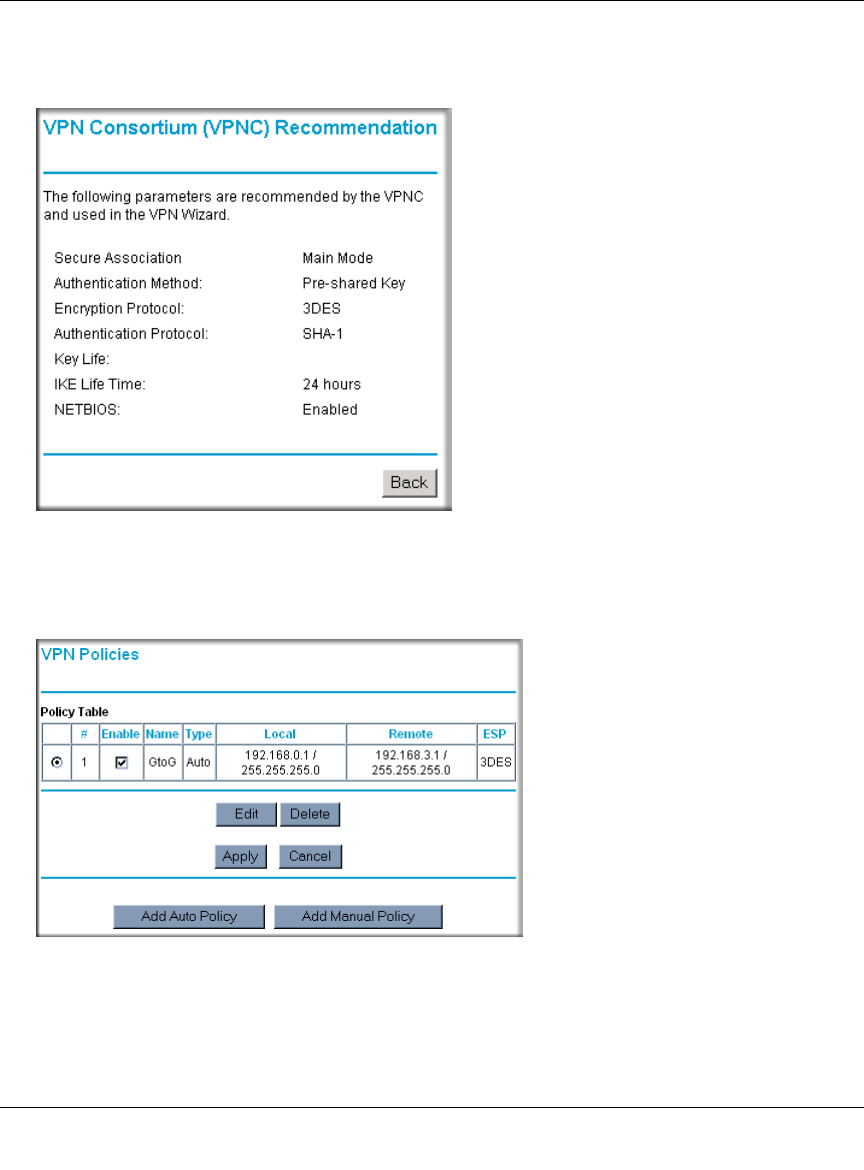
Reference Manual for the ADSL Modem Wireless Router DG834G
7-26 Virtual Private Networking
v1.0, January 2006
To view the VPNC recommended authentication and encryption settings used by the VPN
Wizard, click the “here” link (see Figure 7-24). Click Back to return to the Summary screen.
5. Click Done on the Summary screen (see Figure 7-24) to complete the configuration
procedure. The VPN Settings menu below displays showing that the new tunnel is enabled.
Figure 7-25
Figure 7-26
1 hour
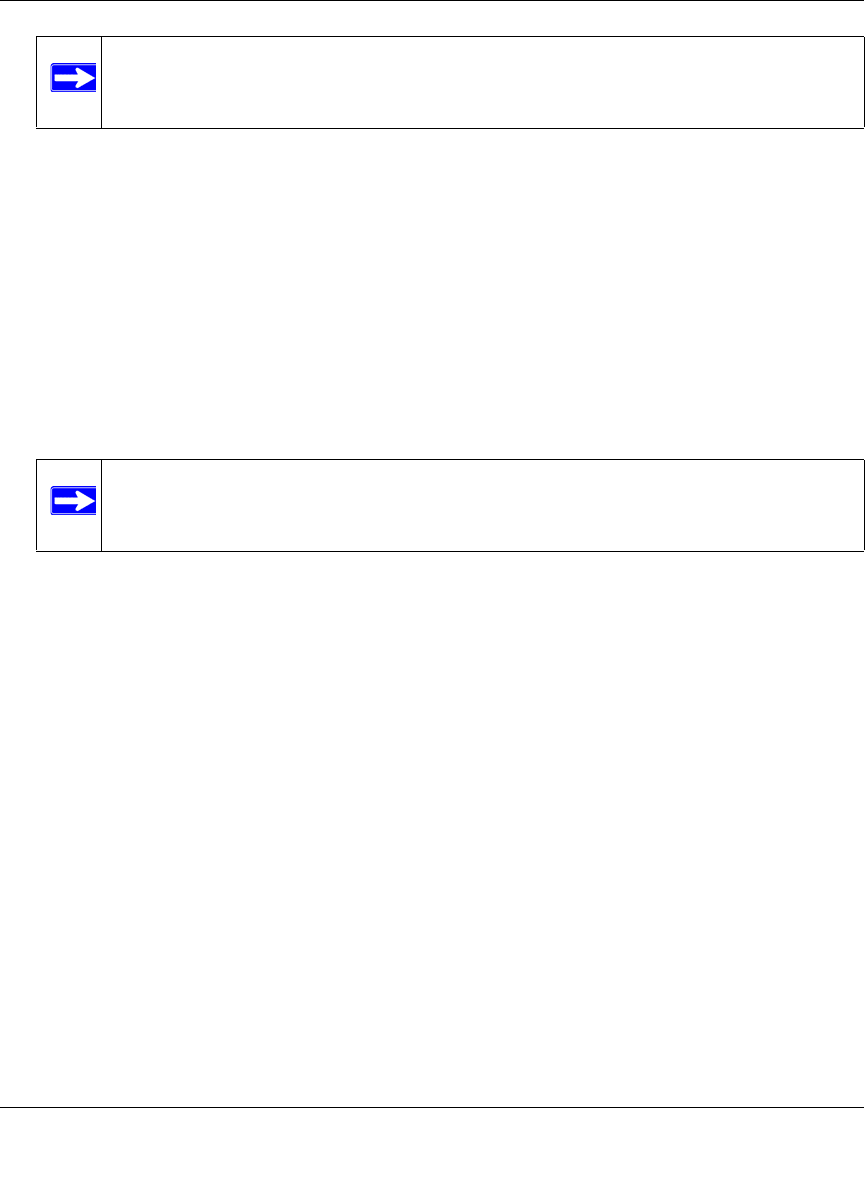
Reference Manual for the ADSL Modem Wireless Router DG834G
Virtual Private Networking 7-27
v1.0, January 2006
6. Repeat for the DG834G v3 on LAN B and pay special attention to use the following network
settings as appropriate.
• WAN IP of the remote VPN gateway (e.g., 14.15.16.17)
• LAN IP settings of the remote VPN gateway:
— IP Address (e.g, 192.168.0.1)
— Subnet Mask (e.g., 255.255.255.0)
— Preshared Key (e.g., 12345678)
7. Use the VPN Status screen to activate the VPN tunnel by performing the following steps:
Note: Refer to “Using Auto Policy to Configure VPN Tunnels” on page 7-38 to
enable the IKE keepalive capability on an existing VPN tunnel.
Note: The VPN Status screen is only one of three ways to active a VPN tunnel. See
“Activating a VPN Tunnel” on page 7-29 for information on the other ways.
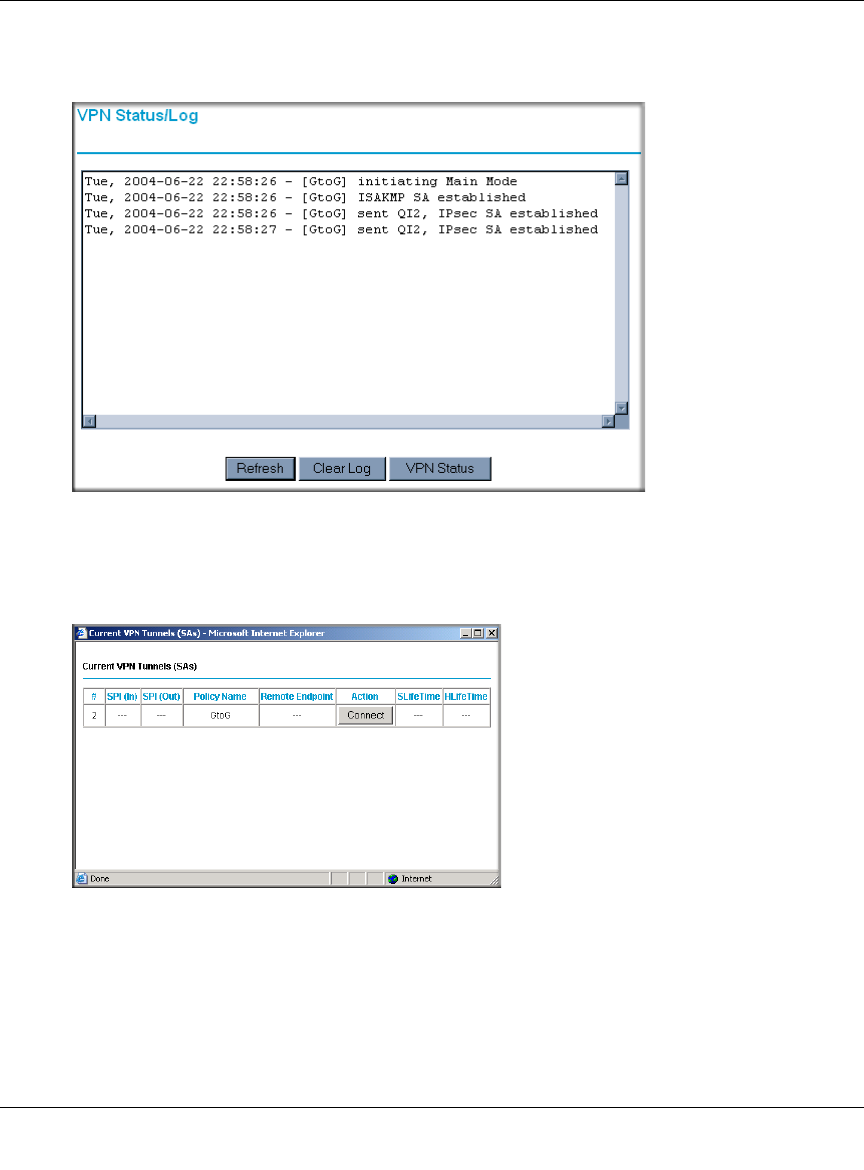
Reference Manual for the ADSL Modem Wireless Router DG834G
7-28 Virtual Private Networking
v1.0, January 2006
a. Open the DG834G v3 management interface and click on VPN Status to get the VPN
Status/Log screen (Figure 7-27).
b. Click on VPN Status (Figure 7-29) to get the Current VPN Tunnels (SAs) screen
(Figure 7-28). Click on Connect for the VPN tunnel you want to activate.
c. Look at the VPN Status/Log screen (Figure 7-27) to verify that the tunnel is connected.
Figure 7-27
Figure 7-28
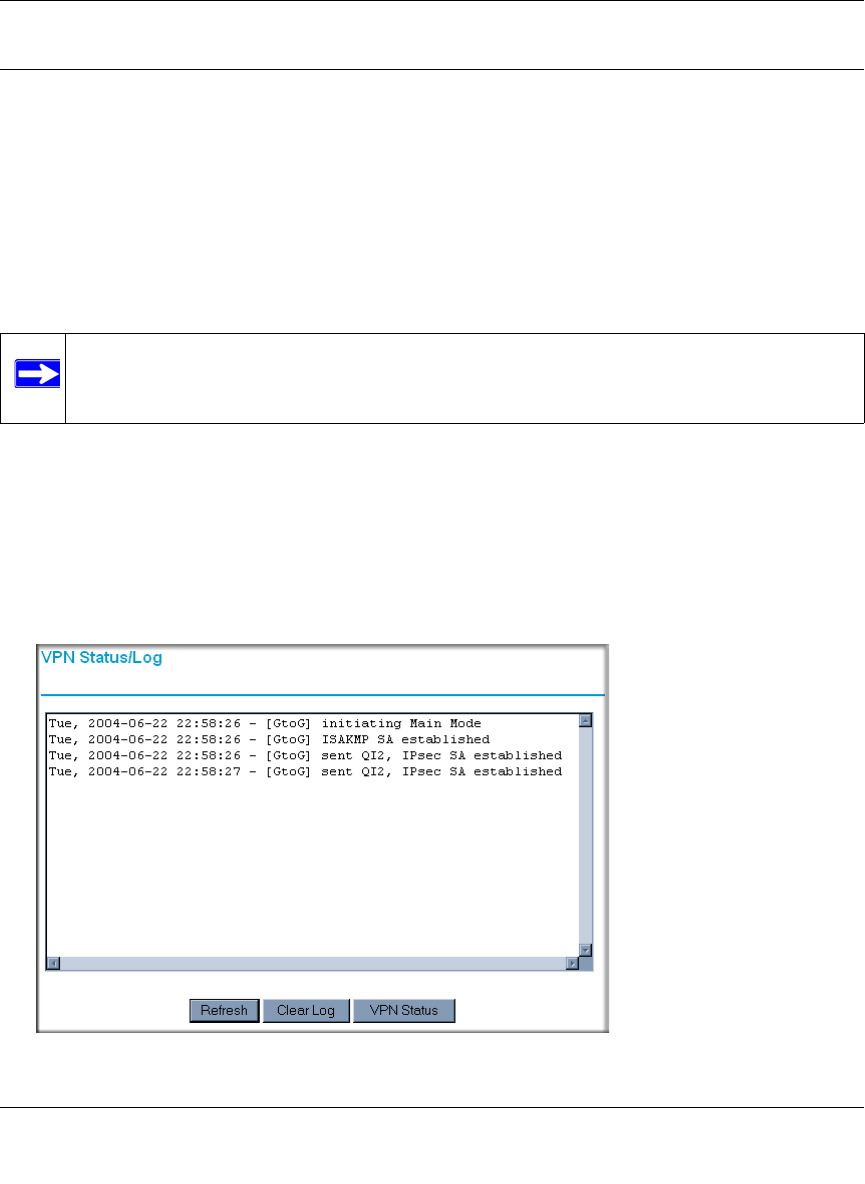
Reference Manual for the ADSL Modem Wireless Router DG834G
Virtual Private Networking 7-29
v1.0, January 2006
VPN Tunnel Control
Activating a VPN Tunnel
There are three ways to activate a VPN tunnel:
• Use the VPN Status page.
• Activate the VPN tunnel by pinging the remote endpoint.
• Start using the VPN tunnel.
Using the VPN Status Page to Activate a VPN Tunnel
To use the VPN Status screen to activate a VPN tunnel, perform the following steps:
1. Log in to the Modem Router.
2. Open the DG834G v3 management interface and click on VPN Status to get the VPN Status/
Log screen (Figure 7-29).
Note: Refer to “Using Auto Policy to Configure VPN Tunnels” on page 7-38 to enable
the IKE keepalive capability on an existing VPN tunnel.
Figure 7-29
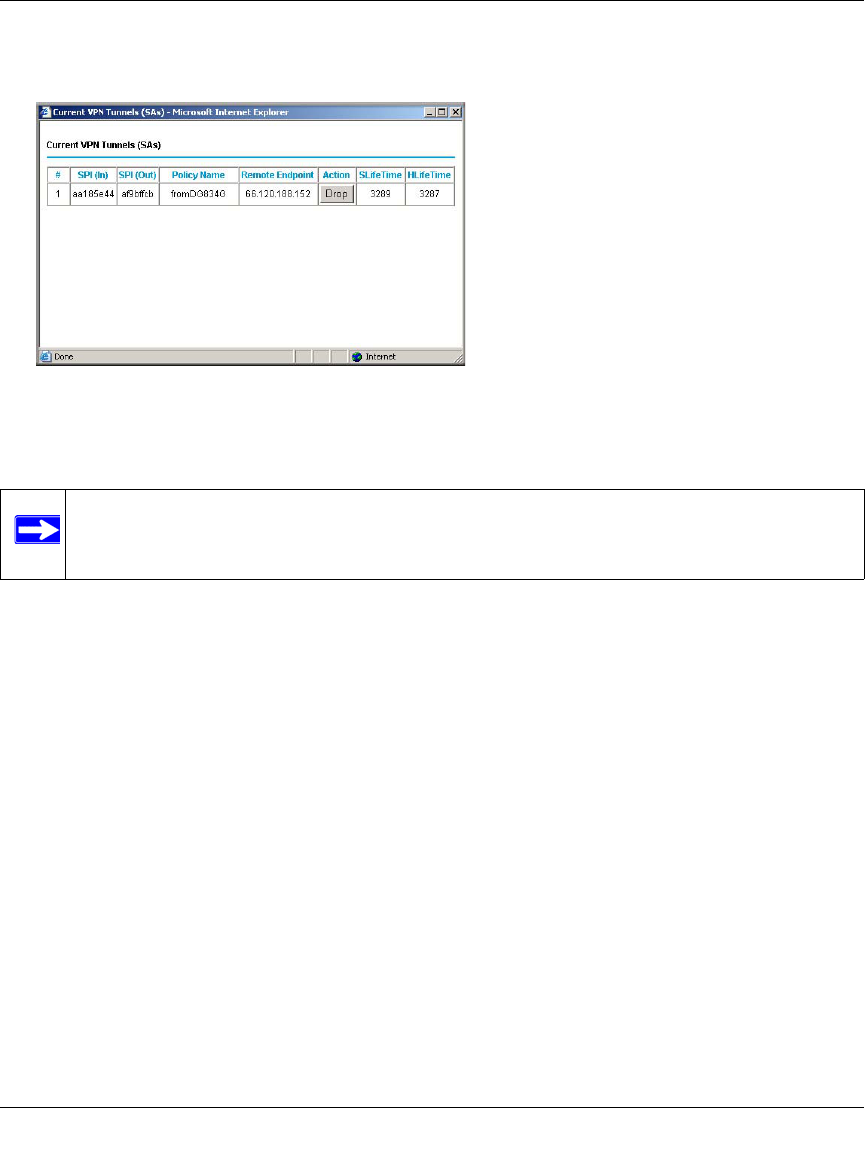
Reference Manual for the ADSL Modem Wireless Router DG834G
7-30 Virtual Private Networking
v1.0, January 2006
3. Click on VPN Status (Figure 7-29) to get the Current VPN Tunnels (SAs) screen
(Figure 7-30). Click on Connect for the VPN tunnel you want to activate.
Activate the VPN Tunnel by Pinging the Remote Endpoint
To activate the VPN tunnel by pinging the remote endpoint (e.g., 192.168.3.1), do the following
steps depending on whether your configuration is client-to-gateway or gateway-to-gateway:
•Client-to-Gateway Configuration—to check the VPN Connection, you can initiate a request
from the remote PC to the DG834G v3’s network by using the “Connect” option in the
NETGEAR ProSafe menu bar. The NETGEAR ProSafe client will report the results of the
attempt to connect. Since the remote PC has a dynamically assigned WAN IP address, it must
initiate the request.
To perform a ping test using our example, start from the remote PC:
a. Establish an Internet connection from the PC.
b. On the Windows taskbar, click the Start button, and then click Run.
c. Type ping -t 192.168.3.1 and then click OK.
Figure 7-30
Note: This section uses 192.168.3.1 for an example remote endpoint LAN IP address.
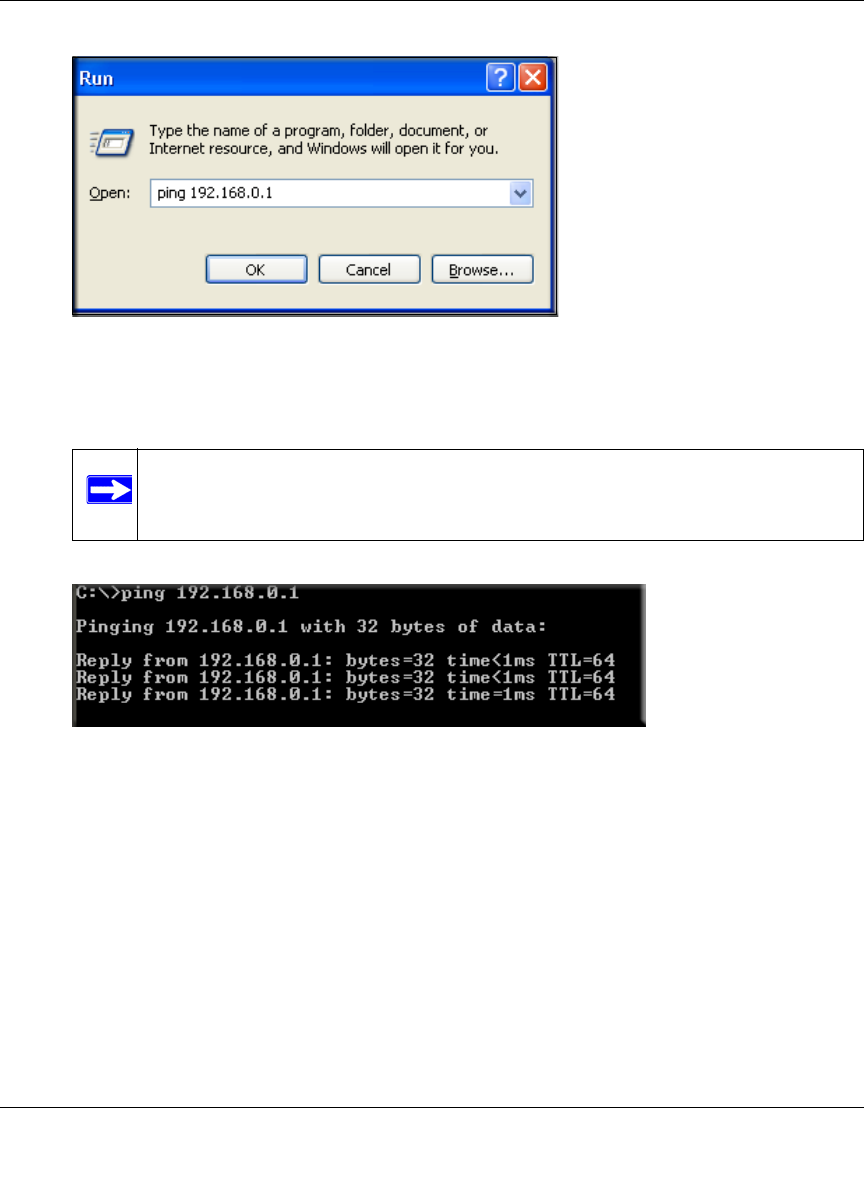
Reference Manual for the ADSL Modem Wireless Router DG834G
Virtual Private Networking 7-31
v1.0, January 2006
Figure 7-31: Running a Ping test to the LAN from the PC
This will cause a continuous ping to be sent to the first DG834G v3. After between several
seconds and two minutes, the ping response should change from “timed out” to “reply.”
Once the connection is established, you can open the browser of the PC and enter the LAN IP
address of the remote DG834G v3. After a short wait, you should see the login screen of the
Modem Router (unless another PC already has the DG834G v3 management interface open).
•Gateway-to-Gateway Configuration—test the VPN tunnel by pinging the remote network
from a PC attached to the DG834G v3.
a. Open command prompt (i.e., Start -> Run -> cmd).
Note: Use Ctrl-C to stop the pinging.
Figure 7-32
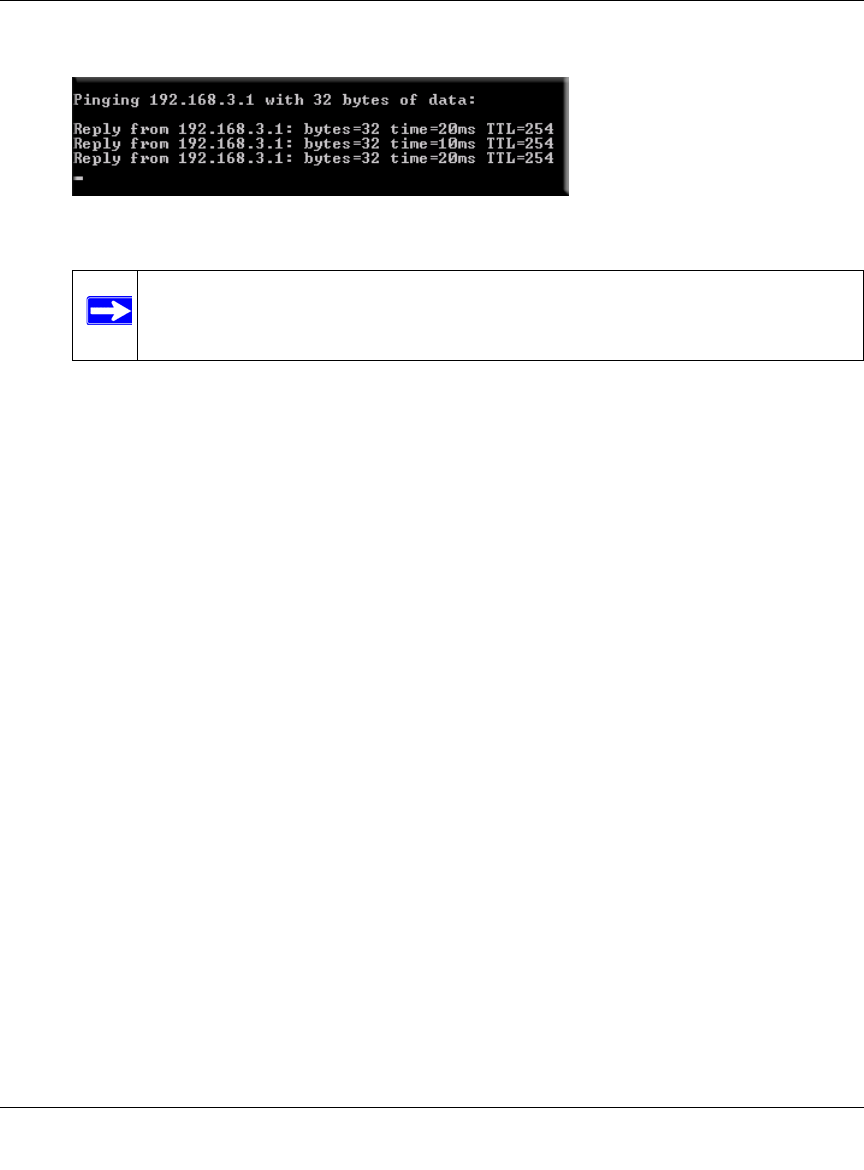
Reference Manual for the ADSL Modem Wireless Router DG834G
7-32 Virtual Private Networking
v1.0, January 2006
b. ping 192.168.3.1.
Start Using a VPN Tunnel to Activate It
To use a VPN tunnel, use a Web browser to go to a URL whose IP address or range is covered by
the policy for that VPN tunnel.
Figure 7-33
Note: The pings may fail the first time. If so, then try the pings a second time.
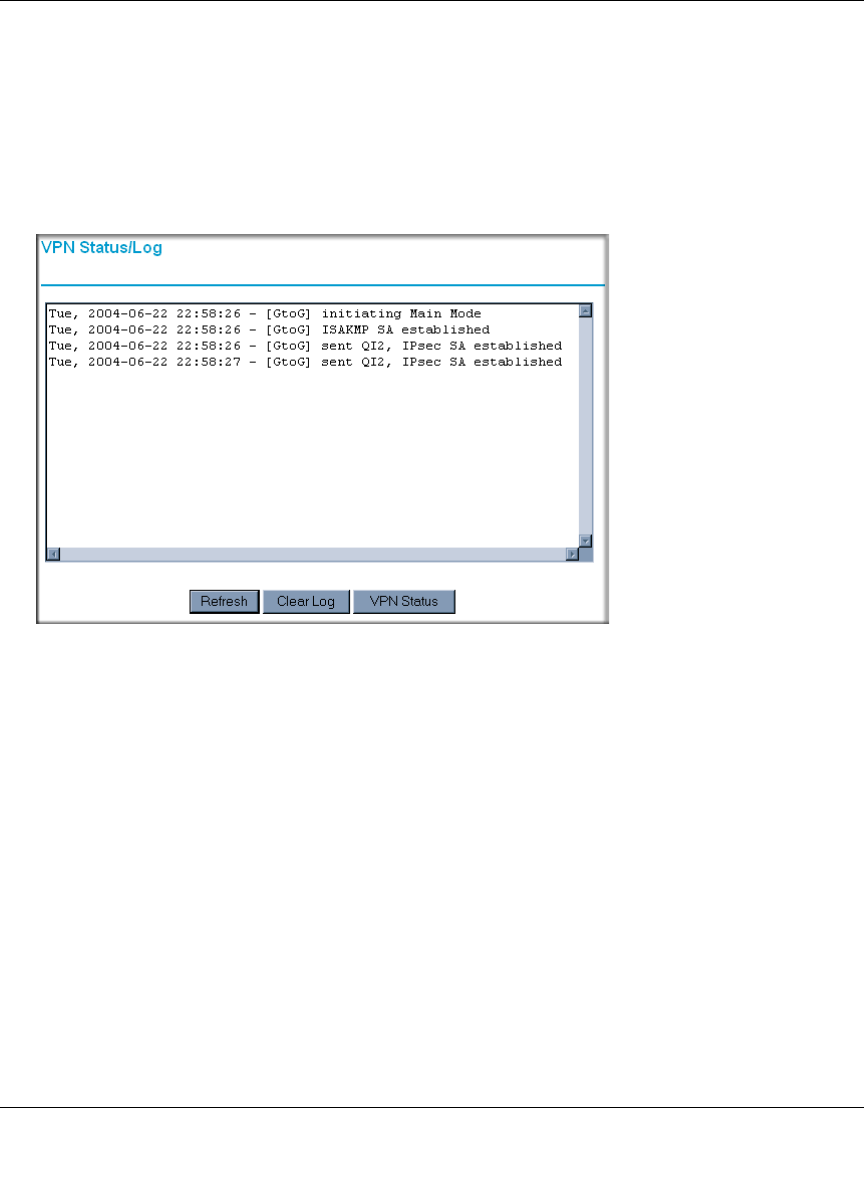
Reference Manual for the ADSL Modem Wireless Router DG834G
Virtual Private Networking 7-33
v1.0, January 2006
Verifying the Status of a VPN Tunnel
To use the VPN Status page to determine the status of a VPN tunnel, perform the following steps:
1. Log in to the Modem Router.
2. Open the DG834G v3 management interface and click on VPN Status to get the VPN Status/
Log screen (Figure 7-34).
Log—this log shows the details of recent VPN activity, including the building of the VPN
tunnel. If there is a problem with the VPN tunnel, refer to the log for information about what
might be the cause of the problem.
• Click Refresh to see the most recent entries.
• Click Clear Log to delete all log entries.
Figure 7-34
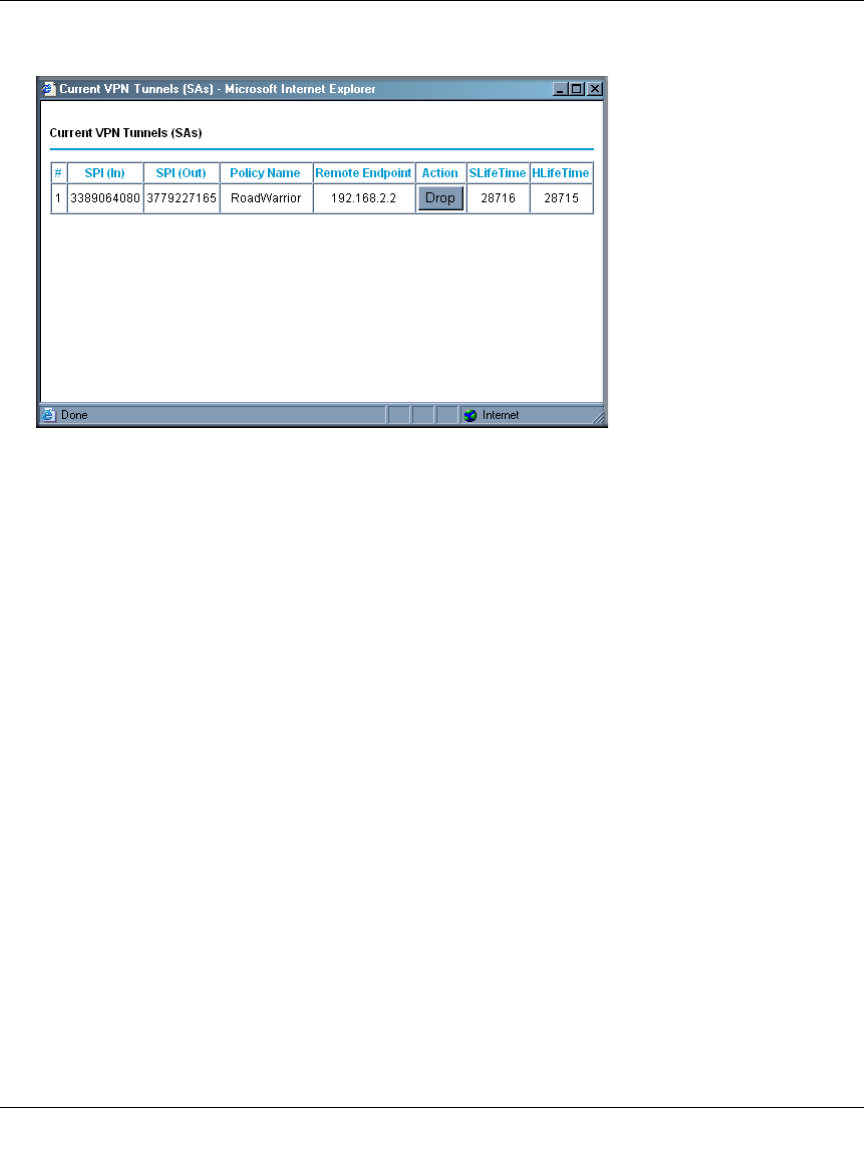
Reference Manual for the ADSL Modem Wireless Router DG834G
7-34 Virtual Private Networking
v1.0, January 2006
3. Click on VPN Status (Figure 7-29) to get the Current VPN Tunnels (SAs) screen.
This table lists the following data for each active VPN Tunnel.
•SPI—each SA has a unique SPI (Security Parameter Index) for traffic in each direction.
For "Manual" key exchange, the SPI is specified in the Policy definition. For "Automatic"
key exchange, the SPI is generated by the IKE protocol.
•Policy Name—the name of the VPN policy associated with this SA.
•Remote Endpoint—the IP address on the remote VPN Endpoint.
•Action—the action will be either a "Drop" or a "Connect" button.
•SLifeTime (Secs)—the remaining Soft Lifetime for this SA in seconds. When the Soft
Lifetime becomes zero, the SA (Security Association) will re-negotiated.
•HLifeTime (Secs)—the remaining Hard Lifetime for this SA in seconds. When the Hard
Lifetime becomes zero, the SA (Security Association) will be terminated. (It will be re-
established if required.)
Figure 7-35
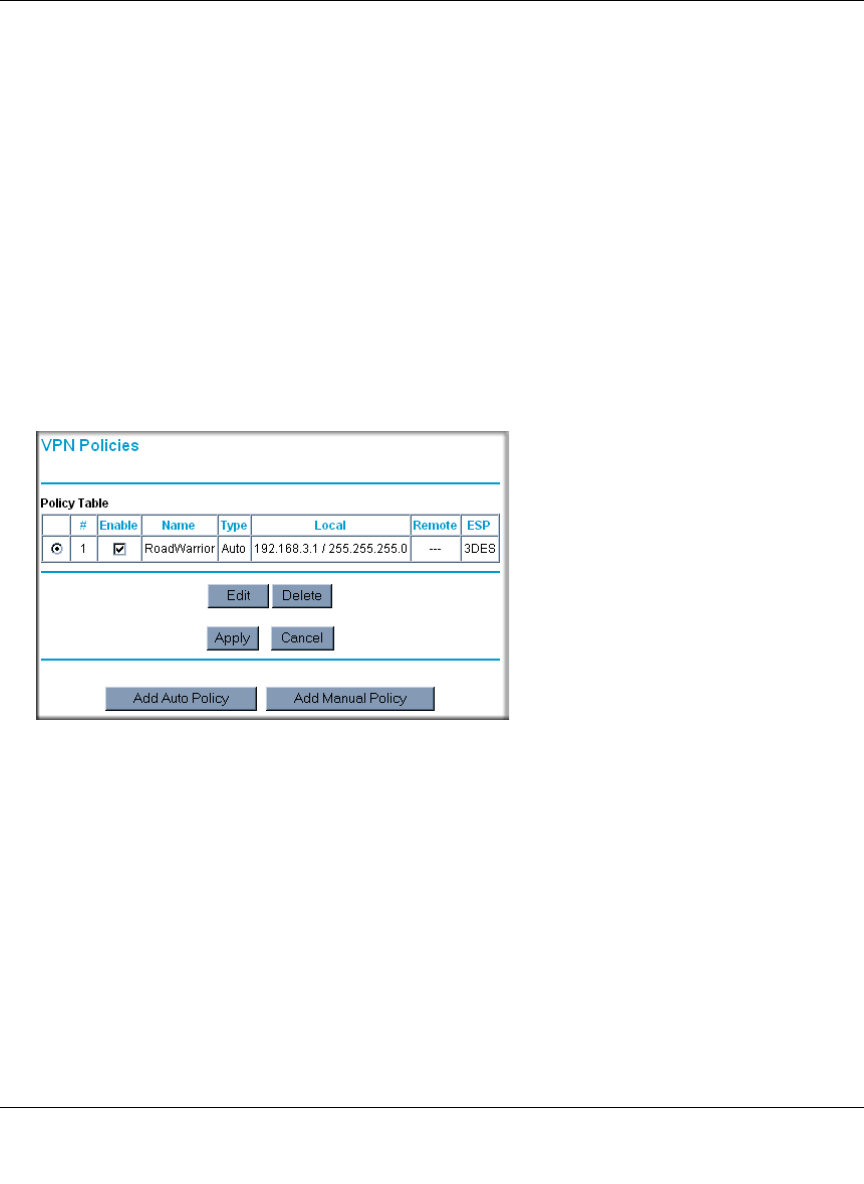
Reference Manual for the ADSL Modem Wireless Router DG834G
Virtual Private Networking 7-35
v1.0, January 2006
Deactivating a VPN Tunnel
Sometimes a VPN tunnel must be deactivated for testing purposes. There are two ways to
deactivate a VPN tunnel:
• Policy table on VPN Policies page
• VPN Status page
Using the Policy Table on the VPN Policies Page to Deactivate a VPN Tunnel
To use the VPN Policies page to deactivate a VPN tunnel, perform the following steps:
1. Log in to the Modem Router.
2. Open the DG834G v3 management interface and click on VPN Policies to get the VPN
Policies screen (Figure 7-36).
3. Clear the Enable check box for the VPN tunnel you want to deactivate and click Apply. (To
reactivate the tunnel, check the Enable box and click Apply.)
Using the VPN Status Page to Deactivate a VPN Tunnel
To use the VPN Status page to deactivate a VPN tunnel, perform the following steps:
1. Log in to the Modem Router.
Figure 7-36
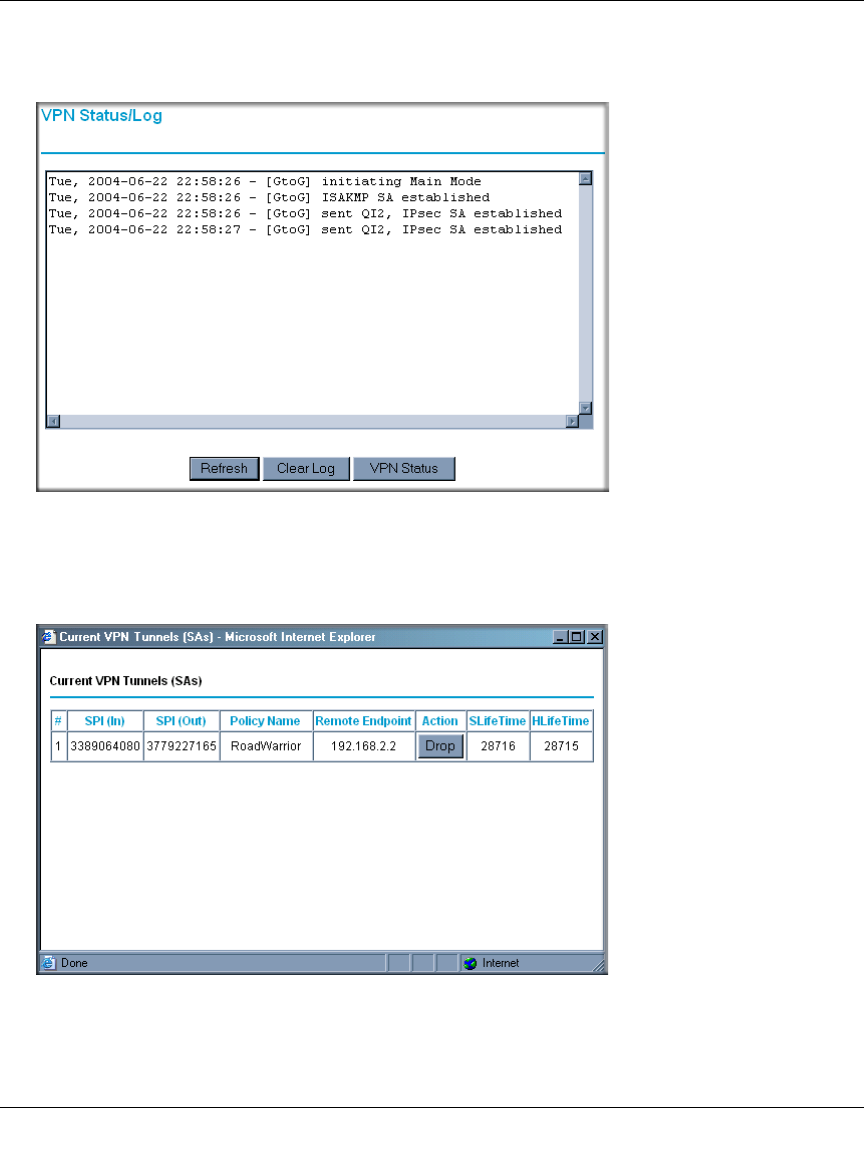
Reference Manual for the ADSL Modem Wireless Router DG834G
7-36 Virtual Private Networking
v1.0, January 2006
2. Open the DG834G v3 management interface and click on VPN Status to get the VPN Status/
Log screen (Figure 7-37).
3. Click VPN Status (Figure 7-37) to get the Current VPN Tunnels (SAs) screen (Figure 7-38).
Click Drop for the VPN tunnel you want to deactivate.
Figure 7-37
Figure 7-38